Friday, April 26, 2024
Volume LV, Issue 27 Est. 1969

Friday, April 26, 2024
Volume LV, Issue 27 Est. 1969
Zachary Treseler News Editor Western Reserve University President John Schoff Millis (left) and Case Institute of Technology President Robert W. Morse’s (right) schools were federated, creating CWRU. Courtesy of the CWRU Archives
The last week of the semester is known amongst the Case Western Reserve University community as Legacy Week, a time to look back on the history of CWRU to inform its future. Anyone who has looked at the full name of CWRU, a fourword behemoth, might ask how this institution came to acquire such a long name.
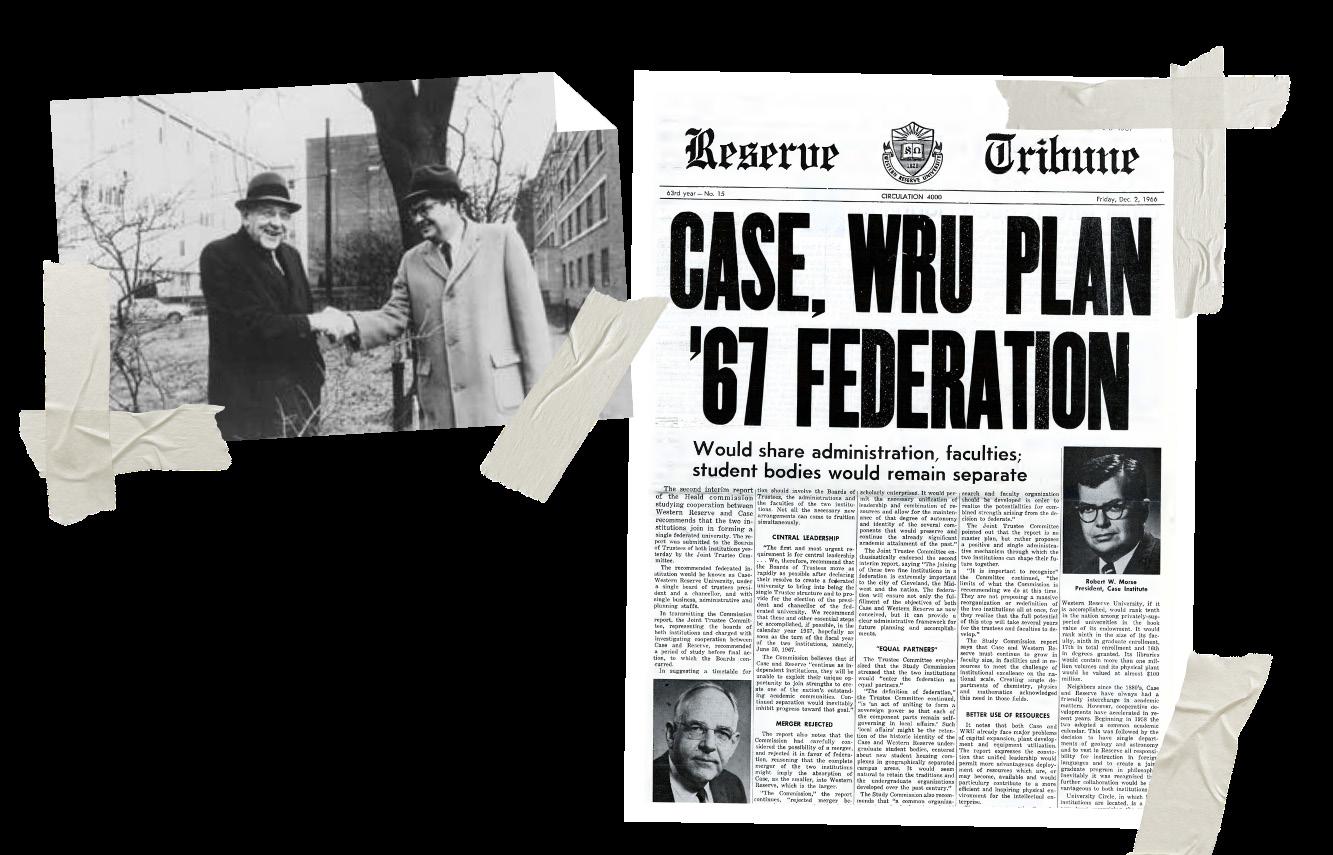
The Federation was a result of the slow integration of two separate universities: Western Reserve University (WRU) and the Case Institute of Technology (CIT). While this process has roots dating back to the 1880s, it occurred in the summer of 1967, resulting in CWRU.
Janice Gerda, associate vice president for student affairs and CWRU’s in-house historian, noted the significance of the federation, saying, “We are simultaneously almost 200 years old and not yet quite 60. I think today we still see the way that CWRU sub-units build strong and innovative communi-
ties within the whole, balancing autonomy and innovation in one part of the university with the core mission and direction of the larger whole that binds us together.”
This is uniquely different from an all-out merger. The report that started the push for the federation, known colloquially as the Heald 2 Report, “rejected merger because it concluded that it should find a more creative pattern that would encourage imaginative efforts to preserve the important values, the historic traditions, the strengths and the potentialities for contribution not only of the Case Institute of Technology but also of the several component parts of Western Reserve University.”
As a result, when it was announced it was still a large deal.
The Reserve Tribune, WRU’s student newspaper, ran the headline “CWRU, WRU PLAN ’67 FEDERATION.”
At the time, students’ reactions varied dramatically because the Heald Commission only involved leaders from CIT and WRU, with no students.
Institute of Technology and Western Reserve University federation, pointing to the merge resulting in a better use of resources while retaining an equal partnership.
Courtesy of the CWRU Archives
The federation was not predestined, but it was far from unexpected. Since 1888, both schools had occupied neighboring plots of land, and by the time the Heald 2 Commission started, the biology, physics, chemistry and math departments were already being merged between the two schools.
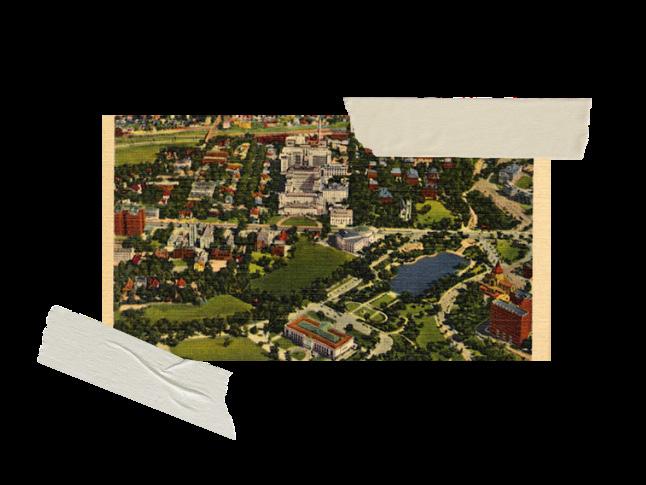
“In retrospect, the Federation might seem inevitable—two strong and complementary institutions separated only by a fence, working together in many ways even as they were rivals in student life,” Gerda said. She draws on an 1882 speech at the opening of Adelbert Hall that encouraged WRU to work closely with other educational institutions, including the one a few yards away.
“But I also know that coming together in 1967 was organizationally traumatic at the time, and forced deep introspection about purpose and what was important,” Gerda said about the long-run effects of the federation.
The process was far from smooth. In October of 1967, the Reserve Home Concert was held in the Emerson Gymnasium—today part of the Veale Center. However, the head of CIT’s “physical depart-
ment” restricted gym usage, claiming that Philip Heim’s responsibility was to CIT undergrads, not those from the now-federated institution. The Tribune then asked, “Why should those 2,500 students be deprived of the only concert facilities on the campuses because activities for the Case student discontinued for their weekend?”
An opinion column from The Case Tech, CIT’s student newspaper, called CWRU’s Blue “magnificently unsatisfactory.” This led one opinion writer in the Tribune to note that the Tech “are in reality out to sabotage the Federation.”
This is not to say all students from CIT were against the federation. In December 1967, an opinion column in the Tech noted that “a large number of students paraded onto the campus and proceded to stage a filthy exhibition of stupidity. They carried signs smeared with smut, cursed, taunted Case students, and made a general nuisance themselves.”
This all took place during the Vietnam War.
Continue reading on page 3
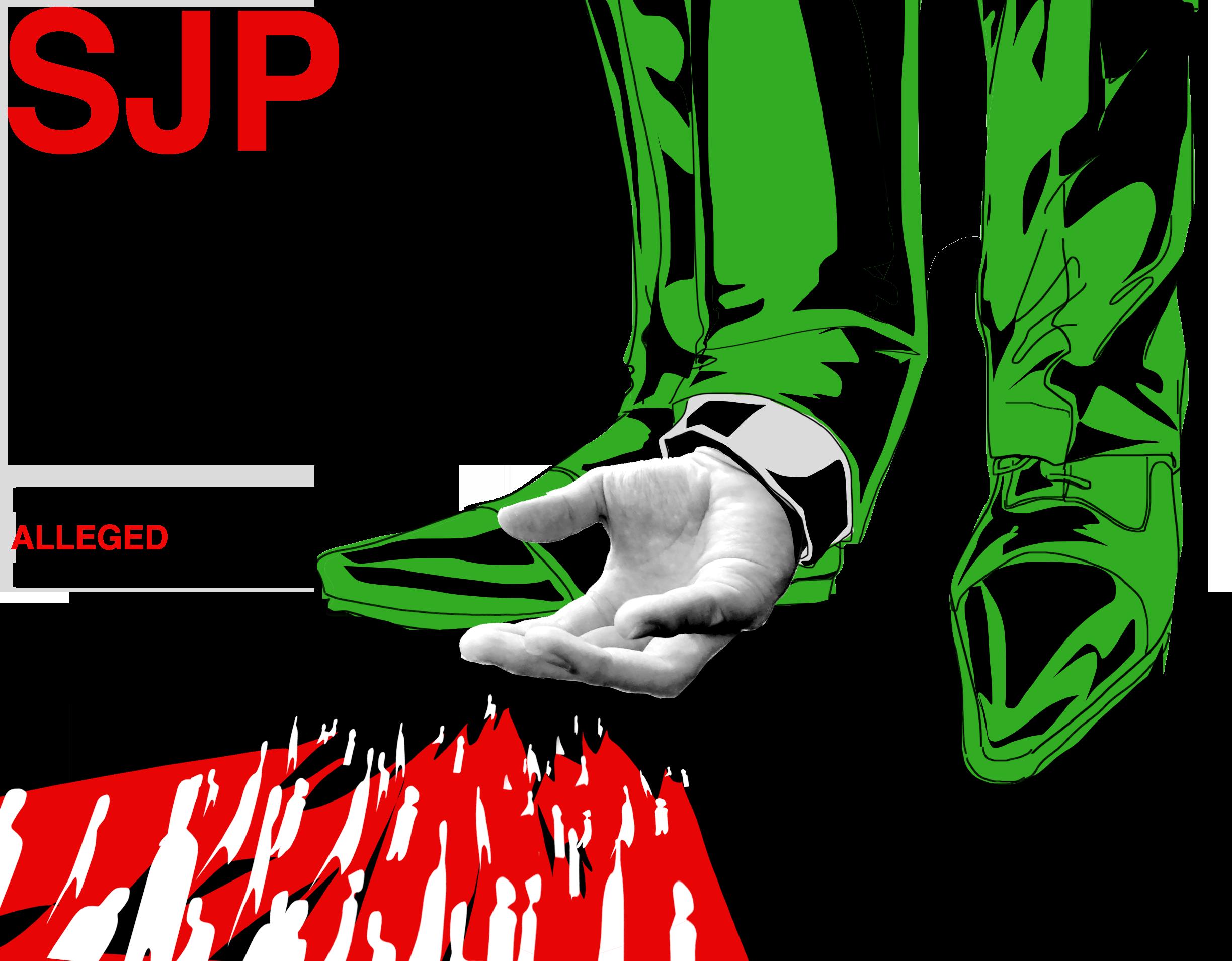
2023 and then beyond. We do however prefer to keep our legal team anonymous at this time at the discretion of our organization but we are immensely grateful for the guidance they have provided us with pro-bono.”
It’s been over a month since Case Western Reserve University’s Students for Justice in Palestine (SJP) chapter was suspended by the Office of Student Conduct. At the time, many students were curious about what the administration’s next steps would be. Their curiosity was answered in an April 19 Instagram post when SJP said that CWRU imposed fines on individuals for violating the Posting Policy.
Original reporting on the potential consequences of SJP’s supposed actions came about at the March 5 Undergraduate Student Government (USG) open Executive Meeting. One attendee stated that the administration is “Basically lawyering up against 20-year-olds since last semester thinking that it wouldn’t be reciprocated. SJP does have a lawyer team, but, as college students also in debt, having to use lawyers into this to go against our administration shows that the process isn’t really fair.”
In comments to The Observer, anonymous members of SJP said, “we do have legal counsel that has communicated with the university on our behalf on several different occasions.”
SJP members said, “as a result of the heavy-handed reactions of the university following the protest our club organized on November 6th,
They continued regarding the reasons as to pursuing a legal team was because “We felt like we were being targeted and this is the only way we can ensure our safety was by having a legal team. During meetings, the presence of CWRU’s legal counsel loomed, casting a shadow of authority and legal prowess.”
“These attacks [from the administration] have caused waves of stress and anxiety, especially as students given we were in the midst of our midterms when the suspension was unexpectedly imposed on us,” their members said when asked how these legalistic attacks are being treated.
In response to a question about whether students should expect the Office of Student Conduct to implement stricter enforcement of its Posting Policy as seen with SJP, they responded, “We have been and will continue to be consistent in the application of our policies.”
According to the policy, prohibited areas include “All academic and administrative buildings and restricted surfaces in residential facilities (including windows, doors, columns, classroom chalkboards/Write-On Board, etc.).”
However, many students, both in and outside of SJP, claim the statement is simply untrue. Fourth-year student and organizer of the Divorce Pact Cameron Celebuski gave a presentation about the Posting Policy
and previous enforcement of the Posting Policy just after the March 5 USG meeting adjourned.
His presentation argued that SJP did not violate the Posting Policy, and if they did, the university is unfairly targeting SJP by detailing how other student groups have also violated the same posting policy that SJP is accused of while not suffering any consequences. He said, “I just hope they got [the message that] the school was being really hypocritical like starting with SJP, and then none of the other clubs.”
Regarding his presentation, Celebuski said, “everyone seemed really supportive. And I still don’t know what admins think about it. I don’t know if they’ve seen it. Hopefully, they do.”
On April 18, SJP said that the Office of Student Conduct had fined members a total of over $2,600 for the violations of the Posting Policy. They said the fees were distributed based on the amount of students fined, with upwards of 12 months of disciplinary probation also imposed.
SJP said that they are working with the Cleveland Chapter of the Council on American-Islamic Relations, Ohio (CAIR-Ohio) through this process. CAIR-Ohio has not responded to requests for comment.
In SJP’s Instagram post, which has yet to be independently verified by The Observer, they say that the university claims that SJP’s actions have cost the university $2,619.22 in staffing and materials costs. For each individual, they are seeking individuals to pay between one-quarter and oneeleventh of the cost.
When asked to comment, the university said, “Due to the Family Educational Rights and Privacy Act (FERPA), the university doesn’t comment on student conduct issues. For all student organizations, the university follows its student judicial policies and procedures and applies these uniformly and fairly across groups.”
This update was met with outrage; the Instagram post in question received over 20,000 likes.
“I was always proud to be a CWRU grad. Can’t say that anymore!!!” said one comment under the Instagram post. Another simply wrote, “thank god i didn’t apply here.” The Arab American Anti-Discrimination Committee offered to help cover the fines, while other Instagram users asked about a GoFundMe page.
Repercussions for SJP are not unheard of when viewed in the national context.
The University of Southern California recently canceled its valedictorian’s commencement speech citing security issues, which has faced large-scale backlash from students around the nation. Columbia University recently arrested 108 people for creating a protest encampment on their campus, which has resulted in a faculty walkout and worldwide media attention, with reports of a larger community protest that followed.
While the actions of the CWRU administration are not the most drastic in the country, nor are they attracting media attention beyond a few local newspapers, they have had an indelible impact on the CWRU community that will continue to be felt as the Israel-Hamas war persists.
With the merging of two institutions came the merging of the two university’s newspapers. The original plan was for the two papers to merge at the start of the 1969 academic year. According to the results from a student government survey, 56% of CIT wanted the Tech to remain independent, a percentage high enough to keep the paper going for the 1968-69 year, but it was not enough to keep the merger from eventually happening.
“It appears that the Case students are dissatisfied with the Tech and that they view a merger of the papers as a solution to their dissatisfaction,” noted the then Editor of the Tech, Ed Pershey.
In October of 1968, the Tech accused the Tribune, claiming that it “falsely projected itself as the student newspaper of the university.” This was in response to their letterhead saying that they are the paper of Case Western Reserve University.
That same day, the Tribune noted that a mutual decision was reached to keep the two papers separate, sarcastically saying that the “Tech should become more of a newspaper.”
In March of 1969, it was announced that the two newspapers were set to merge to create one uni-
determined effort to preserve what is rightfully yours, your own Case Tech newspaper, must be made now.” Many students and Tech staff members responded to those claims noting that times have changed and that they have a duty to the much larger CWRU. In an editorial printed before the referendum, the Tech asked students to “support the staff who have demonstrated responsibility and not the retention of a mediocre Case Tech.” One letter to the editor mentioned how the Tech’s staff were working day and night to keep the paper afloat but were branded instead as “a small minority, who are out [to] manipulate the students of Case.” The CIT student body elected to keep the Tech. As a result from 1969, there was both a university-wide paper and the Case Tech, which only claimed to be a paper for CIT. This is after the two newspapers then merged the majority of their staff.
The two papers’ decision was met with ridicule and confusion. A graduate from the Flora Stone Mather College for Women—a part of Western Reserve University— asked, “How does this newspaper have the unmitigated gall to exist?”
While the vote over the Tech’s existence was occurring, there was also a competition to name the new

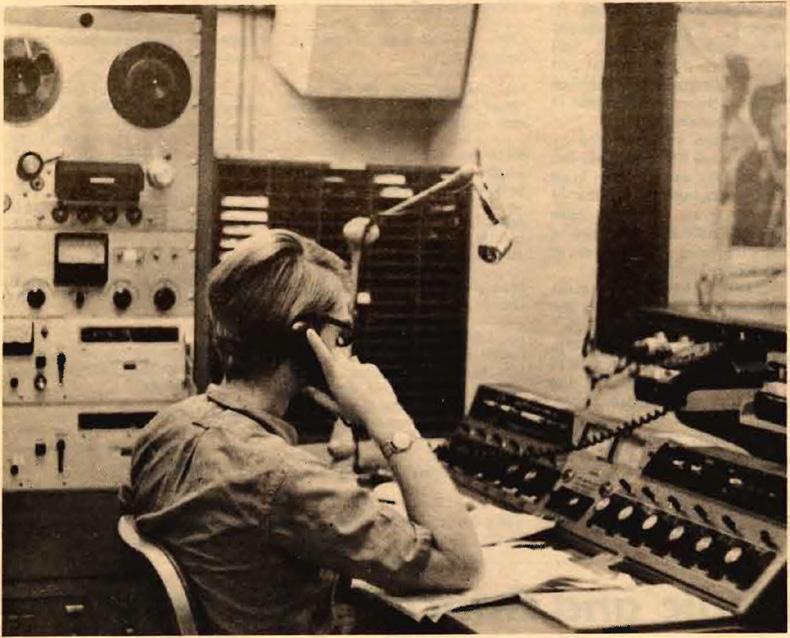
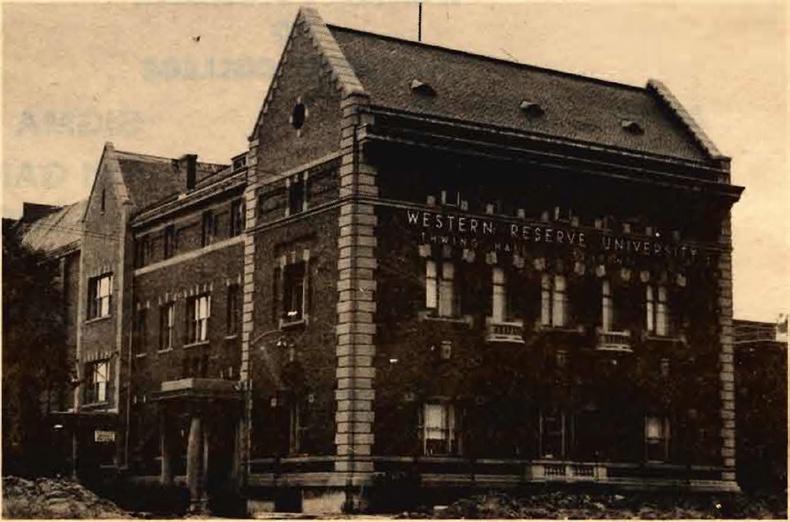
awarded a Polaroid camera.
This raises the question, what happened to the Tech between now and then?
publish under a new name.


versity newspaper. The Tribune’s editorial staff voted unanimously to create a new paper, with a 6-3 majority of the Tech’s staff as well. However, this plan ran into organizational complications, as the Tech could only be dissolved through a referendum per the bylaws of the Case Board of Publications.
This kicked off a frantic series of campaigning led by former CIT alumni who noted in one advertisement printed in the Tech that “A
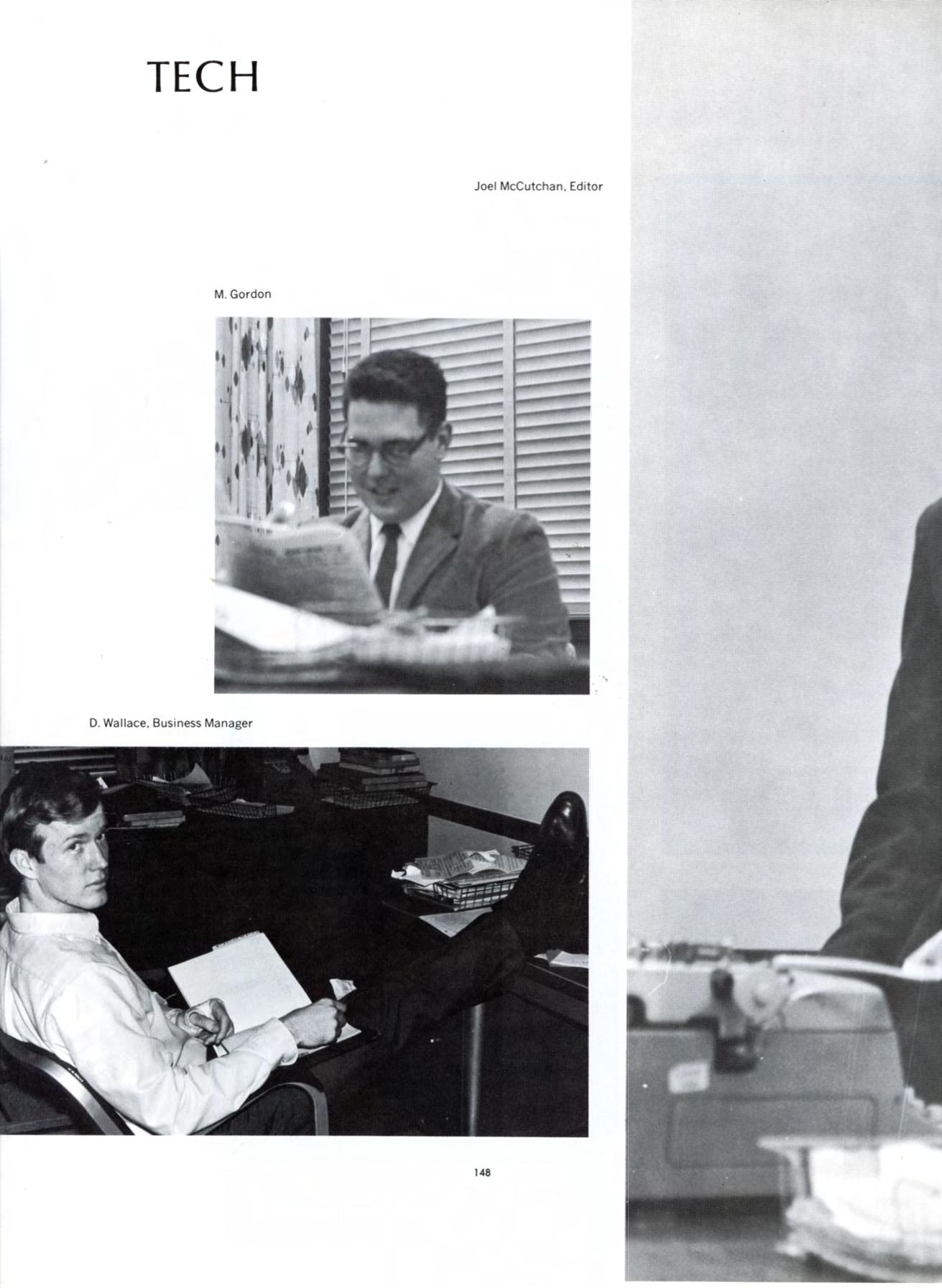
A November 1979 article from The Observer analyzed the source of newspaper funding for both the Observer and the Tech and found that the Tech was financially dependent on the Undergraduate Student Government (USG). This did not bode well for the Tech’s more satirical and humorous style of reporting, covering everything from actual news to reporting on rumors.
On Jan. 24, 1980, the Tech was suspended by the Case Board of Publications due to financial problems. Its last publication was at the end of November 1979.
Come February, The Observer proposed, again, another merger, with the Tech becoming a monthly satire magazine, and all the journalistic functions of it being transferred, again, to The Observer.
On Feb. 19, a faction of the Tech opposed the merger and republished across the university with the title of “The Interim News,” a four-page newspaper, with an editorial leading its front page claiming that they have supporters and are printing what students want. Those behind the group claim that The Observer was a one-sided paper and wanted to preserve CIT’s voice in CWRU’s affairs. It was partly founded by the Case Alumni Association.
The Interim was published twice in February and once in March under the name of “The Construction,” as the university did not approve of its new header that featured the university’s name.
In the next academic year, the Tech faced more criticism, including potential boycotts and a lawsuit. This stemmed from pieces that targeted the Women’s Center, AfroAm and the Gay Student Union. Its articles were cited as being racist, sexist and overall bigoted. It even inspired protests at its office and outside of its end-of-semester fundraiser, where members of the organization joined and chanted “we are evil.” This protest was organized by the anti-draft committee and the National Lawyers Guild. The Tech printed one issue that academic semester.
The Tech was renamed “The Satyr” and died in April of 1982 at the hands of USG with only a handful of issues to its name. The current satire magazine, The Athenian, has no previous connection to the Tech. Its birth was a result of an Observer column gone rogue in the early 2000s.
In all, that is the brief and overly complicated story as to how The Observer came to be, a publication that arose from federating both a university and also a student body. This is something that CWRU students ought to take pride in.
university paper, which is where the name The University Observer was suggested by then student George Siekkinen and was changed by the Editorial Board to become The Observer.
Other names suggested included The Harvard Midwest Review, The Federater, The University Circle Sun, the Union Informer, the Euclid Crosswalk, The Daily Reamer, The Newspaper, The Caserver, the Case Reserve Tribtech and The Po-
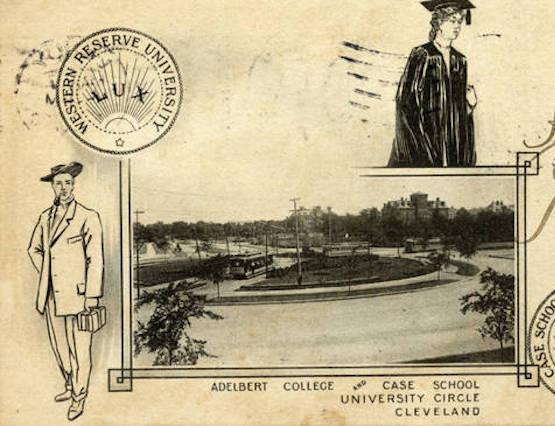
Shejuti Wahed Social Media Content Creator
Dozens of Case Western Reserve University students and faculty staged a “die-in” protest in Tinkham Veale University Center on April 19 during CWRU’s Open House/Admitted Students Day. A list of their demands was passed out to onlookers and also included in an open letter to President Eric Kaler. After bringing their protest to Adelbert Hall, where the outside doors were locked and they were unable to reach Kaler, they instead delivered the letter to Interim Vice President for Student Affairs Peter Whiting outside of the building.
This protest occurred hours after CWRU’s chapter of Students for Justice in Palestine (SJP) reported on their Instagram several proposed sanctions on individuals accused of promoting flyers across campus. However, many students at the “die-in” emphasized that their presence was independent of SJP—rather, this was a collective demonstration of a broader coalition of stu-
At around 10:15 a.m., participants fell to the student center’s ground where tour groups were expected to assemble. Protesters wore posters taped to their fronts reading “We Are All SJP,” demonstrating support for the nowsuspended CWRU chapter of SJP. As prospective students and their
government’s actions in Gaza as well as a list of the protestors’ demands from the university.
The list of demands pressed CWRU’s administration to “reinstate SJP,” “drop all current conduct charges against students advocating for Palestinian freedom,” “implement Resolution 31-15 and
students distributing flyers said, “We wanted to cause a disruptive action that was still safe and peaceful so that the university would listen to the demands.”
At first, the “die-in” in Tink was met with confusion or was largely ignored by passersby. However, as more families arrived for their tours, the protestors remained. Some parents were seemingly upset and complained to the staff at the admitted students tables, who reiterated their lack of control over the situation.
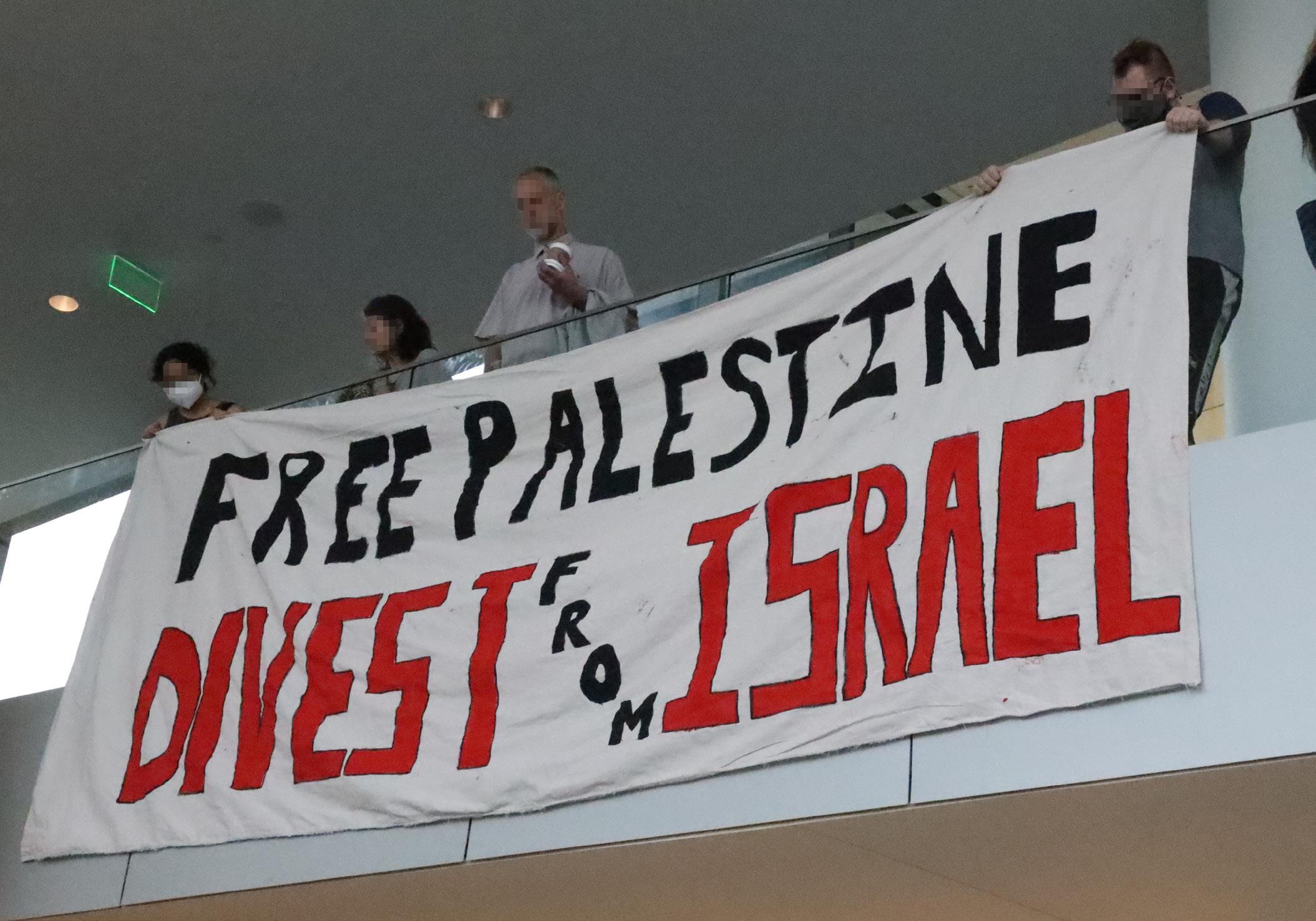
families stared at the scene, the “die-in” protestors disrupted the Open House tours and caused new lines to be redirected into the space behind the large stairs. A group of students also held a banner from the second floor of Tink that proclaimed in bold letters, “Free Palestine”

dents’ support for the Palestinian cause. One of the participating students said, “SJP isn’t the only pro-Palestinian voice. The general student body supports a ceasefire and divestment and a free Palestine.”
Other onlookers were moved by the display. One student passing by the protest said, “I think it’s really brave and big considering how the university has responded to less extreme acts in the past. It shows the direness of the situation and also how little the university listens to its students.”
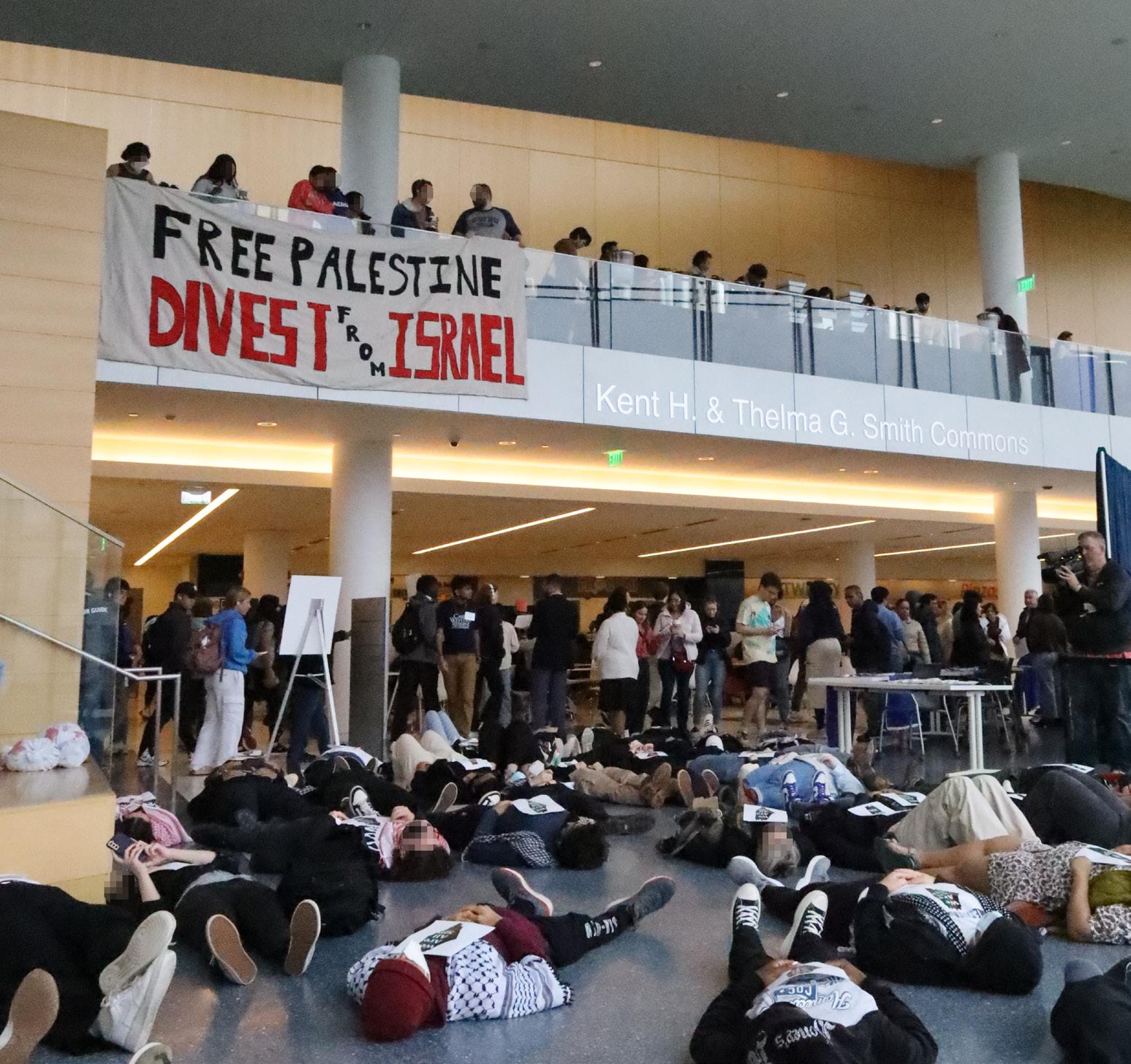
and “Divest From Israel.” While the majority of the protestors were silently lying on the floor, surrounded by makeshift body bags, a few students distributed flyers to onlookers. These flyers included a fact sheet summarizing the Israeli
disclose CWRU’s investments.” Resolution 31-15 was passed by the Undergraduate Student Government (USG) in fall 2022 to call for CWRU to divest its investments toward Israeli apartheid. The fact sheet also called for CWRU to “retract remarks made against Resolution 31-15 and accusations of antisemitism” and included a “call for a permanent ceasefire and an end of the occupation of Palestine.”
When asked about the purpose of the demonstration, one of the
Those who participated also felt that the need for the “die-in” was in part due to the increase in campus visitors. One student said, “We’re out here today representing the students who have been so ignored by the university … even if that means warning prospective students who may not feel safe in this university that this is the culture administration has created.”
Another student added, “They flew in students from diverse backgrounds, so we thought it was relevant for us to not let the administration simply present this screen of inclusivity and ‘happy-go-lucky’ and ‘we all feel safe here.’ We thought that we would direct [our efforts] towards the people who [the administration] considers its clientele, which is the prospective students and their families.”
As foot traffic slowed in Tink, the protestors stood up and filed out of the building, heading toward Adelbert. The group was led by a protester with a megaphone who began chanting many popular call-and-response chants from pro-Palestine protests, such as “If we don’t get it? Shut it down!” “The people, united, will never be divided” and “From the river to the sea, Palestine will be free.”
They also participated in CWRUspecific chants such as “Kaler, Kaler, you can’t hide; we charge you with genocide.” The group was trailed by police officers and legal observers.
Upon approaching the administrative building, the protestors continued marching to the quad side of Adelbert where prospective students passed by during their tours. The group intended to deliver an open letter addressed to Kaler listing the same demands as the flyers. They vowed to “continue to proudly resist the Univer-
sity’s support of the grave injustices inflicted upon the Palestinian people by Israel, and by extension the United States,” signed by “the CWRU Community.” The full letter, posted to the @cleveland. palestine Instagram page, also promises that the community has prepared for backlash from administration, “knowing that whatever consequences they may pose pale in comparison to the bloodshed and colonial brutality leveled at Palestinians at the hands of the Israeli government.”
After the doors to Adelbert re -
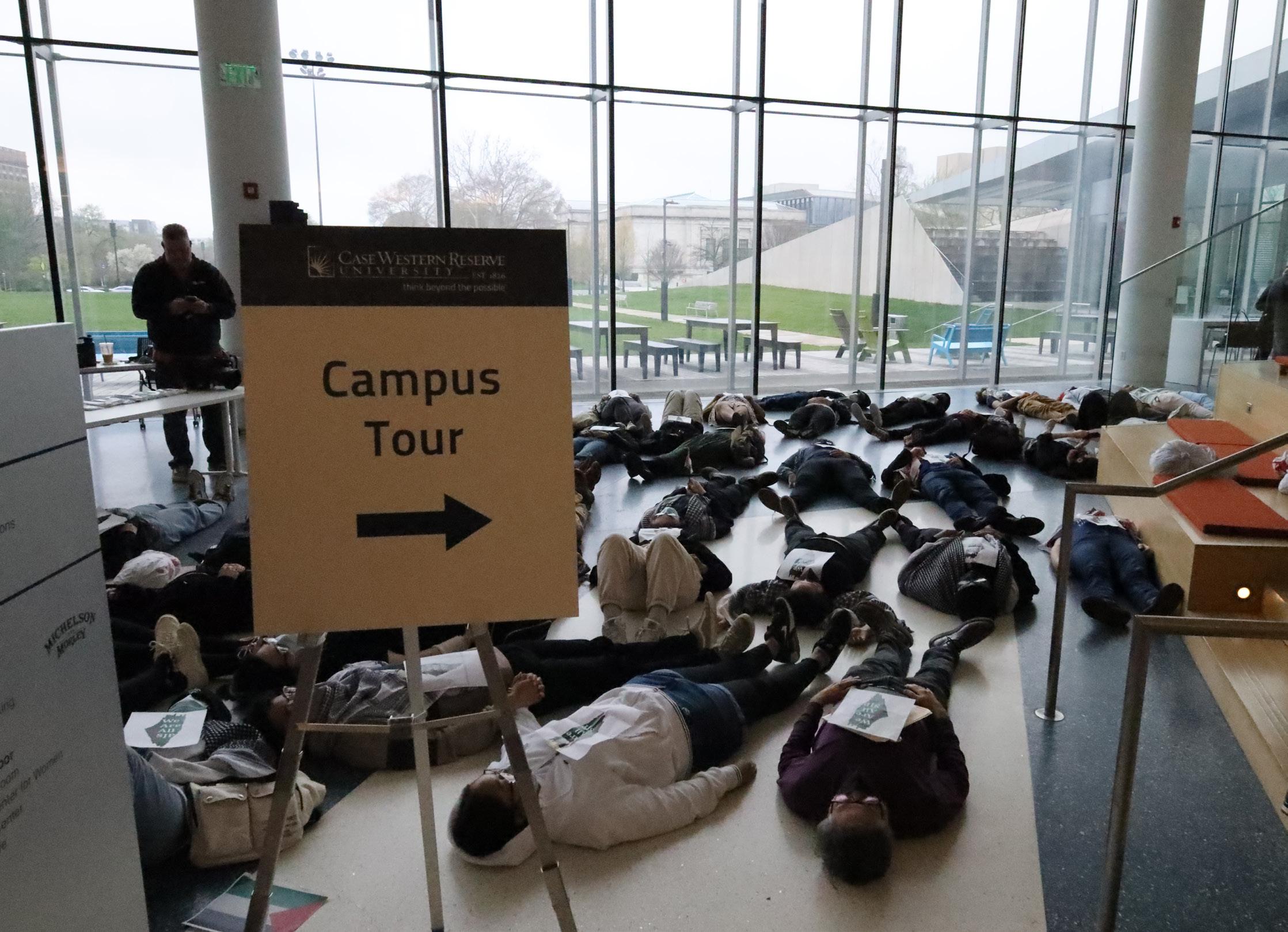
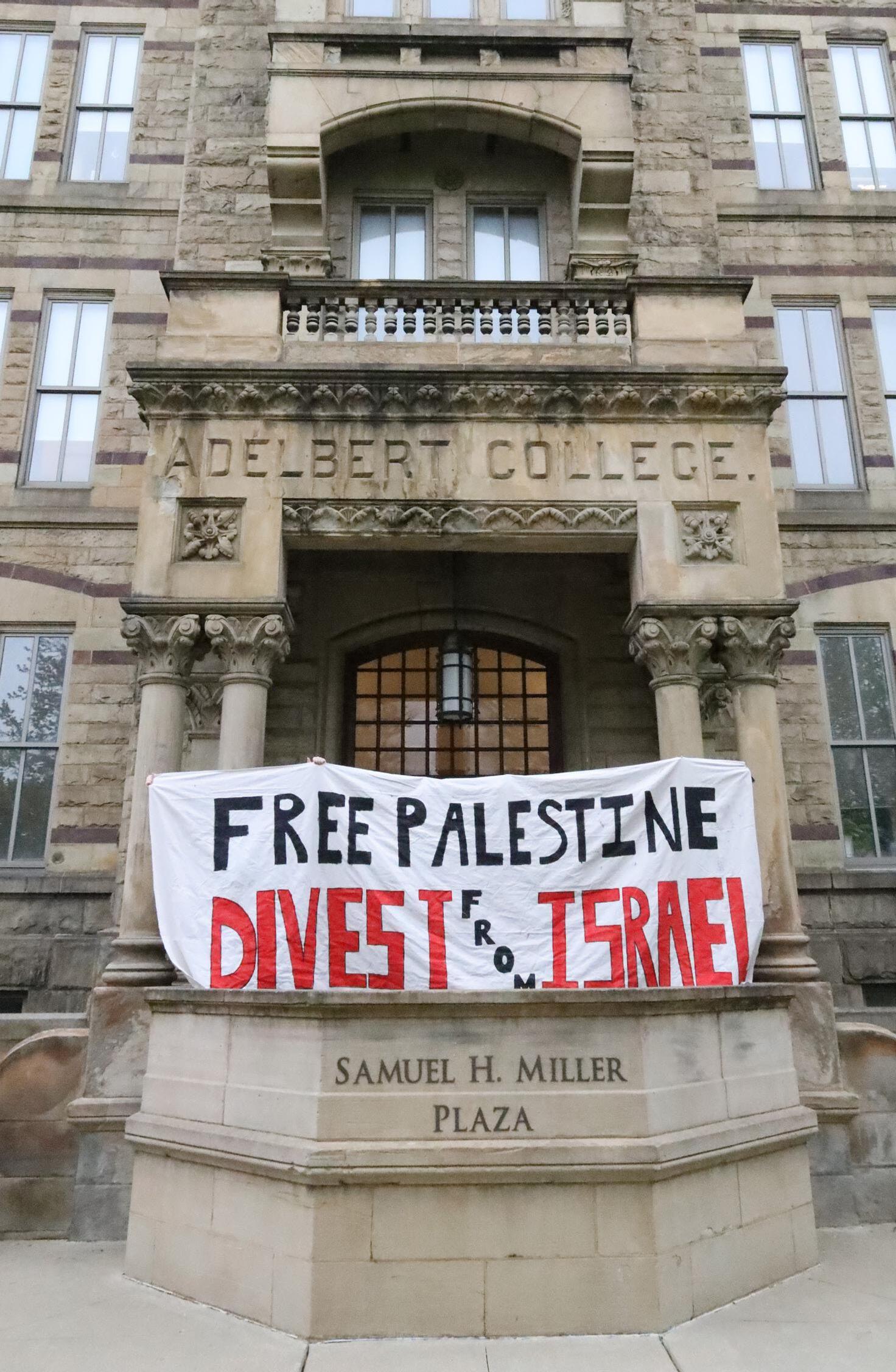
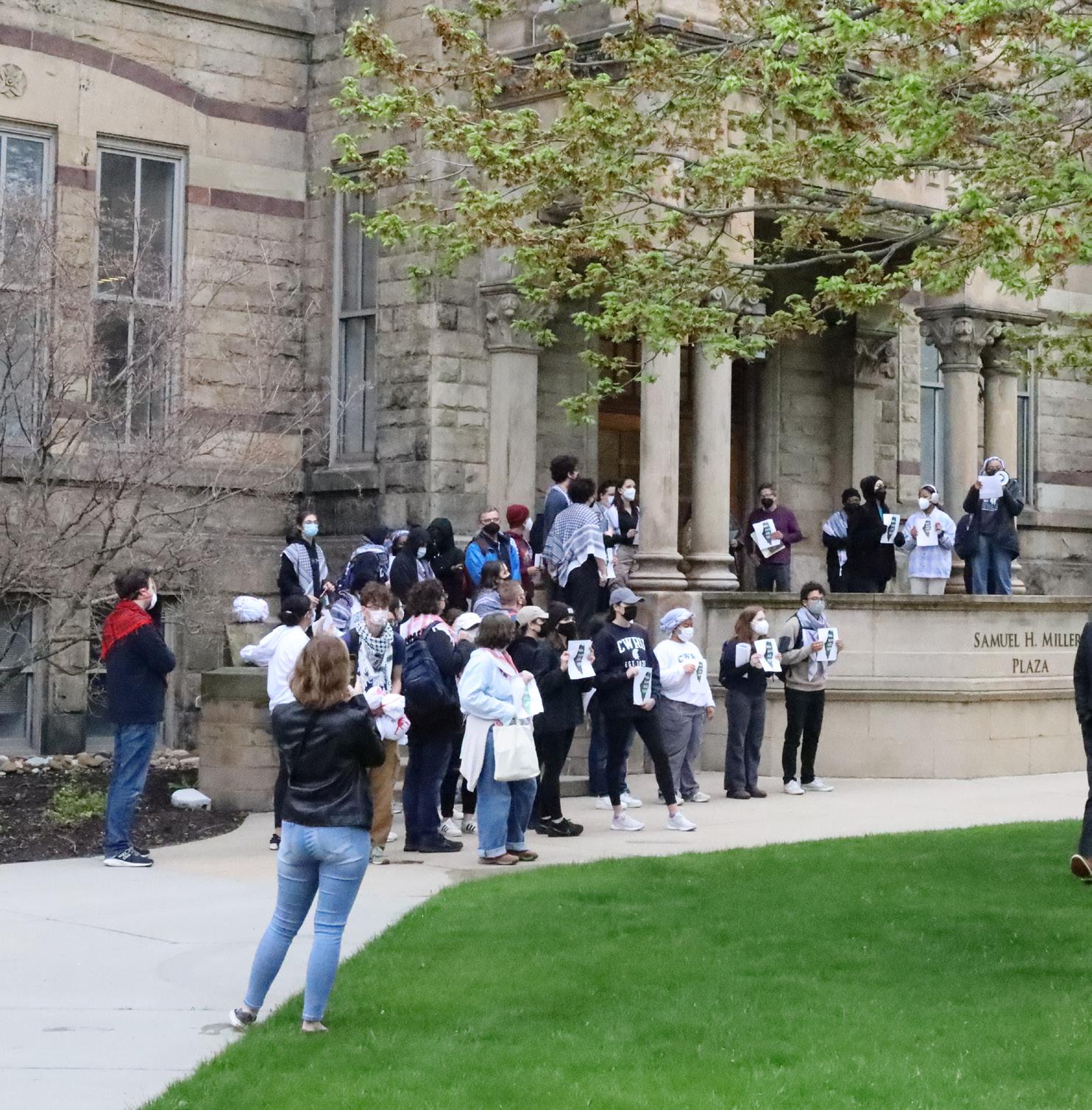
stood a few feet away watching the events unfold. During this time, the protestor leading the chants changed them to now say “Whiting, Whiting you can’t hide; we charge you with genocide.” Whiting previously spoke on behalf of the administration at an open USG Executive Meeting on March 5 to discuss SJP’s interim loss of recognition.
Students were not the only ones engaging in the “die-in” and march to Adelbert. Sociology Professor Timothy Black said that he joined
in support of SJP and student activists on campus. He said,
“These students [in SJP] are acting with extreme moral courage this semester … They’re the campus heroes, and instead the administration is trying to sanction them—they’ve suspended them. And I’m here supporting them for those reasons.”
To Black, the cause runs much deeper than SJP and their suspension. “Sometimes education happens in the classroom; sometimes it happens outside the classroom,” he said. “This university has provided a good laboratory for understanding how power operates.”
After The Observer reached out for comment about the “die-in,” a university spokesperson replied, “Due to the Family Educational Rights and Privacy Act (FERPA), the university doesn’t comment on student conduct issues. For all student organizations, the university follows its student judicial policies and procedures and applies these uniformly and fairly across groups. We understand that the students have their viewpoint on the student conduct proceedings, based on the information they have.”
Additional reporting contributed by Copy Editor Darcy Chew, Photo Editor Clay Preusch and News Editor Zachary Treseler.
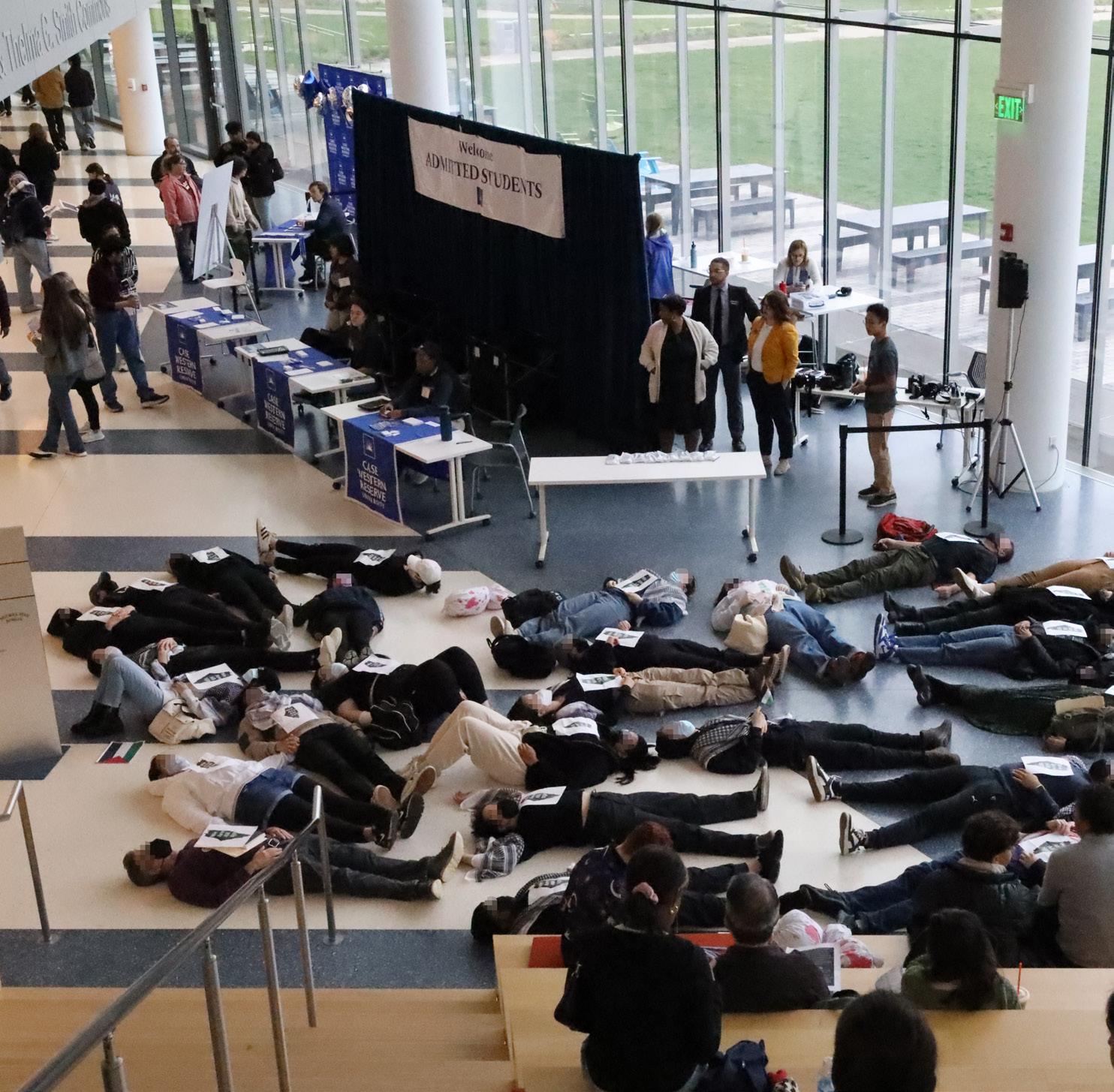
Shejuti Wahed Social Media Content Creator
At Case Western Reserve University, undergraduate research is a cornerstone of our identity and reputation. But when we are so often immersed in the daily tasks of being a student and in our own research, there are few chances to familiarize ourselves with the incredible work of our peers. Luckily, the Intersections poster sessions held every semester are a perfect way to get to know our fellow undergraduates and honor their hard work in all sorts of fields. Here we spotlight some of the incredibly talented student researchers who presented their work at Spring Intersections 2024, each representing the rich diversity of disciplines and academic pursuits on our campus.
Engineering
Eliot Rowe is a fourth-year student studying mechanical engineering. His project with Mitchell Arch, another fourth-year mechanical engineering major, aims to utilize robotics techniques to create a device which collects manure and prevents it from entering the water supply. They have created a first prototype for a design that attaches to a commercial tractor and sweeps manure into its bucket, with modifications that allow it to work on hills and around other obstacles. While they are still hoping to make a second prototype in the future and expand on their project, Rowe says that presenting at Inter-
sections has “made all of the hours I spent late at night seem more worth it in a way.” He also has developed a newfound appreciation for “the countless hours of engineering time that goes into developing even the simplest of items,” something he could not fully comprehend until engaging in the work himself.
Basil Yaseen and Sophia Kafiti are both fourth-years majoring in biology and economics. Their project, titled “Doctor’s Orders: The Relationship Between Number of Prescribers and Rates of Opioid Use Disorder,” uses Centers for Disease Control and Prevention and Ohio-based data to take a healthcare economics approach to addressing the opioid crisis. Their findings demonstrate that at the state level, there was no correlation between the number of prescribers and rates of opioid abuse, but for specific Ohio counties, the relationship did exist. Initially, the two wanted to find a topic that overlapped both of their majors, making any healthcare economics topic seem viable. However, the opioid epidemic stuck out to them the most, considering Ohio has one of the highest rates of opioid overdoses in the nation. They hoped this project could help them “possibly look into potential policies and avenues that can help our own community.”
Continue reading on page 7
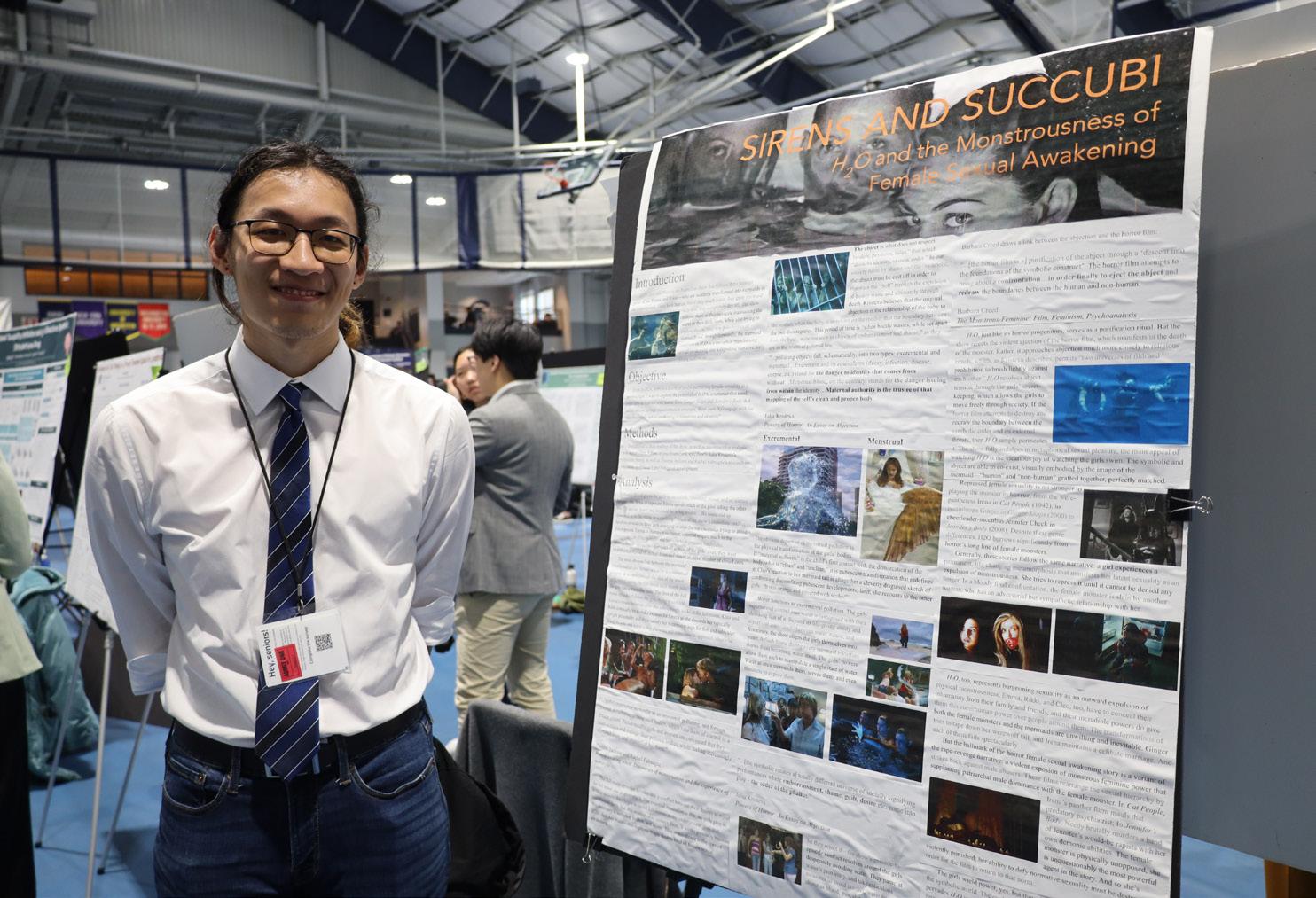
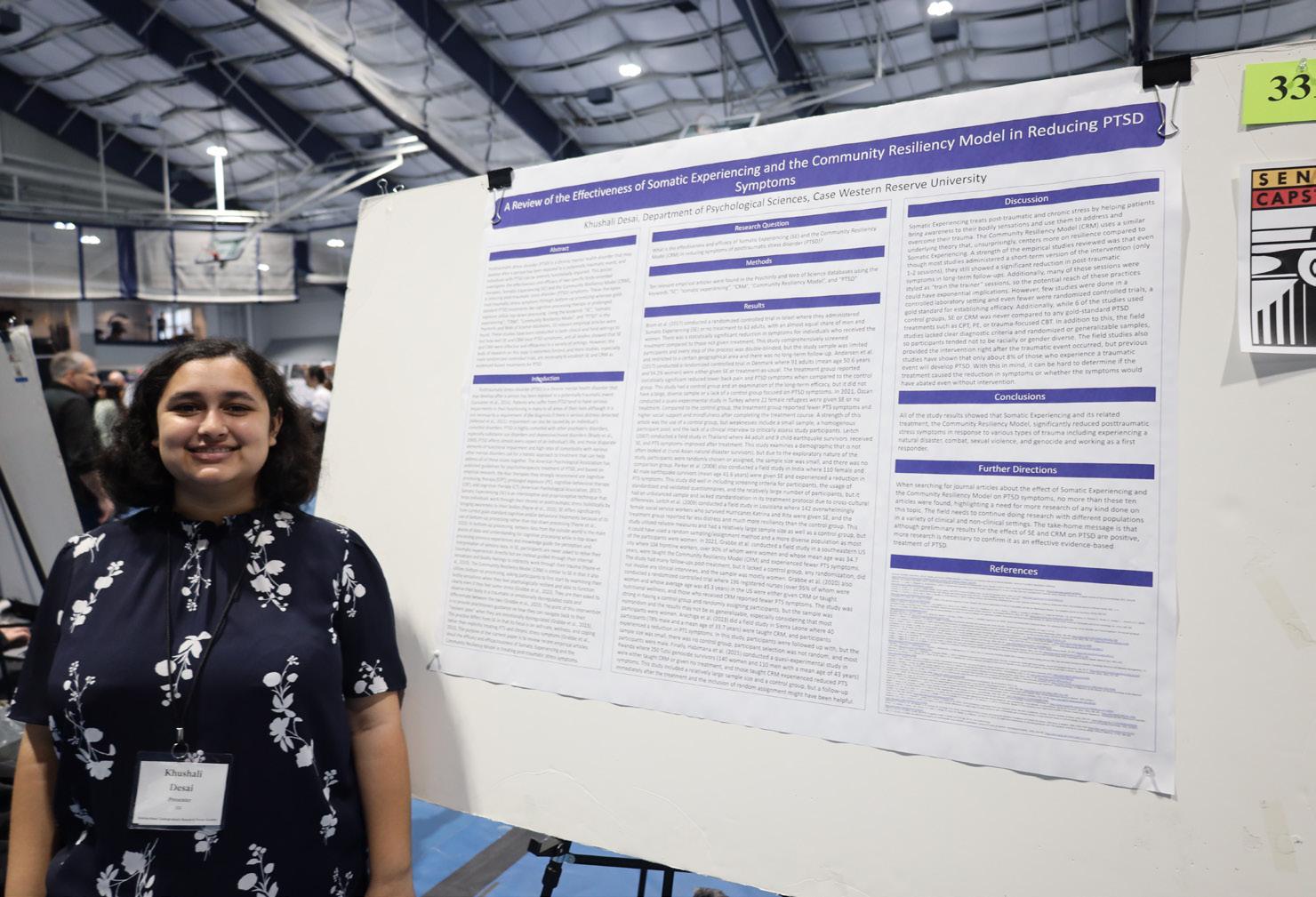
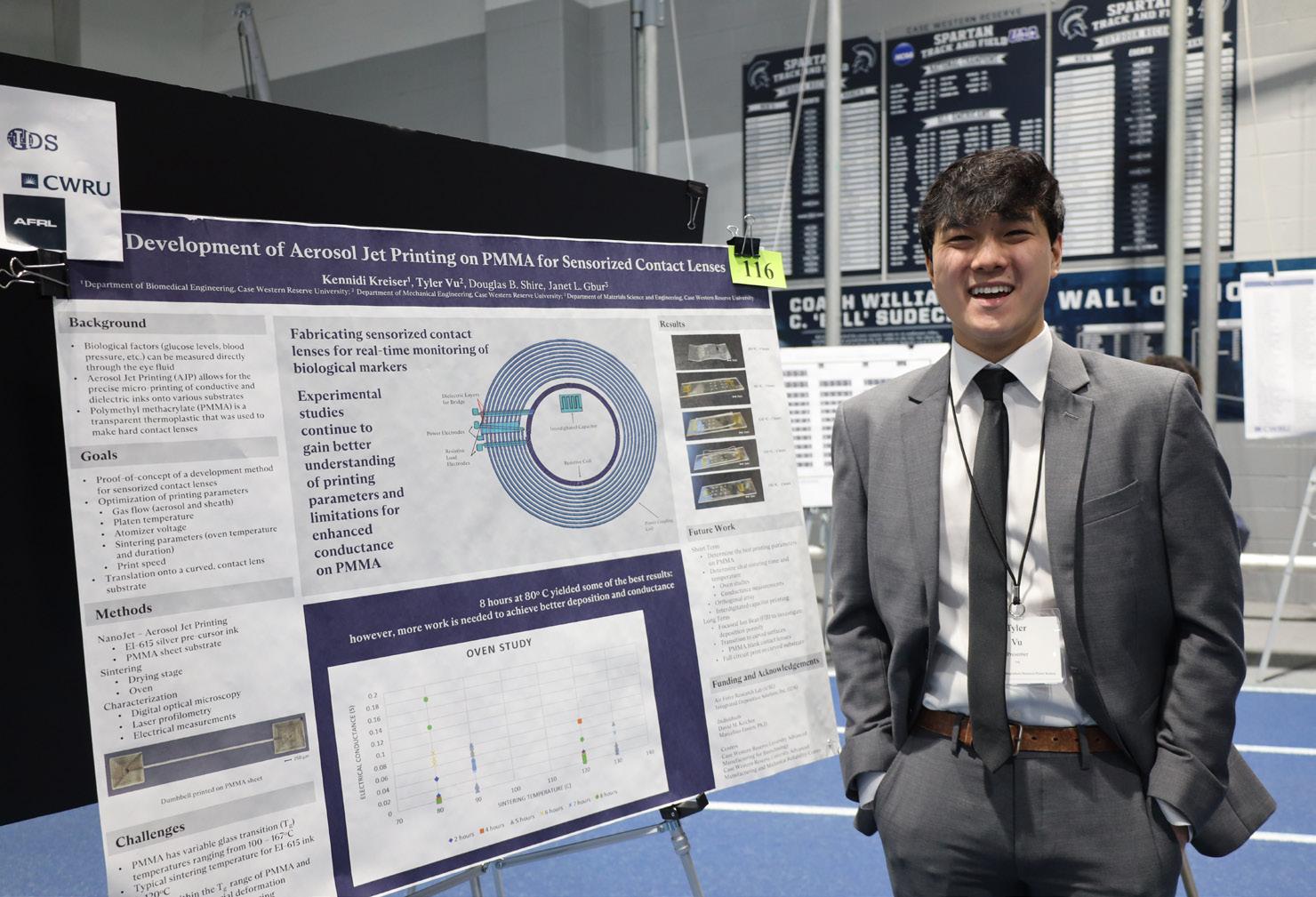
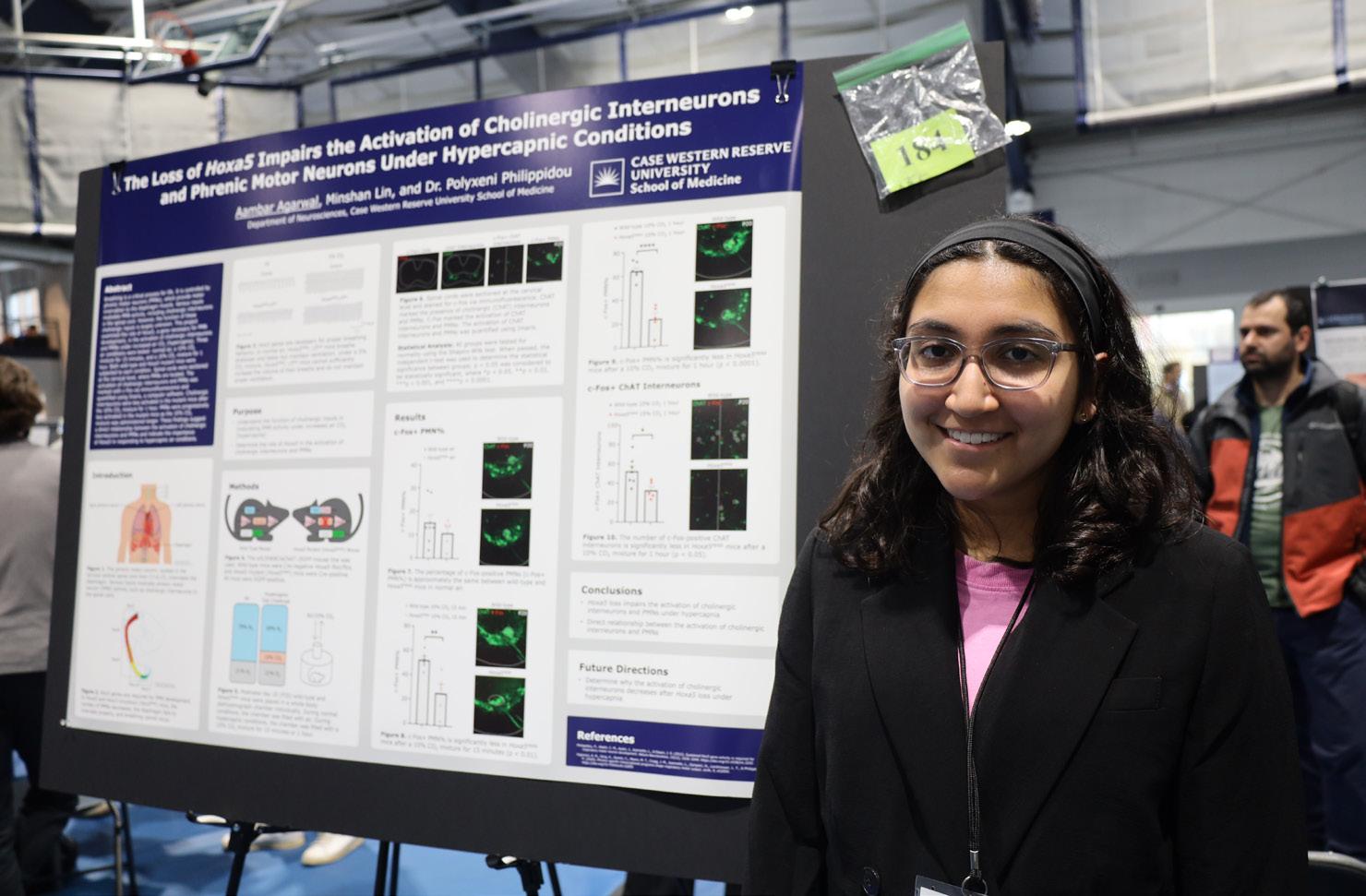
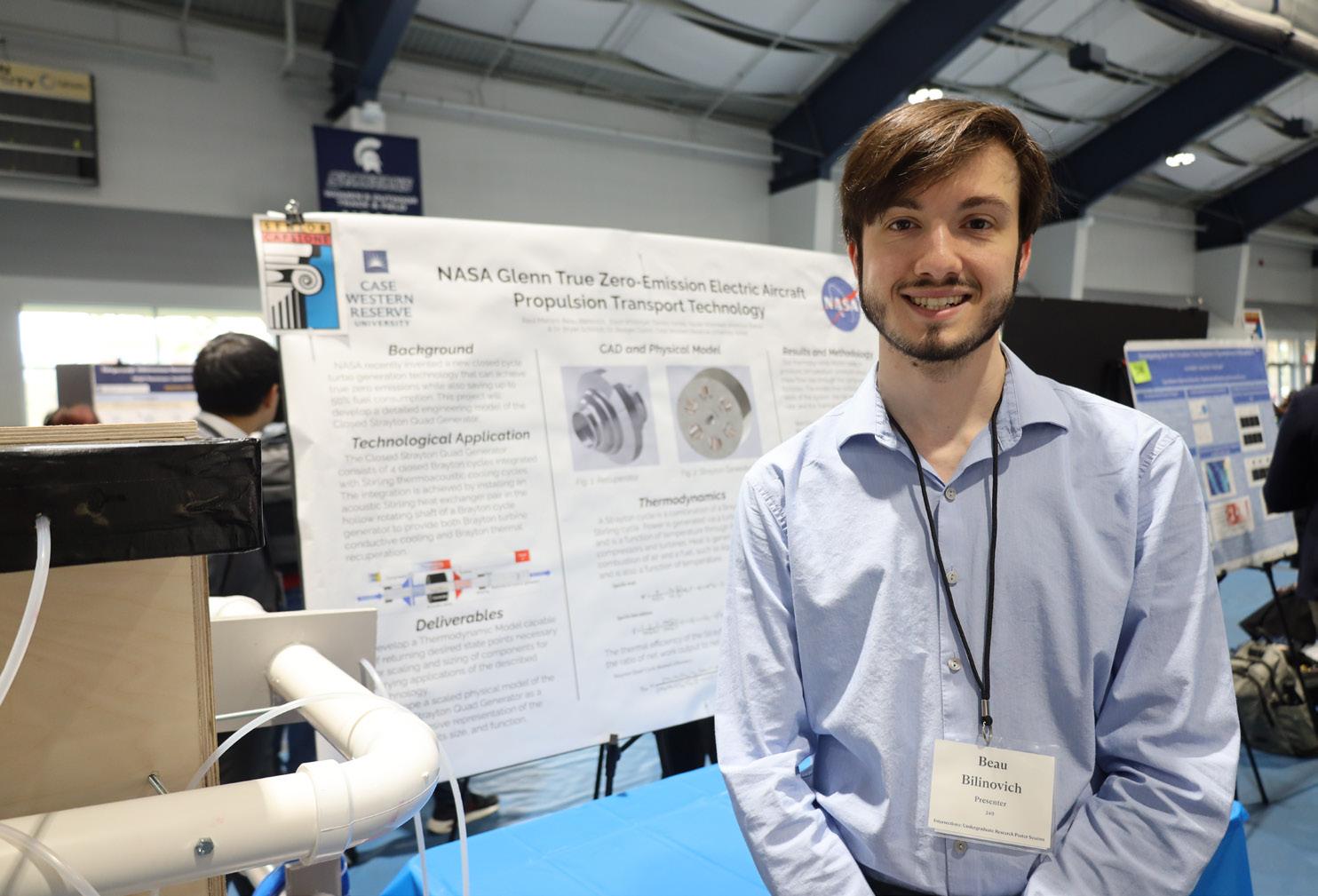
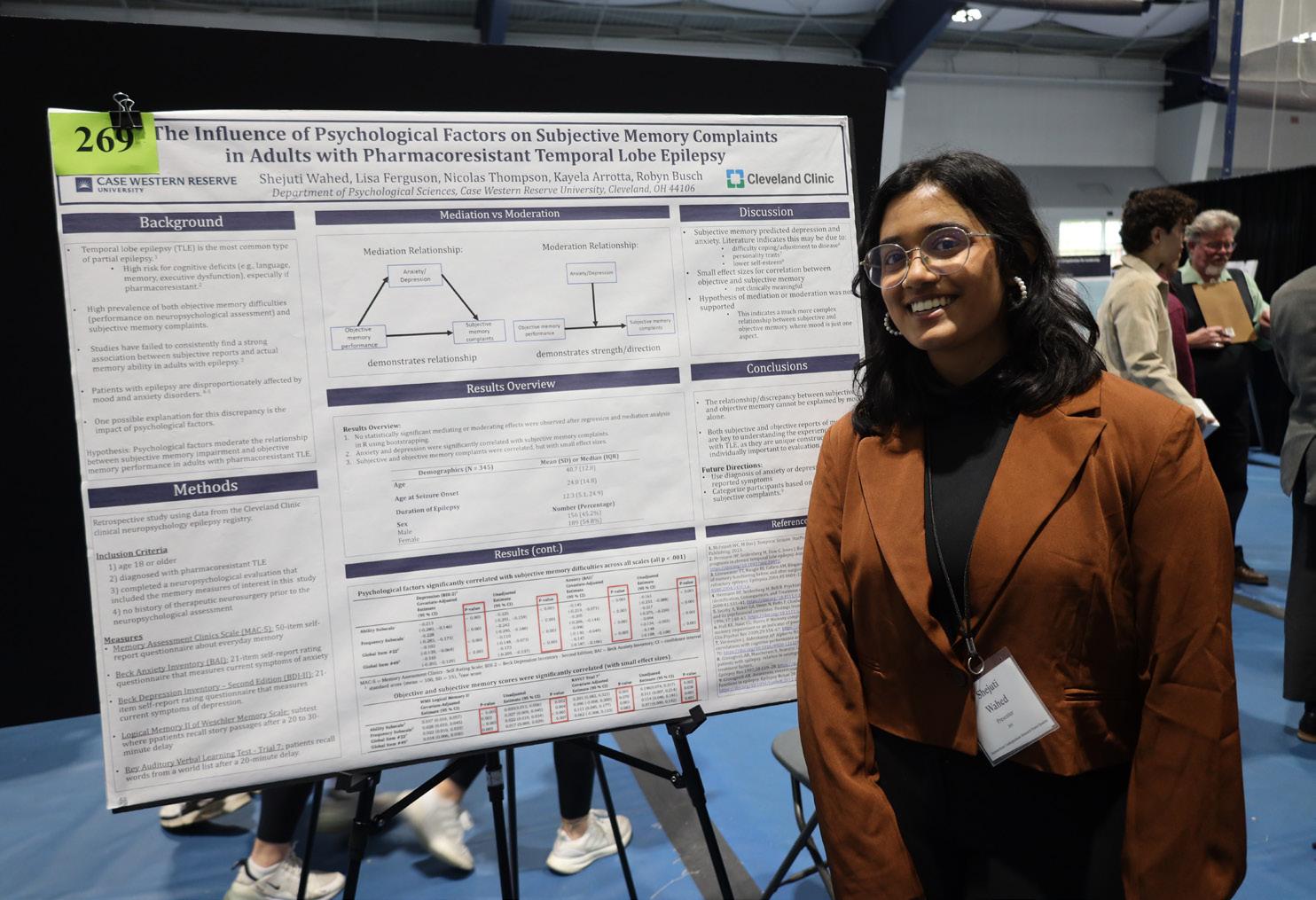
English
Lucas Yang is a second-year studying computer science and English. As an English major, Yang felt a little intimidated by the STEM-heavy poster session at Intersections, where “it was kind of a left field poster to see [me] between, like, cancer research and a robot arm.” Nonetheless, his project “Sirens and Succubi: ‘H2O’ and Female Sexual Awakening” was fascinating to everyone who spoke with him, myself included. Yang explores the Australian drama “H2O: Just Add Water” and how female sexuality is portrayed as the monstrous “Other” in the popular show. Yang also had the opportunity to present his work at the Popular Culture Association conference in Chicago, where he was able to talk about the significance of his work with academics from all over the country. His work was particularly relevant, as “there’s a huge lack of scholarship—I think none—on this show,” so he enjoyed looking through “all the layers of meaning that have been so underexplored.”
Biochemistry
Hana Lee is a fourth-year biochemistry and music double major who presented on “The Effect of Charged Residues on Substrate Glycosylation by the Core-1 Transferase.” Lee’s work expands on prior research on a particular post-translational modification of proteins, mucin-type O-glycosylation, and focuses on the Core-1 enzyme. She finds that Core-1 trans-
ferase has a strong preference for negative charges, during which process she also discovered a new inhibitor for the enzyme, sodium formate. Lee has been working on her project for four semesters and a summer, and during that time had many detours along with the discovery of the new inhibitor. However, during this time she has enjoyed the ability to “dive deeper into biochemistry within the last two years,” especially as her project connects to what she has learned in her biochemistry courses.
Kayla Characklis, Eleanor Clarke, Sydney Stone and Alexandra Unda are all fourth-years who spent their time working with the Cleveland Metroparks Zoo (CMZ) on the development of puzzle feeders. These are special feeding devices that provide mental stimulation by “encouraging the animals to use their natural feeding or foraging behaviors.” They have successfully built puzzle feeders for two giraffes and a giant anteater at the zoo, and plan on dropping them off as soon as they have presented their senior capstone. Throughout their project, they have learned how to meet deadlines while still expressing their creative freedom, and they have loved “working with the CMZ staff and visiting the zoo for meeting and testing.” They hope their work has made people more excited to visit the zoo and learn about puzzle feeding in general.
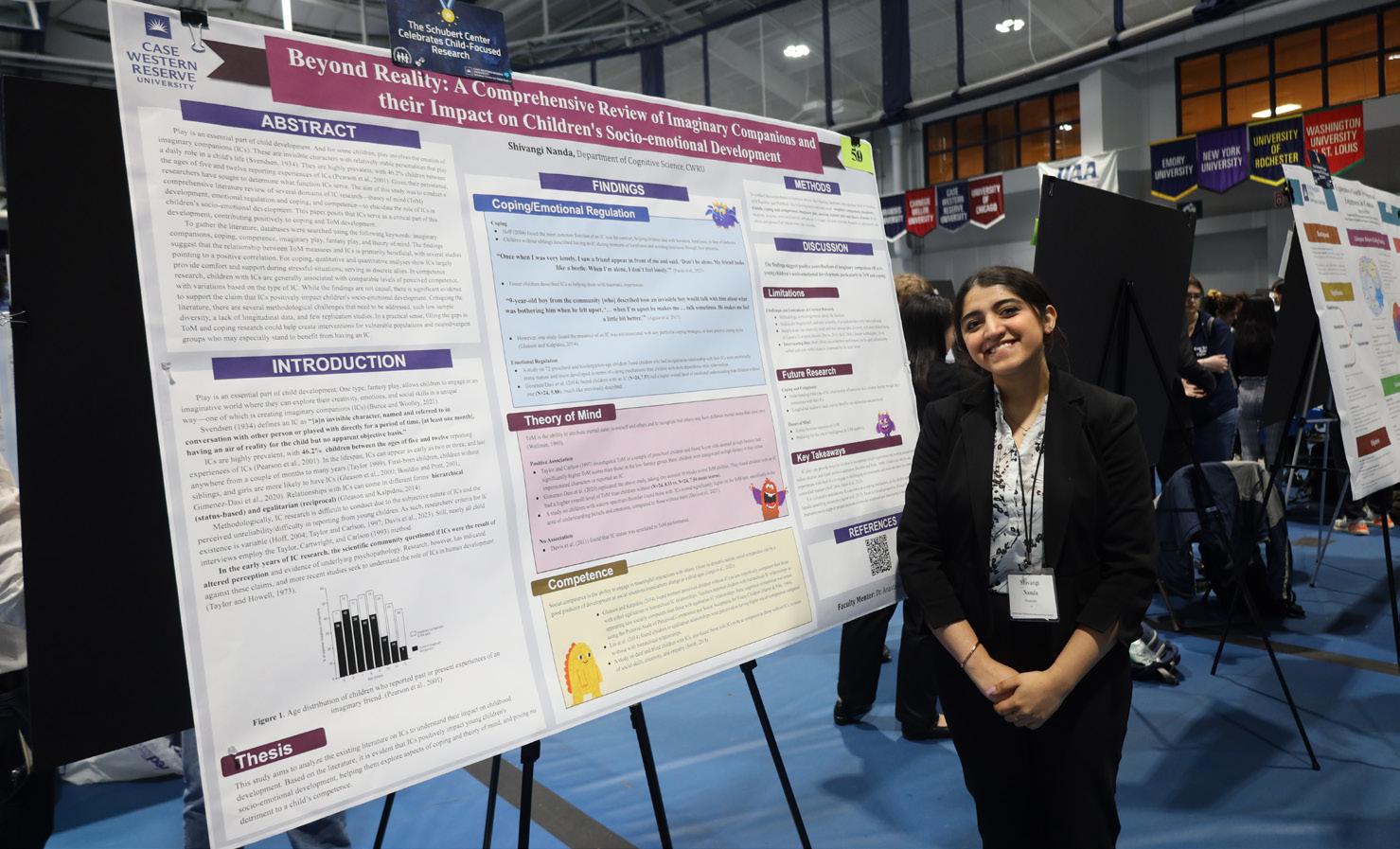
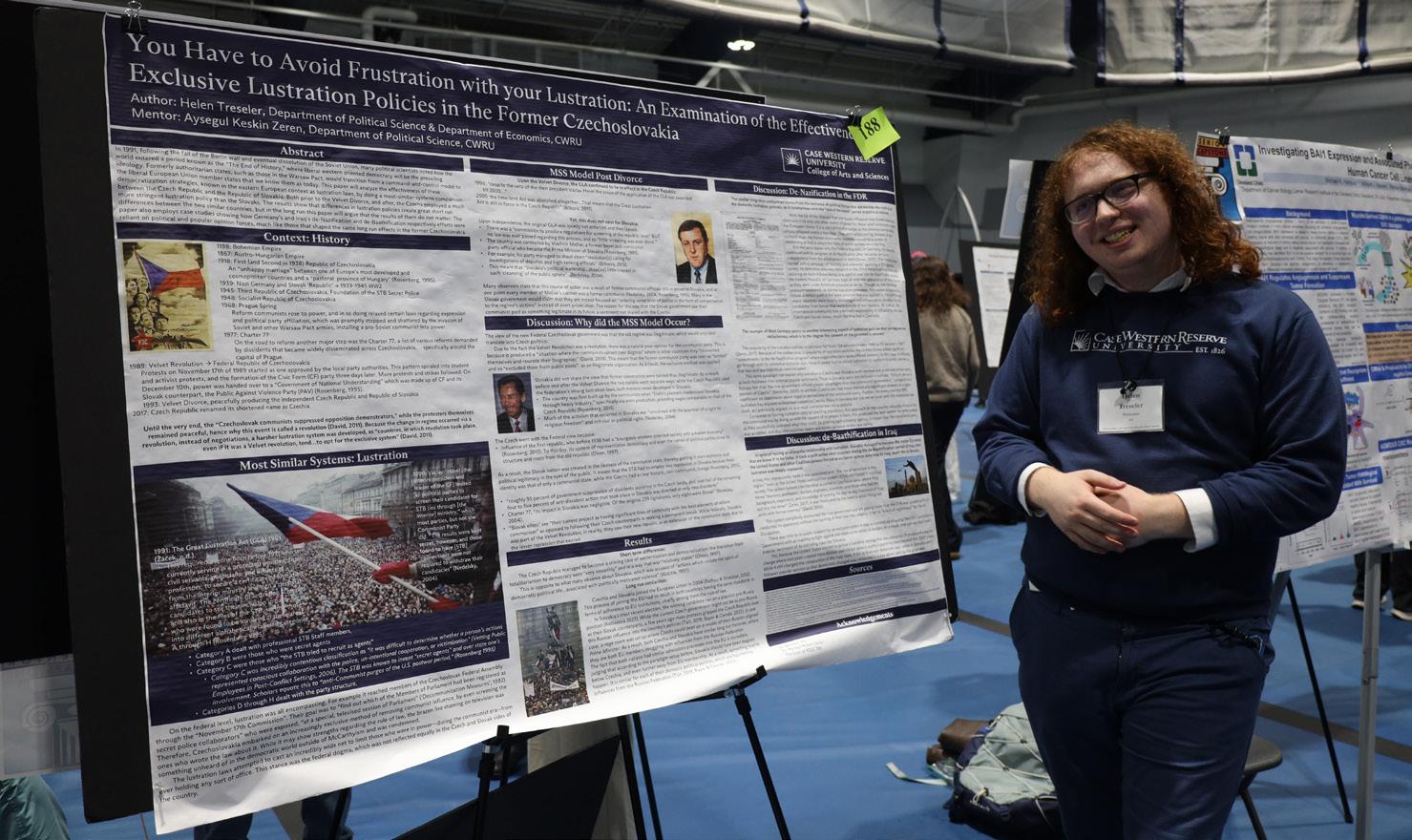
Cason Willman Staff Writer
Richmond, Virginia’s Antichrist Siege Machine (ASM) just released their third studio album “Vengeance of Eternal Fire” on Friday, April 19, the subsequent album after 2021’s “Purifying Blade.” With newfound popularity in the war metal/extreme metal scene after their sophomore release, fans such as me were eager to see how ASM would handle newfound publicity. Would they be more accessible, losing the trademark extremity that made them so fresh to begin with? Or would they continue their aggressive, visceral style? Oddly enough, Antichrist Siege
Machine has done a little bit of both but without a hint of compromise.
Anyone listening to five adjacent seconds of this album will recognize that this is not radio rock; this isn’t Metallica or Bullet for My Valentine. This is the type of Satan-worshipping stuff that Tipper Gore was crying about back in the ’80s. ASM lost absolutely none of their bite or brutality. The opening track “Son of Man” launches directly into blast beat drums and “unleashed hostility.” The balls-to-the-wall, completely-saturated, insane aggression doesn’t stop either, save some guitar feedback at the end of “Prey Upon Them” leading into “Vanquishing Spirit”—one of the album’s two singles—and the album closer “Abyssal Hate.” “Abyssal Hate” is
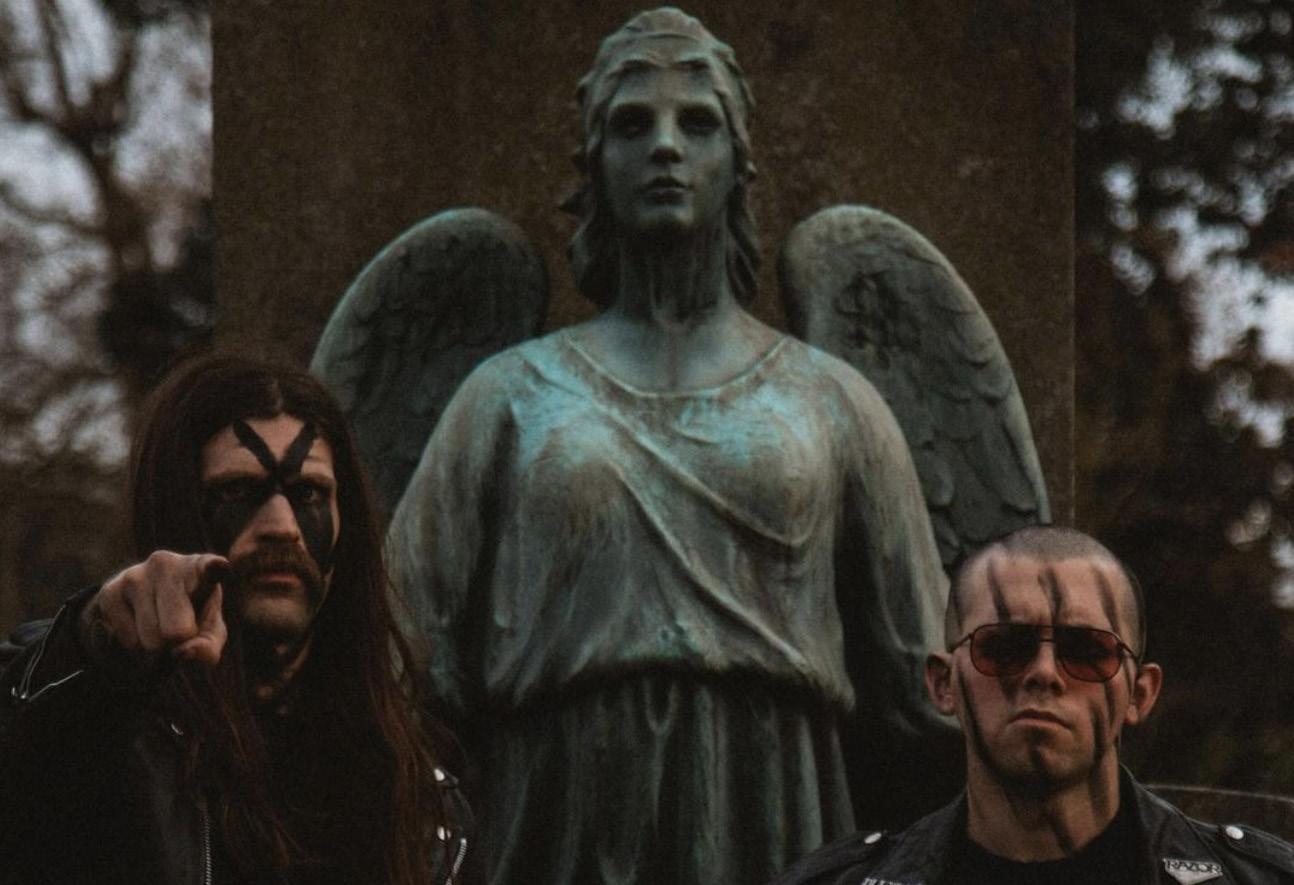
Antichrist Siege Machine returned with a fiery vengeance this past Friday with their latest studio album. “Vengeance of Eternal Fire” doubles down on the bands’ brutality, a move likely to catch fire with both seasoned fans and general audiences. Courtesy of Antichrist
actually one of the album’s highlights, with SB’s barks double-tracked with his screams as the album hurdles to its conclusion, with each biting vocal delivery leading up to the ultimate point of insanity and climax.
Not every song on “Vengeance of Eternal Fire” is as short as “Abyssal Hate”; most stretch for around three minutes, but ASM have perfected this war metal style so well that they are no longer restrained by the grindcore trope of short songs lasting less than two minutes, of which they were obviously devotees for their 2017 debut release “Morbid Triumph.” These threeminute and longer songs are tempered perfectly by catchy guitar riffs that will immediately make you rewind to hear them again. Some examples include the opening riff on “Piled Swine” or “Vanquishing Spirit” and the closing riff on “Sisera” or “Scalding Enmity”— one of the best riffs on the album but only lasting about 10 seconds. ASM package their extremity with immediacy just as they’ve done throughout their career, and in so doing, they set themselves apart from the war metal masses.
This is not to say that grindcore influences can’t be found on this album; in fact, of their three major studio album releases—2019’s “Schism Perpetration” and 2021’s “Purifying Blade”—this is probably the album most influenced by grindcore. One of the lead singles, “Vanquishing Spirit,” sounds like a grindcore song. Its knotted, gnarly riffs throughout are vaguely reminiscent of something off an Agoraphobic Nosebleed release and a D-beat breakdown near the song’s conclusion. ASM have always flirted with punk and grindcore, but it is no more apparent than on “Vengeance of Eternal Fire.” Grindcore is only one of the genres
ASM incorporates, not losing the viscerality of black metal—the introductory riff on “Cowering Lamb” will prove that—or of death metal, with SB growling lower than I’ve heard since “Schism Perpetration” on “Prey Upon Them.” I found the lead single “Sisera” to be a bit derivative when it first came out, aping too much of the style of modern, more polished black metal such as Batushka. However, the two-minute long “Sisera” functions much better as part of the entire album, and my fears that Antichrist Siege Machine were “selling out” were overblown.
Continuing the experimentation started on “Sisera,” ASM have made their most accessible album to date, with clean production juxtaposed sharply with the muddy bestiality of “Purifying Blade” and some of their most immediate guitar work ever— “Vanquishing Spirit” is the obvious exemplar here. But the album still maintains a no-holds-barred extremity that will satisfy any die-hard ASM fans (e.g., me) whose expectations were already sky-high. The fact that ASM have yet to put out a bad or even mediocre release this far into their career is astounding; their flawless record continues on the brighter, throttling insanity of “Vengeance of Eternal Fire.” It reminds me, in a way, of Nails’ “Abandon All Life” back from 2013; similarly, Nails followed up their most popular release “Unsilent Death” and, in return, gave us an ear-piercing shriek of insanity which satisfied and pleased all comers.
Verdict: Antichrist Siege Machine have once again delighted fans, which is impressive given their high expectations. “Vengeance of Eternal Fire” continues their unparalleled extremity while providing immediacy and headbanging riffs that will stay stuck in your head. 10/10.
Shivangi Nanda Executive Editor
Zachary Treseler News Editor
For many Case Western Reserve University students, Euclid Avenue is the prime destination for quick and easy meals. Home to our very own Panera Bread and Chipotle, and local favorites such as Chopstick and Indian Flame, Euclid Avenue serves its purpose of providing students numerous options when they want to go out for a meal. So, when a restaurant closes or a new one opens up, rumors begin to stir. No exception is the latest addition to the food strip: Sunset Kitchen.
Taking the place of Ninja City, Sunset Kitchen carries the same name as the restaurant that burned down before its opening. Owner Charles Hansford took this setback as an opportunity to rebuild, and Sunset Kitchen was reborn just two years later on April 24, 2024. Described as a “vibe dining experience,” Sunset Kitchen introduces globally inspired dishes and unique cocktails to the University Circle area. Unlike the other restaurants nearby, Sunset Kitchen offers what appears to be a more fine dining experience, with the added element of a bar/club-like scene. We set out to try their Sunday brunch menu, featuring classic items such as avocado toast as well as more decadent dishes such as shrimp and grits. Here is what we thought:
Avocado Toast
Avocado toast is a brunch favorite, and Sunset Kitchen’s version did not disappoint. Creamy guacamole is spread over wheat toast and garnished with crunchy bacon bits and diced tomatoes to make for a filling meal. There was also a bunch of grapes on the side, which added a refreshing note to an otherwise rich dish. While the avocado did not seem the most fresh, the delicious bread more than made up for it.
Shrimp and Grits
A southern classic, we were sur-
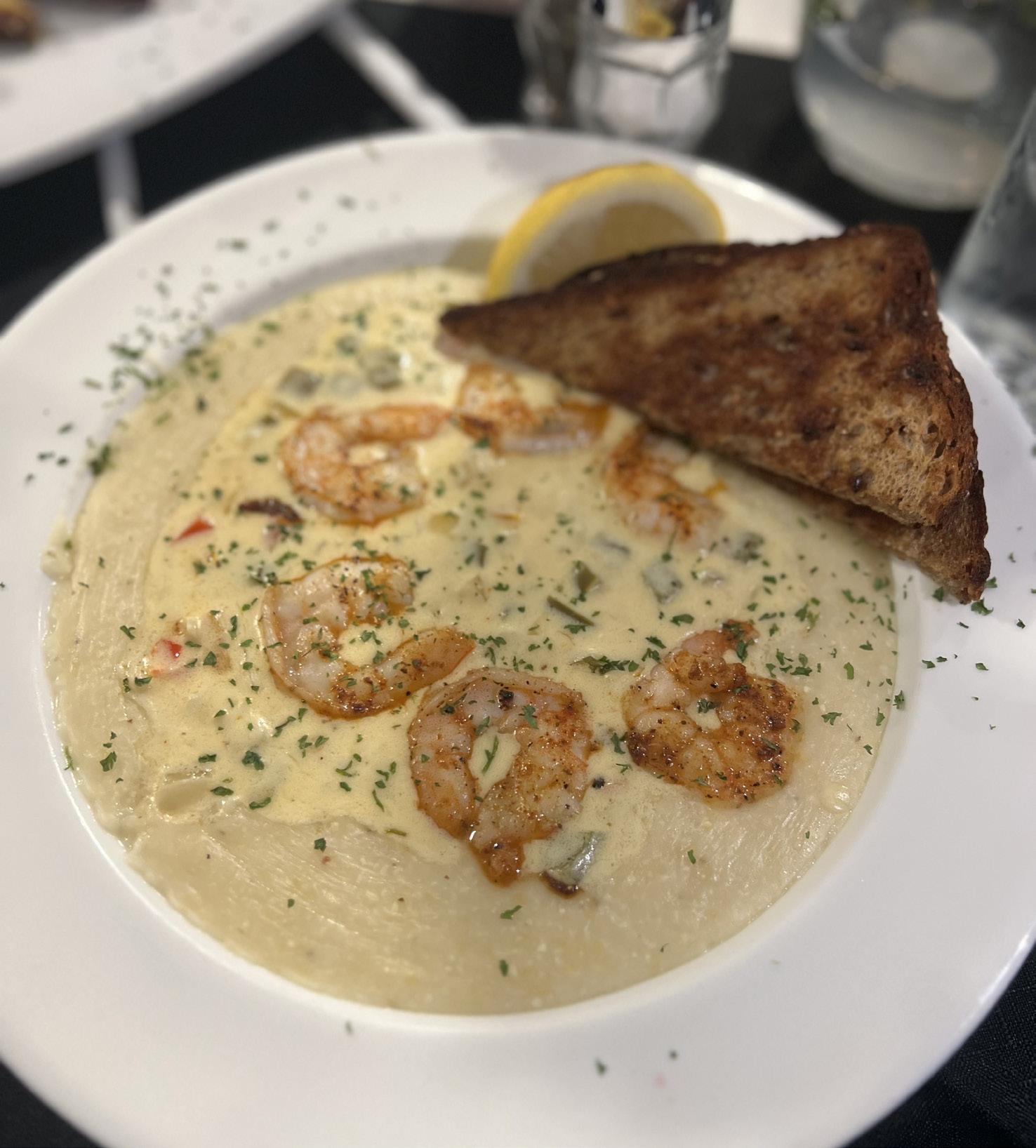
prised to see shrimp and grits on the limited brunch menu. At first glance, the dish looked promising—a nice portion of grits garnished with a circle of shrimp and a side of toast. However, while the shrimp were well-seasoned and juicy, the grits were nothing to write home about. We found the consistency of the grits to be souplike, and the flavor was not evenly dispersed throughout the dish.
Chicken and French Toast
Chicken and waffles—or in this case French toast—is great in name but deceivingly difficult to execute. Sunset Kitchen’s french toast was thick and sweet, and the cinnamony apple pie filling on top provided an elevated flavor profile. However, upon first bite we noticed that the toast itself had an
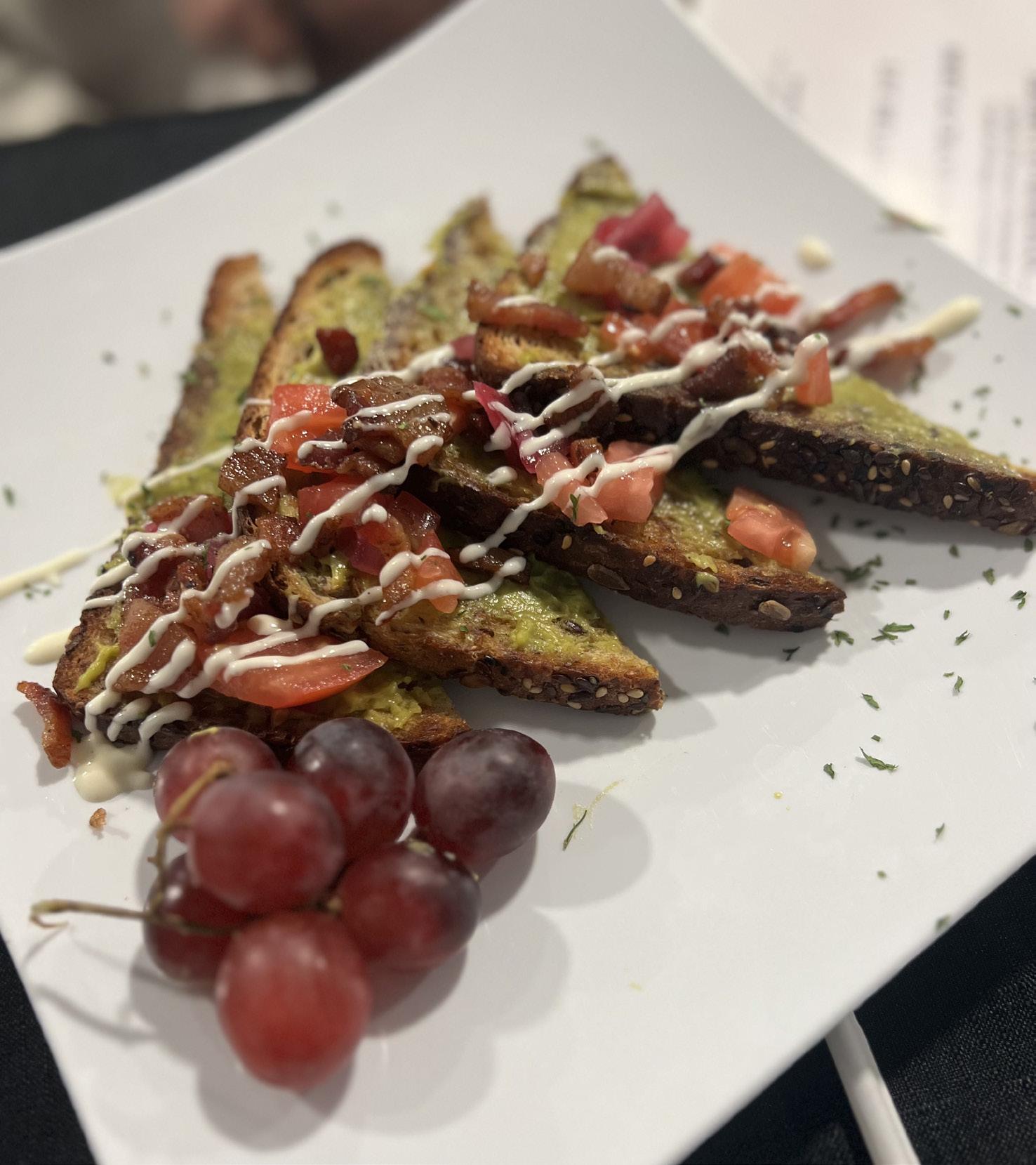
elet itself was a little overcooked and flavor-wise was nothing more than your typical home-cooked breakfast. Furthermore, perhaps because of our selection of rich toppings, the omelet felt a bit heavy in our stomachs. Still, the most disappointing part of this meal was the lack of a potato side, something I think many brunch-goers would expect from an egg-centered meal.
Even more so than the food, the aforementioned vibes of the establishment confused us. Even after having an entire meal there, we struggled to determine if Sunset Kitchen is supposed to be a restaurant, bar or nightclub. As mentioned earlier, the restaurant itself looks like a club, with random mirrors, slick white walls and modern-looking furniture and accessories. At the front of the restaurant there was also a full bar. Yet in spite of all of those things, the ample amount of tables and chairs would lead you to believe it was a very sit-down restaurant experience. With the decor of a club or bar and yet accommodation for a fine-dining experience … what exactly is this restaurant? What niche is it fulfilling on the Euclid strip?
off-putting aftertaste that we could only describe as being a bit bitter. Even with the apple topping and copious amounts of syrup, it was impossible to overcome this uncomfortable experience. In addition, the challah bread was itself a bit stale. And while the French toast overall was passable, the chicken wings on the side were quite underwhelming. They were well-seasoned with a peppery Cajun blend, but the meat itself was dry and difficult to chew. The combination of over-the-top apple French toast and chicken wings is still something we cannot fully wrap our heads around.
Build Your Own Omelet
To cap off our meal, we enjoyed a cheese and bacon omelet. While there was a sufficient cheese pull, the om-
Even considering it a full sit-down experience, the restaurant’s finishings felt a bit tacky. This was from the cheap tablecloth to the uncomfortable bench seating—everything had a sterile plastic aesthetic. When we think of cute places to grab brunch, Sunset Kitchen’s atmosphere is definitely not what comes to mind—especially with many other cute bakeries such as Luna’s around campus.
All this being said, while Sunset Kitchen may not have soared to the top of our restaurant list, their food is decent. Especially if you are looking for a different ambiance in the University Circle area, Sunset Kitchen offers a sit-down dinner experience that won’t break the bank. Plus, Sunset Kitchen is still only in its opening stages, and we hope the experience will continue to improve with an expanded menu and customer base.
Additional reporting contributed by Director of Business Operations Khushali Desai.
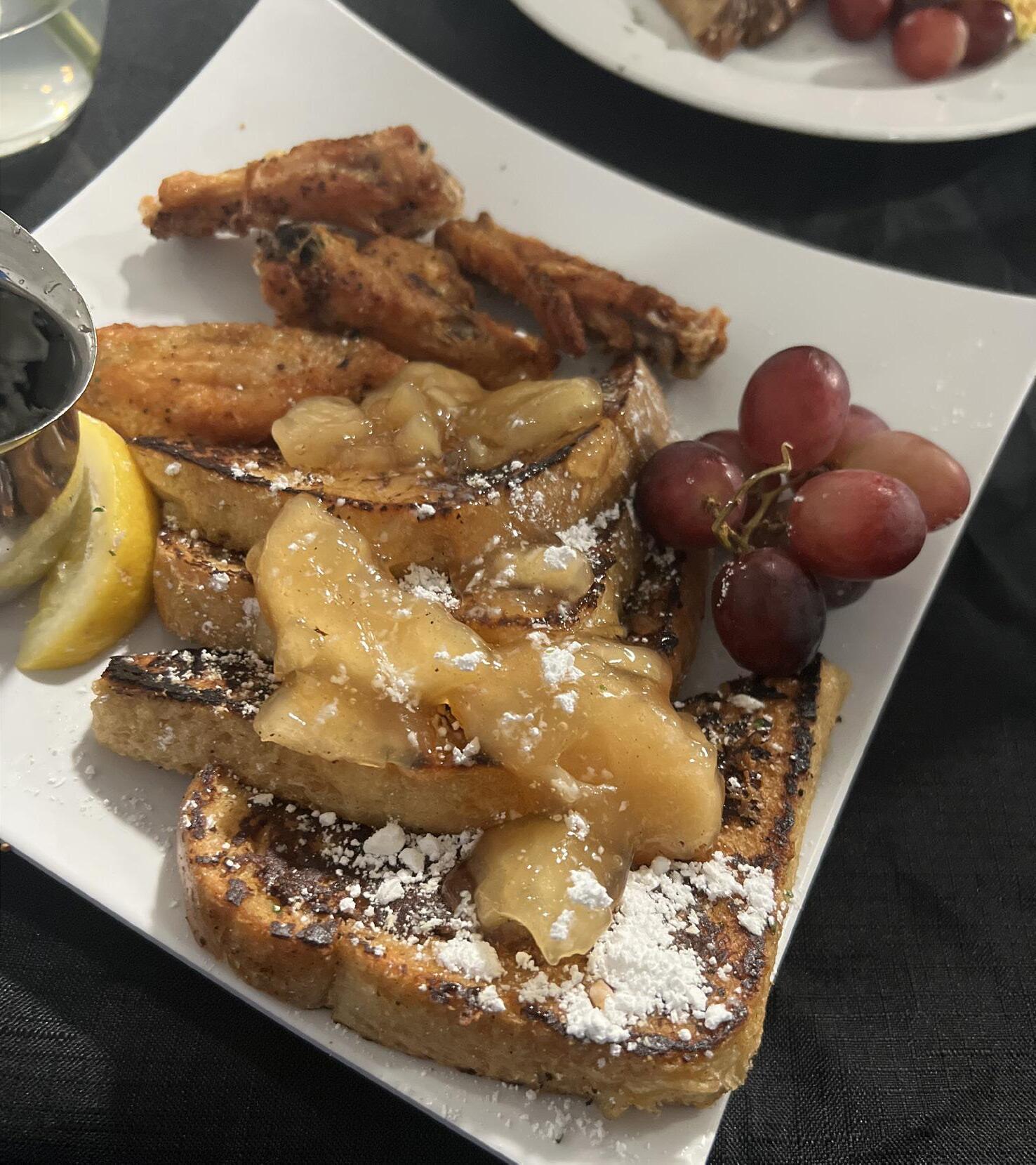
Shejuti Wahed Social Media Content Creator
As summer rapidly approaches, Case Western Reserve University’s favorite treat is coming back with the warmer weather. Follow the floating bubbles in the streets of Little Italy towards Mount Granita, a cozy Italian ice place with vibrant neon signs and bright summer colors. Now boasting
20 fresh flavors, Mount Granita is reopening on Wednesday, May 1, from 5-10 p.m. with $1 dollar junior scoops on their opening day.
Co-owners Chris Giancola and Jonah Bae initially started Mount Granita as a sidewalk cart business, but Giancola says he never could have dreamt of their success at their storefront today. Long before even their cart had opened, granita had been a long tradition in the Giancola family. Chris
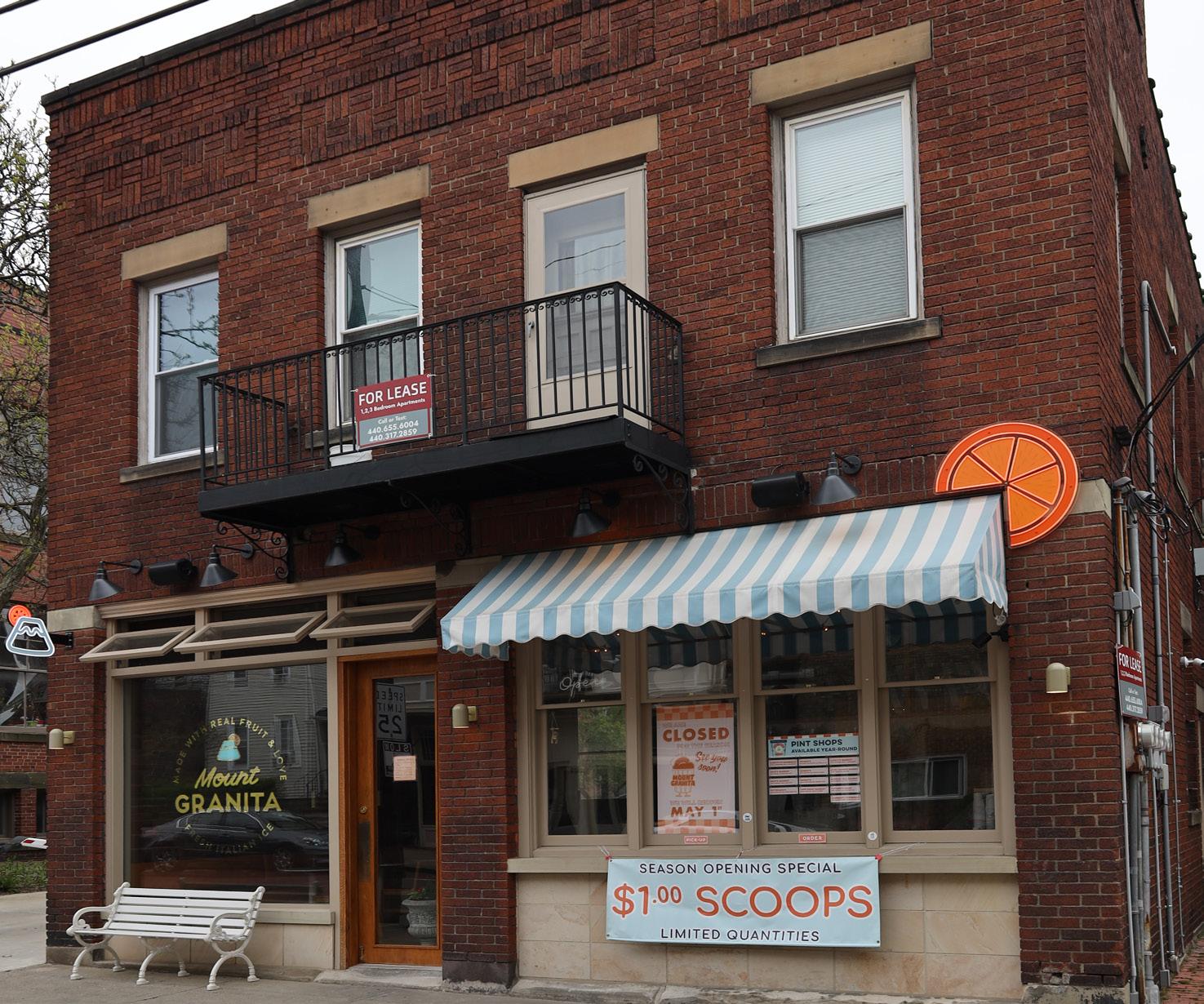
Mount Granita, a local Italian ice shop, is re-opening its doors this summer, offering $1 junior scoops on opening day. The business was started during COVID-19 by two spontaneous college students eager to share their love for the frozen dessert.
Clay Preusch/The Observer
has fond memories of his great-grandmother crafting a makeshift granita in her Sicilian hometown when they would visit. Combining espresso, milk and cream, she would store this mixture in the freezer and scrape the dish every few hours, leading to a chunky ice consistency that he used to cherish as a child. In the ’50s, Giancola’s family immigrated to the United States and continued to work in various food-related businesses. In that way, culinary pursuits have always been in Chris’s roots, but it was only at the start of the pandemic that Chris and Jonah began their own ventures.
With their university classes completely online due to COVID-19, and graduation so close ahead, Chris describes Mount Granita as a completely spontaneous conception. He suggested to Jonah, “Let’s just do something. Things are crazy right now; we can’t be strung up inside all the time.” The two knew from the start that they wanted to do granita—they had always gravitated towards frozen desserts, and they loved the granita they had tried on their travels to various places, from New York City to Chris’ grandparents hometown.
The scene for Italian ice in Cleveland was very sparse and much less the authentic richness of granita that Chris was looking for—so Chris and Jonah decided to do it themselves. Chris describes a three-ring spiral notebook that quickly became filled with recipes, ideas and trials of different versions of granita. Their first flavor, lemon, took around 20 to 30 attempts before the recipe was perfected, and their dream for a Moscow mule flavor still needs to be revisited. But their dedication toward finding
a consistent flavor seems to be well worth the effort, as each flavor on their menu has a rewardingly fresh taste, completely free of artificial additives.
“Pure fruit, cane sugar and that’s it. No shortcuts,” Chris told me.
Mount Granita’s cart opened the week after Chris graduated from college with his Bachelor’s, so in his words, it was “a cool thing to happen all at the same time.” Since then, Mount Granita has expanded to its storefront on Murray Hill Road and has become a favorite of CWRU students and locals alike. One of their busiest days was their fall season closing, when the people who had become regulars throughout the summer all showed up on their last day. So many crossovers and combinations of the people who had become their friends over time came together for “almost what felt like a big party,” Chris recalled.
Although their regular crowd is usually CWRU students and the Cleveland community, dessert lovers from farther away are starting to notice the place’s popularity. Chris remembers a student who used to drive hours to come to Mount Granita because they missed the granita so much after having traveled abroad in Sicily. They would later bring back home pints to share with friends and family.
Luckily for the CWRU campus, Mount Granita is closer and definitely a must-try as a quick refresher before finals consume the rest of your semester. Stop by Little Italy on May 1 for a dollar junior scoop if you are curious about granita and want to give it a try. Fair warning, though—once you experience Mount Granita once, the temptation to return will be undeniable.
Kethan Srinivasan Social Media Content Creator
It seems that Taylor Swift is the most famous woman of our time. In the months leading up to April 19, expectations were high among critics and sycophants alike after the singer-songwriter’s announcement of her 11th studio album, “The Tortured Poets Department.” And for good reason—Swift has cultivated a reputation for impeccable songwriting and worldbuilding that has had critics singing her praises. Apart from her artistic reputation, Swift has also been called a phoenix rising from the ashes, a snake, a college course subject, a victim of corporate wrongdoing and, finally, a boon to local economies with her record-breaking stadium tour and concert film.
With all that has happened to her in the past few months, Swift’s recent declaration, “I have never had an album where I needed songwriting more than I did on [TTPD]” starts to make some sense. The album’s length and lyricism makes this claim apparent. However, TTPD leaves many listeners with less praise and more questions over its necessity. Instead of a cohesive record with ballads or anthems, TTPD is a shoddy novella on breakups with a whopping 31 songs, each one varying massively in lyrical and sonic quality, overloaded with metaphors and references that start to wear out quickly.
In breaking down both the main album and the additional tracks released in the early hours of the following
morning, dubbed “The Anthology,” a number of juvenile lyrical choices are apparent. The guiltiest of offenders is the title track itself with its clunky stanzas that include lyrics such as “I scratch your head, you fall asleep / Like a tattooed golden retriever” and “At dinner, you take my ring off my middle finger / And put it on the one people put wedding rings on.”
Similarly, “But Daddy I Love Him” details Swift’s surprising lack of maturity and her desire to grow on her own terms, out of sight from her detractors and self-righteous critics. It’s a perfectly juvenile take when you realize the “him” in question is the 1975 frontman and juggernaut of controversy, Matty Healy. “Florida!!!” sees Swift finding her escapist fantasies in a rather illfitting place, accompanied by Florence and the Machine’s Florence Welch and her haunting vocals. The track is let down by unimaginative lines such as “And my friends all smell like weed or little babies” or “Florida / Is one hell of a drug / Florida / Can I use you up?”
There are some hidden jewels to be found, however, if you listen long enough. Songs including “Who’s Afraid of Little Old Me?” “The Smallest Man Who Ever Lived” and “Clara Bow” showcase Swift’s penchant for writing when it is executed well, with their lyrics revealing the philosophical, vulnerable and meaningful artist who is missing throughout the rest of the main album.
The release of “The Anthology” reveals another defining factor that may explain the divide among some fans: its production. Much of the main al-
bum is dominated by producer Jack Antonoff, a frequent collaborator with Swift, as well as of Lana Del Rey and Lorde. This will most likely explain why the album feels more like a regifted knockoff of “Midnights.” However, many of the songs from “The Anthology” are created with Aaron Dessner, best known for his work on “folklore” and “evermore.” As a result, we receive
more impactful songs than the original, such as “The Black Dog,” “The Albatross” and “I Hate It Here,” albeit not without typical missteps such as the childish title choice for “thanK you aIMee,” a song addressed to a past tormentor, though not the one the public immediately thinks of.
There is no negating the reality of Taylor Swift’s stardom and her ca-
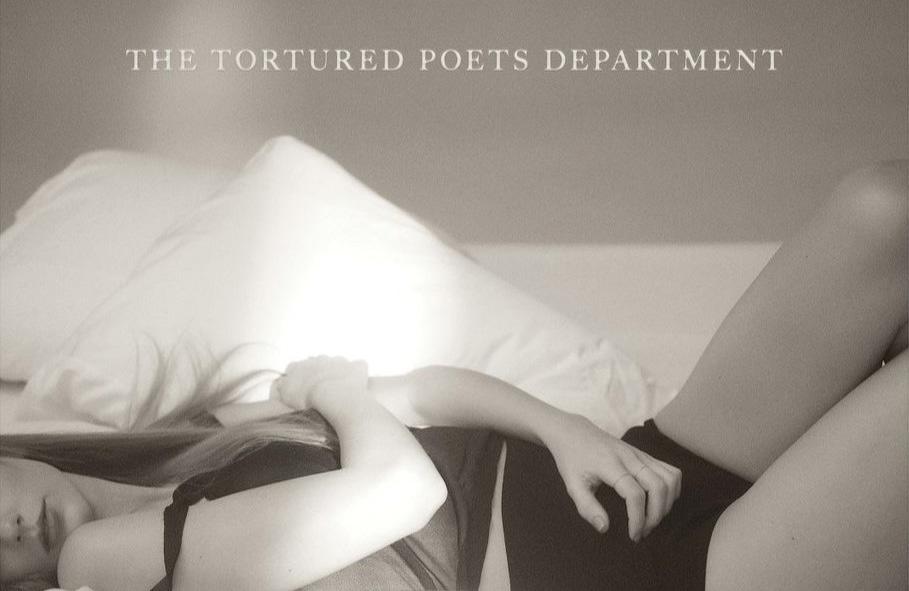
Folk and pop sensation Taylor Swift disappoints fans with underwhelming and juvenile lyricism in her 11th studio album “The Tortured Poets Department.” Courtesy of Republic Records pabilities as a writer. However, “The Tortured Poets Department” seems to elicit a wake-up call, one that makes listeners wonder if the celebrity lore and negative public opinion is the driving force behind her writing and
whether that force is the reason why the well-crafted lyricism that Swift has dedicated her life to has all but dissipated here. Is this what it means to be a tortured poet, or is this simply torturous poetry in need of editing?
Anna-Sung Park Contributing Writer
Saturday, April 20, 7:15 a.m. No wise Case Western Reserve University student wants to be up that early, yet a flock of seven—myself included—was gathered on a bench outside Veale Recreation Center. While eating slightly stale muffins, apples and other food grabbed from Fribley Commons, the CWRU Kung Fu Club shivered from both the cold and anticipation. We were headed to the 32nd Annual Great Lakes Kung Fu Championship and the United States Shuai Chao Nationals, an international tournament held a mere half hour away from campus.
Great Lakes, as the competition is usually called, has been held in Cleveland for more than three decades. Attracting schools and competitors from as nearby as CWRU and as far away as California and Canada, it has over 100 competitive divisions, including forms—a series of linked moves and stances designed to practice defensive and offensive moves in a quick, clear manner—and shuai jiao, a form of traditional Chinese wrestling. While our student competitors stuck to forms, both with weapons and without, with a few brave souls hitting the mats for shuai jiao, the tournament also offers light contact sparring, full contact sparring called san shou, tai chi, bagua and other styles of martial arts.
At the CWRU Kung Fu Club, we are students first, which places us at a distinct disadvantage to many competitors. Anyone reading this article will know how busy CWRU
students are, and finding time to go to practice can be exhausting. However, it is something that the members look forward to. As club treasurer, Yi Zhang said, “It’s like a reward.” Zhang and I are currently battling our way through the dreaded sophomore spring of the nursing program and use the Tuesday, Thursday and Saturday practices to work off stress and focus on something other than academics.
At the competition, the gymnasium was filled with dauntingly large crowds of opponents and observers. Personally, I was surprised at how many children were participating in shuai jiao. One of the major components of shuai jiao is grasping at the jacket that competitors wear and using your opponent’s momentum and your own body mechanics to throw them to the ground. Some of the children had to have been as young as four years old, and some were as old as high schoolers.
Only one of the members from CWRU Kung Fu had been to Great Lakes before. The rest, myself included, had never been to a kung fu competition before. Luckily, we were not pitted against sifus and masters. Divided by years of experience, our members competed in novice, beginner and intermediate levels. Shuai jiao is separated by and bracketed within weight classes. These divisions allowed our students to compete against people both older and younger than we are while still being of equivalent skill levels.
Some highlights of the competition included meeting several members of the Canadian National Shuai Jiao team, watching one of CWRU Kung Fu’s own instructors
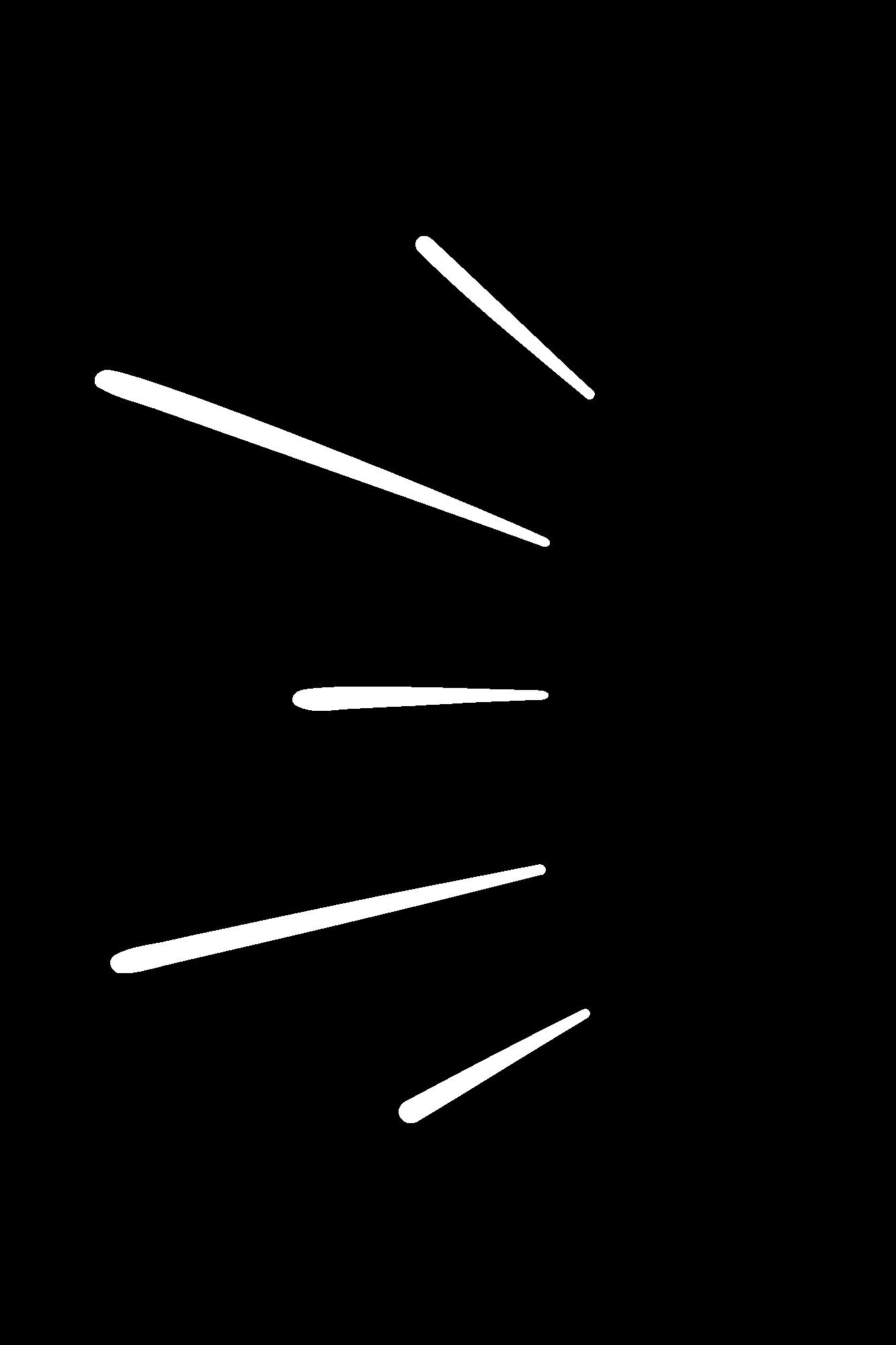
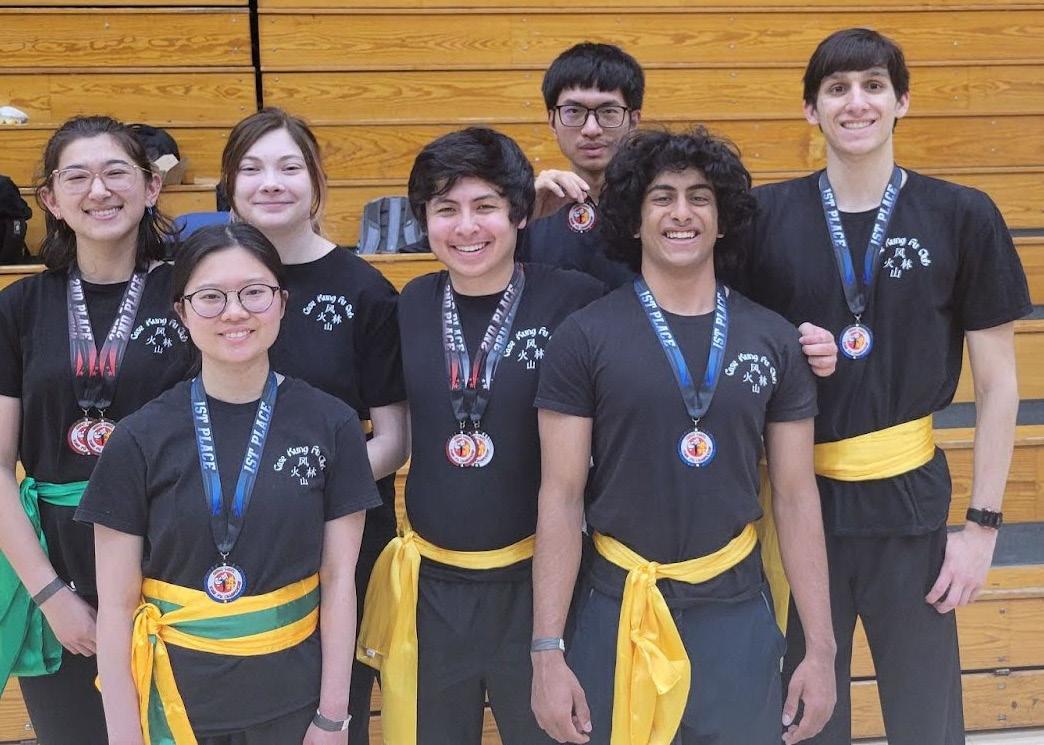
On April 20, seven CWRU students from the Kung Fu Club had a rewarding experience at the 32nd Annual Great Lakes Kung Fu Championship. Courtesy of CWRU Kung Fu Club
compete in the advanced forms division and experiencing the adrenaline rush of stepping up to the floor and bowing to the judges before starting the form or fight.
CWRU Kung Fu has attended Great Lakes for almost twenty years—an impressive feat, especially when the club just hit its 21st year. Traditionally, students do very well, and those of us who went this year continued that streak, winning a total of three gold, four silver and two bronze medals. I had never met the vast majority of people in the room, yet the second anyone heard we were from the CWRU Kung Fu Club, we were welcomed with large smiles. In addition to the club’s instructors being
CWRU graduates, there were plenty of other club alumni present as well. Many CWRU alumni continue to stay connected with this martial art after college. For example, one alumnus had come down from Chicago with his wife to compete, while another alumnus had even helped organize the competition and facilitate shuai jiao matches.
All in all, students from the CWRU Kung Fu Club had an excellent time at Great Lakes, winning several categories, sweeping another and placing highly in others. As students of both academics and kung fu, we look forward to learning and stretching our boundaries even further when we return to the competition floor.


Weekly
Horoscope
Aquarius
Finishing that last SAGES
Pisces
Self-discovery
Aries
Geological research
Taurus
Absolutely nothing
Gemini
Traveling Europe
Cancer
Interning at Goldman Sachs
Leo Insane gym arc
Virgo
Volunteering at a soup kitchen
Libra
Living in the woods
Scorpio
Studying for the MCAT
Sagittarius
Spending too much time at your high school reminiscing on “the good old days”
Capricorn
Catching up on sleep
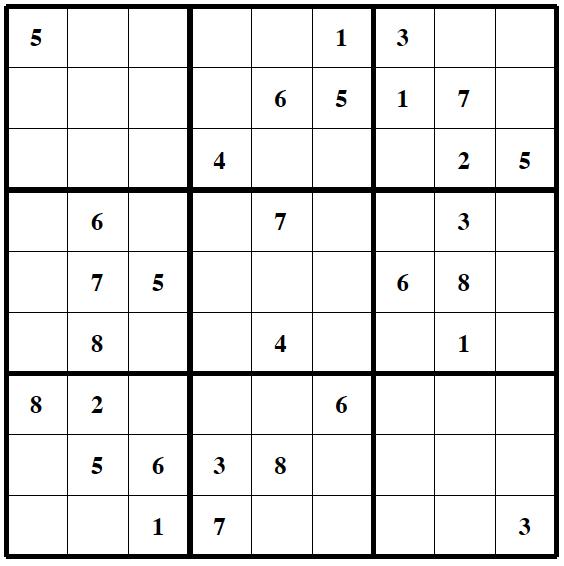

Compilation of out-of-pocket things heard across campus
"My lil baby didn't learn how spell his name till he was 20."
"Where do you exist on the slutslay continuum?"
"Are you a furry, Noah?"
"It's supposed to be sexy."
"Amenities? no. amen. titties."
"It's a show your true self type dance."
"Who the f*ck is Director of News?!?"
"Is your whole family Chinese?"guy rizzing girl on RTA
"Do you think Beau is short for beautiful?"


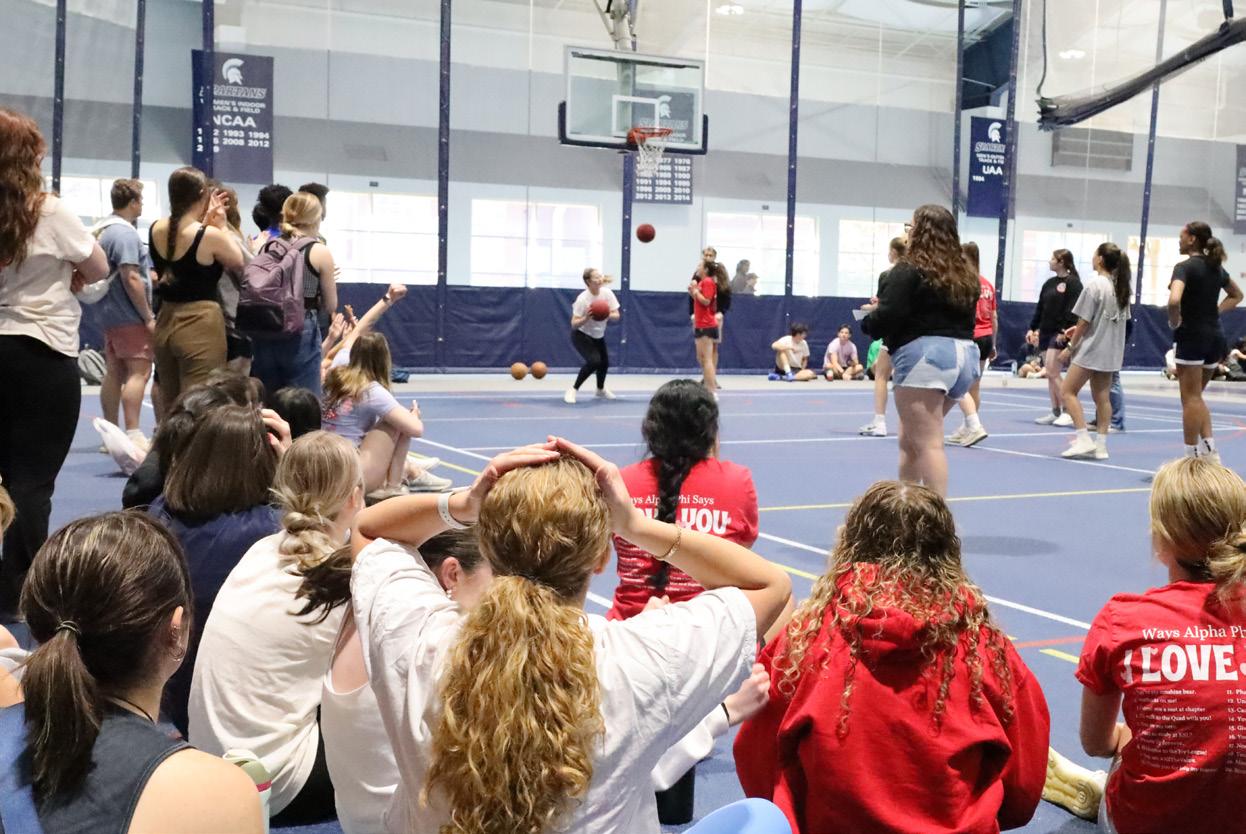
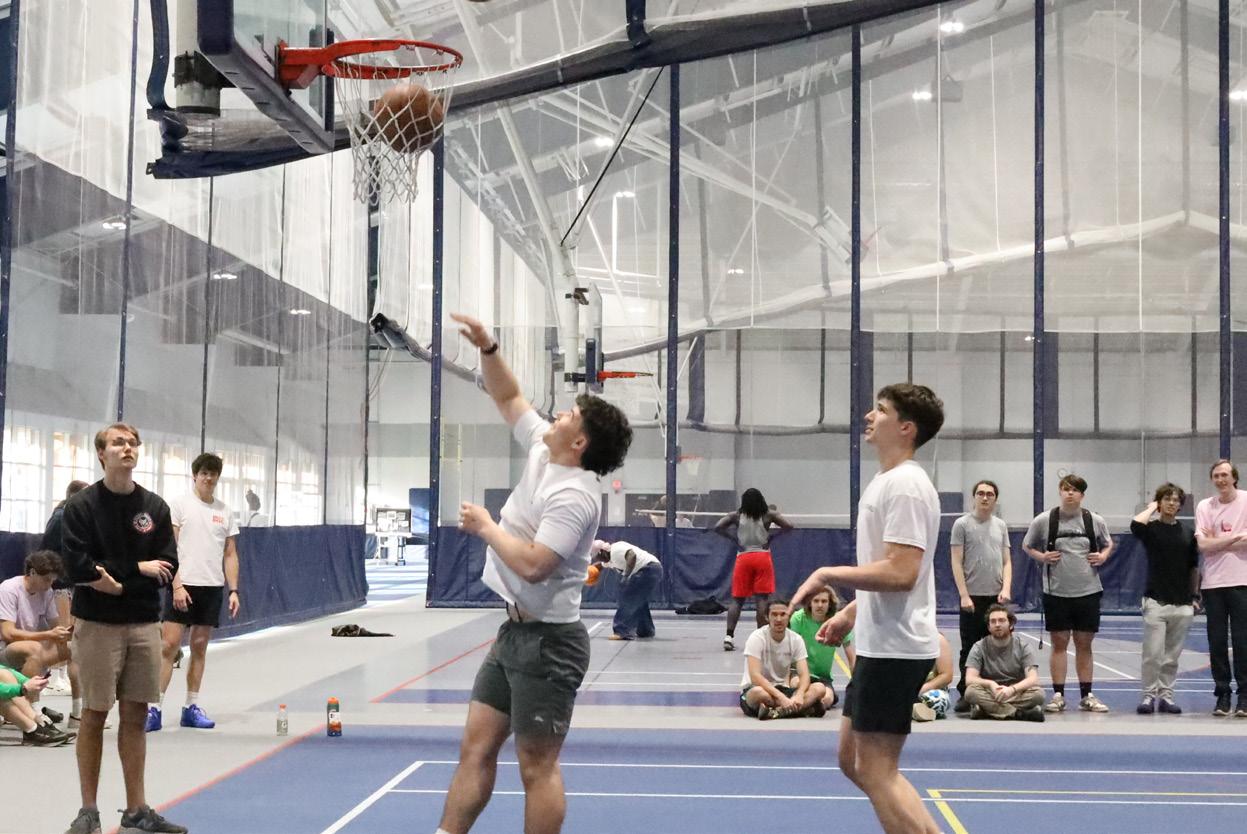
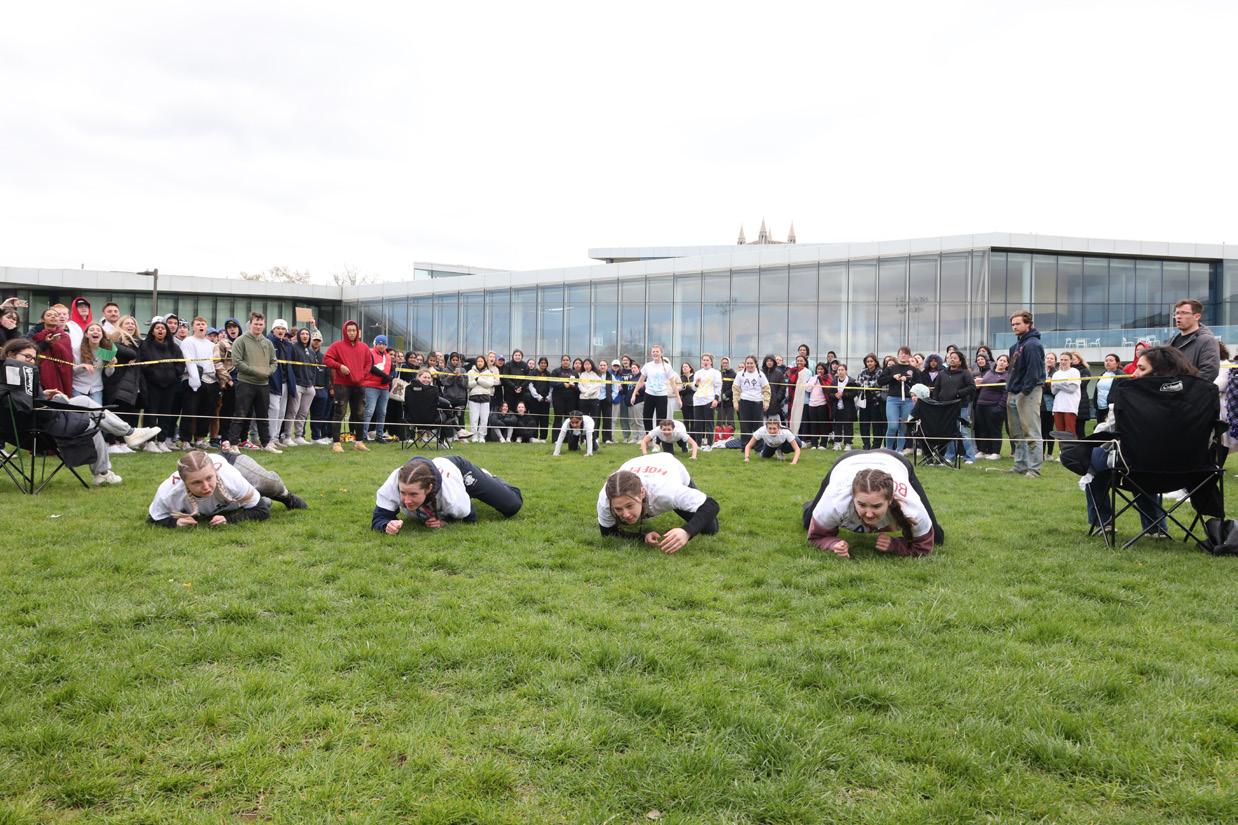
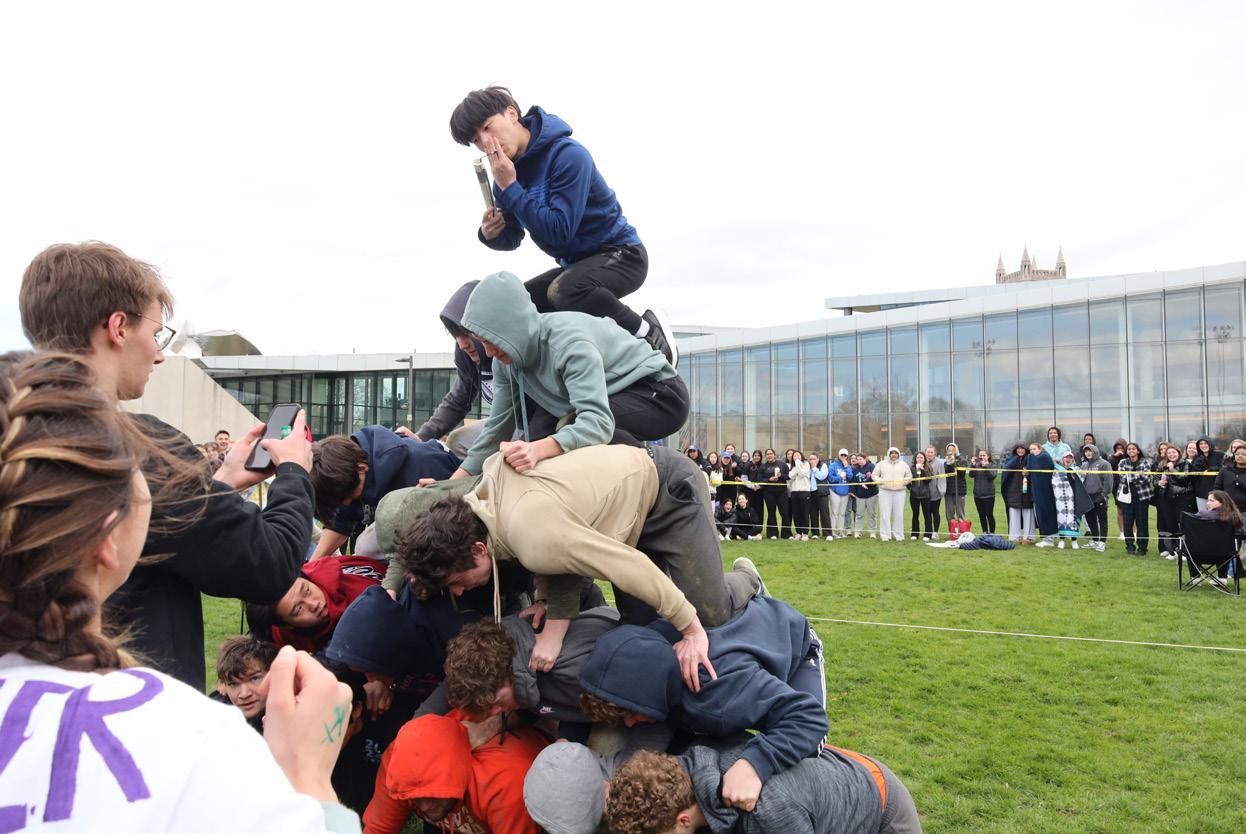
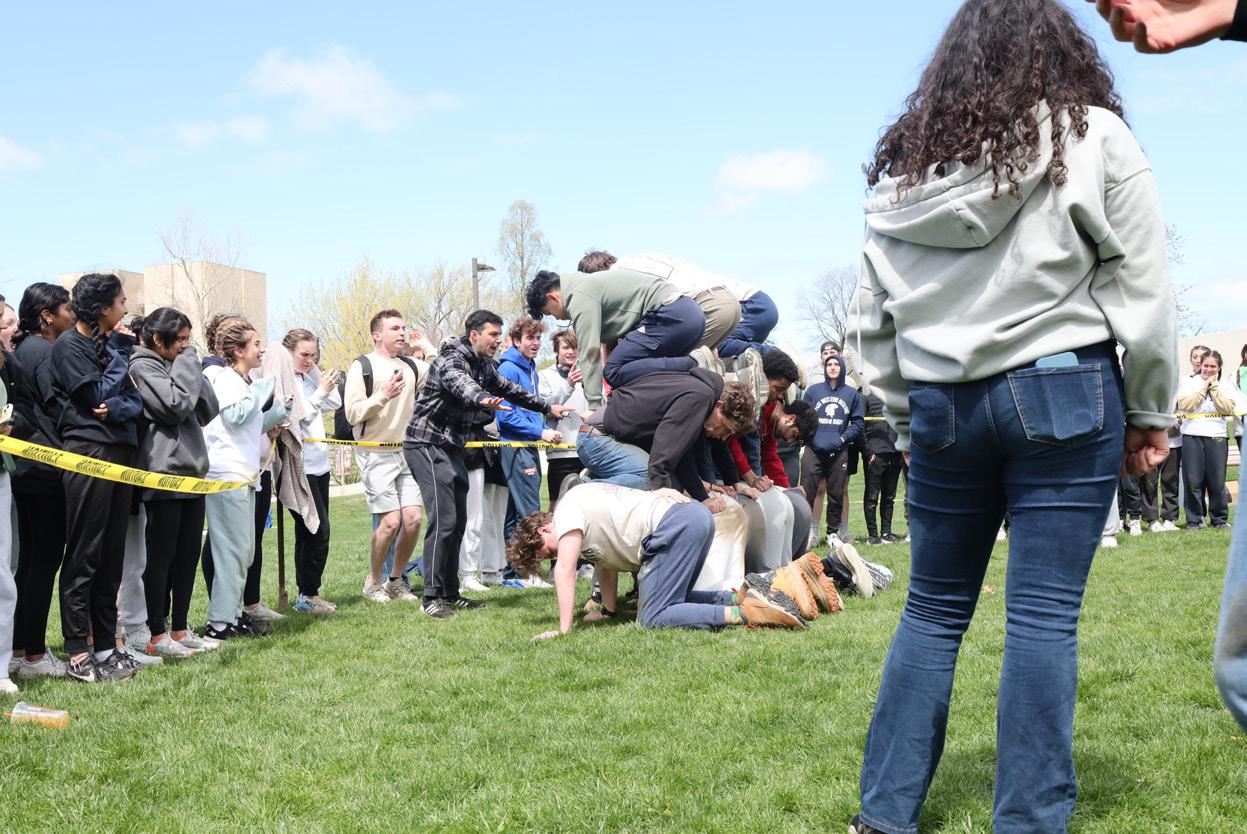
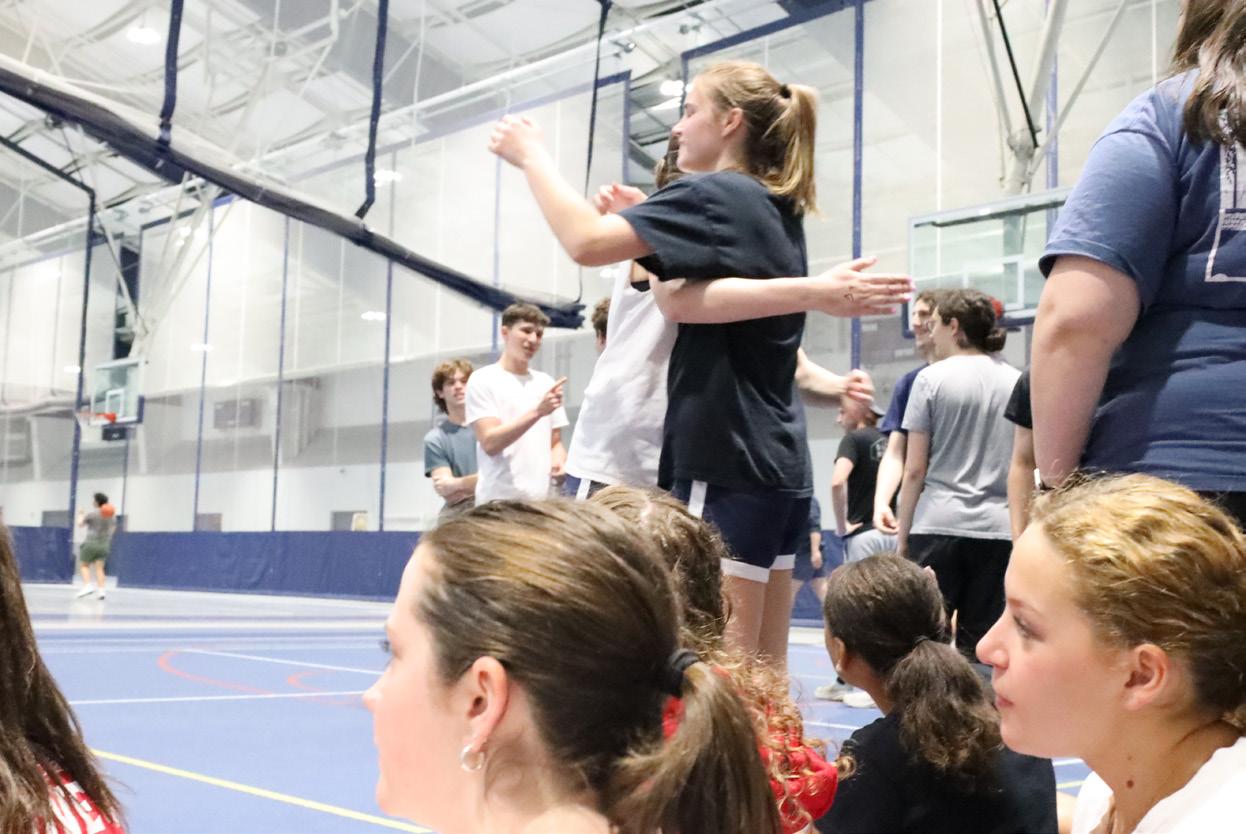
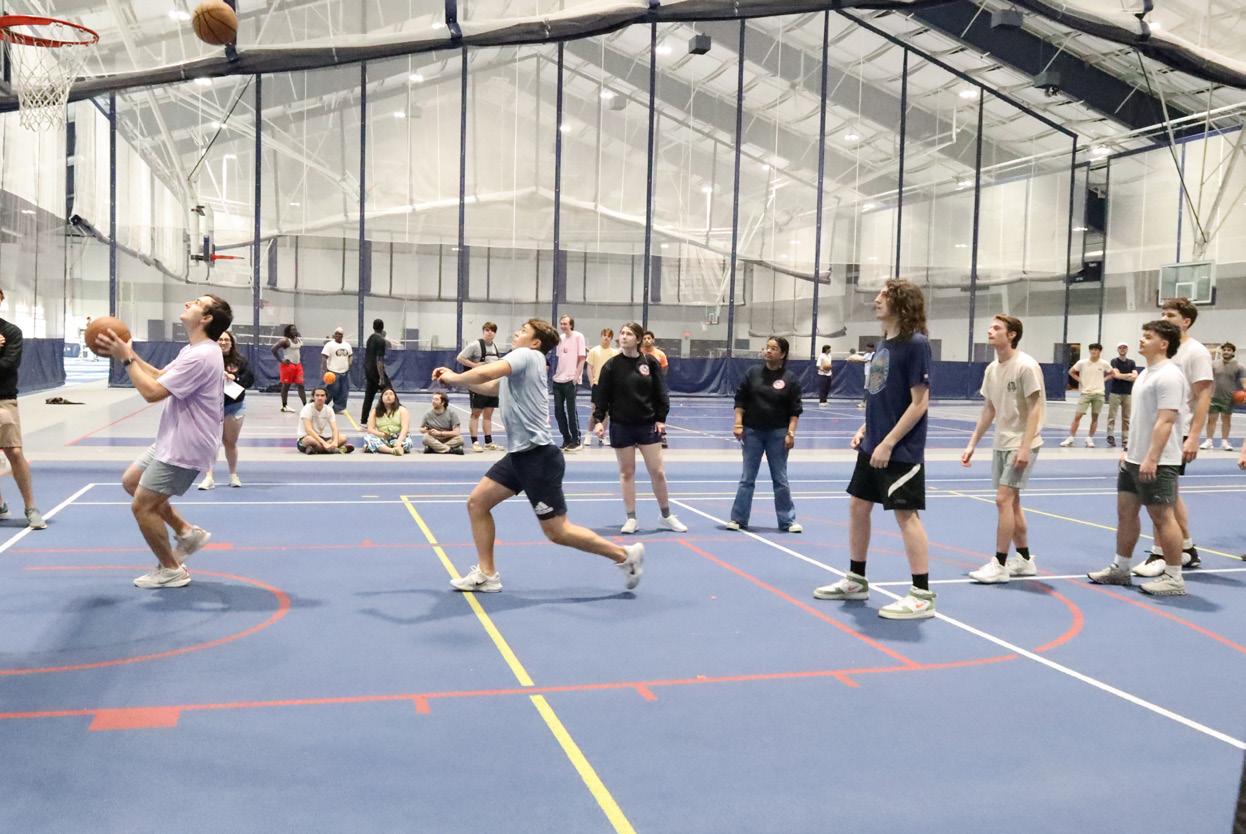
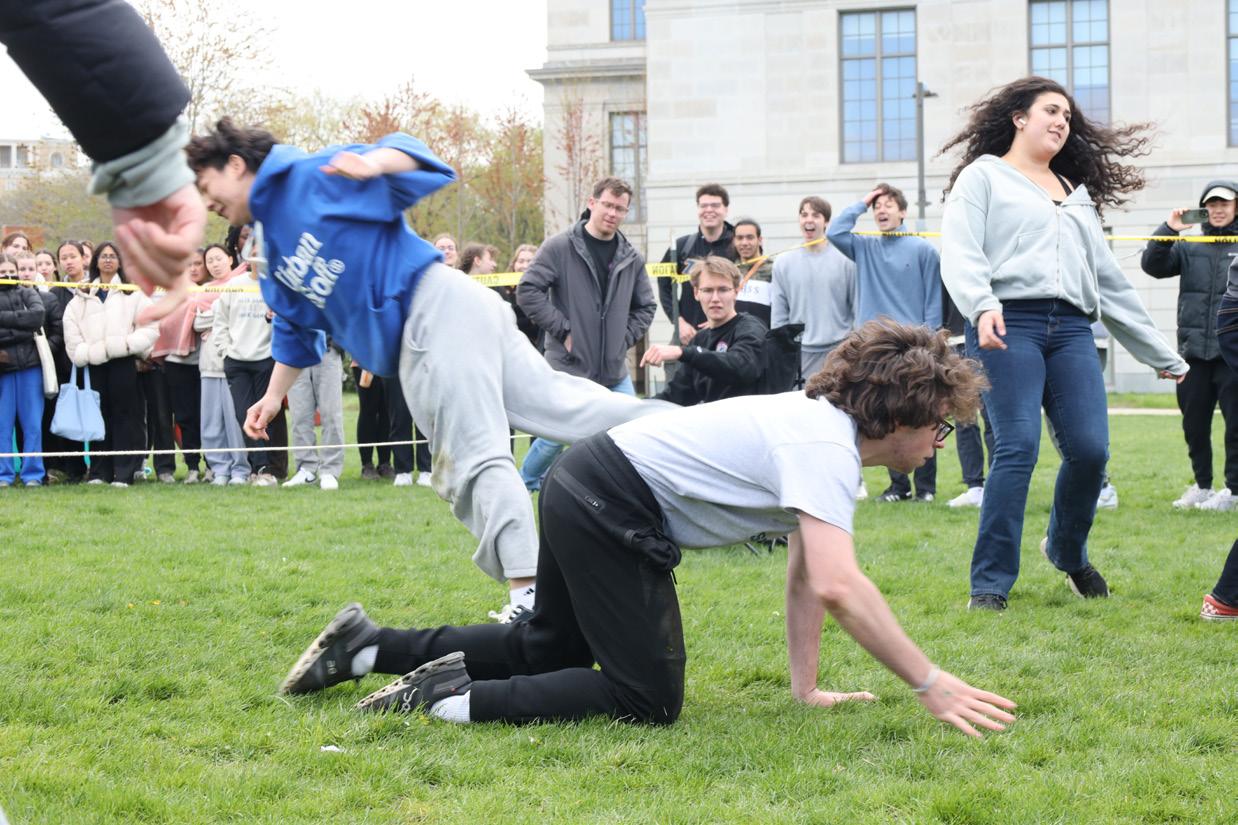
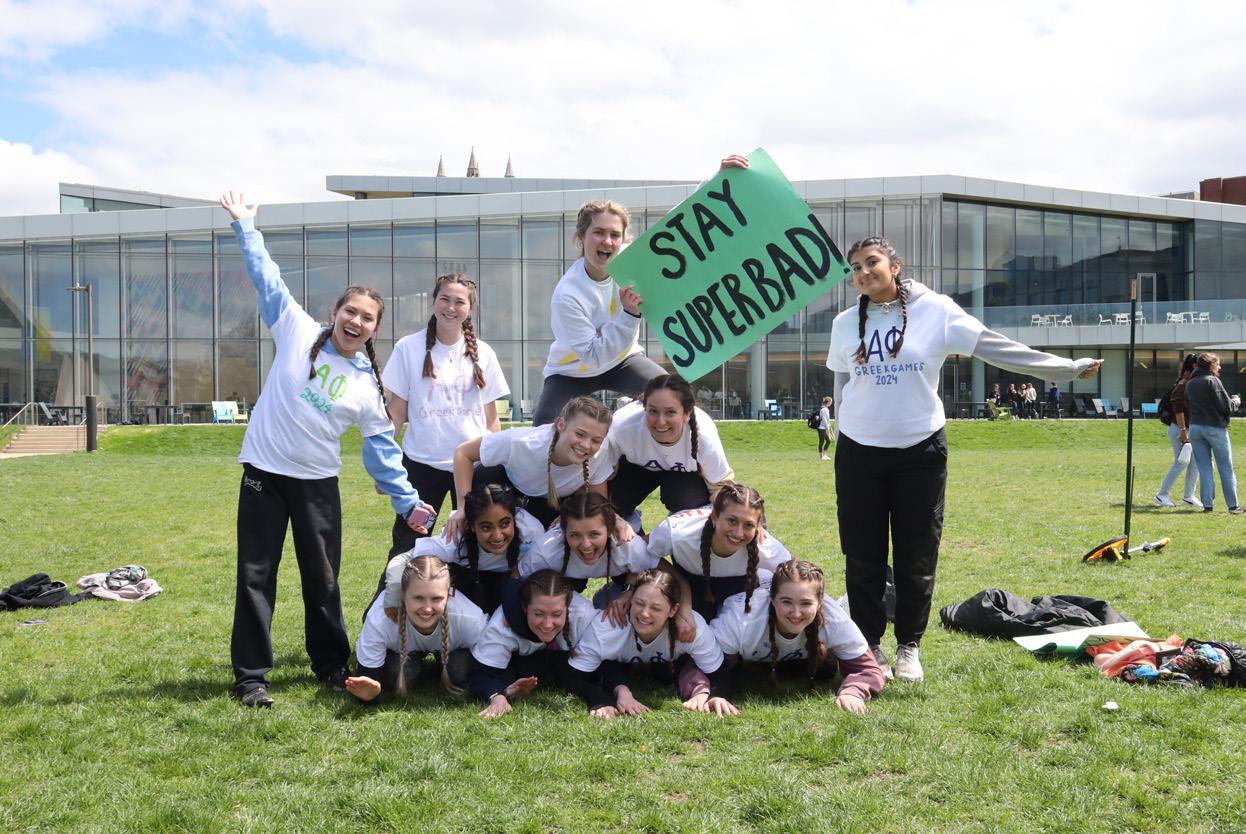
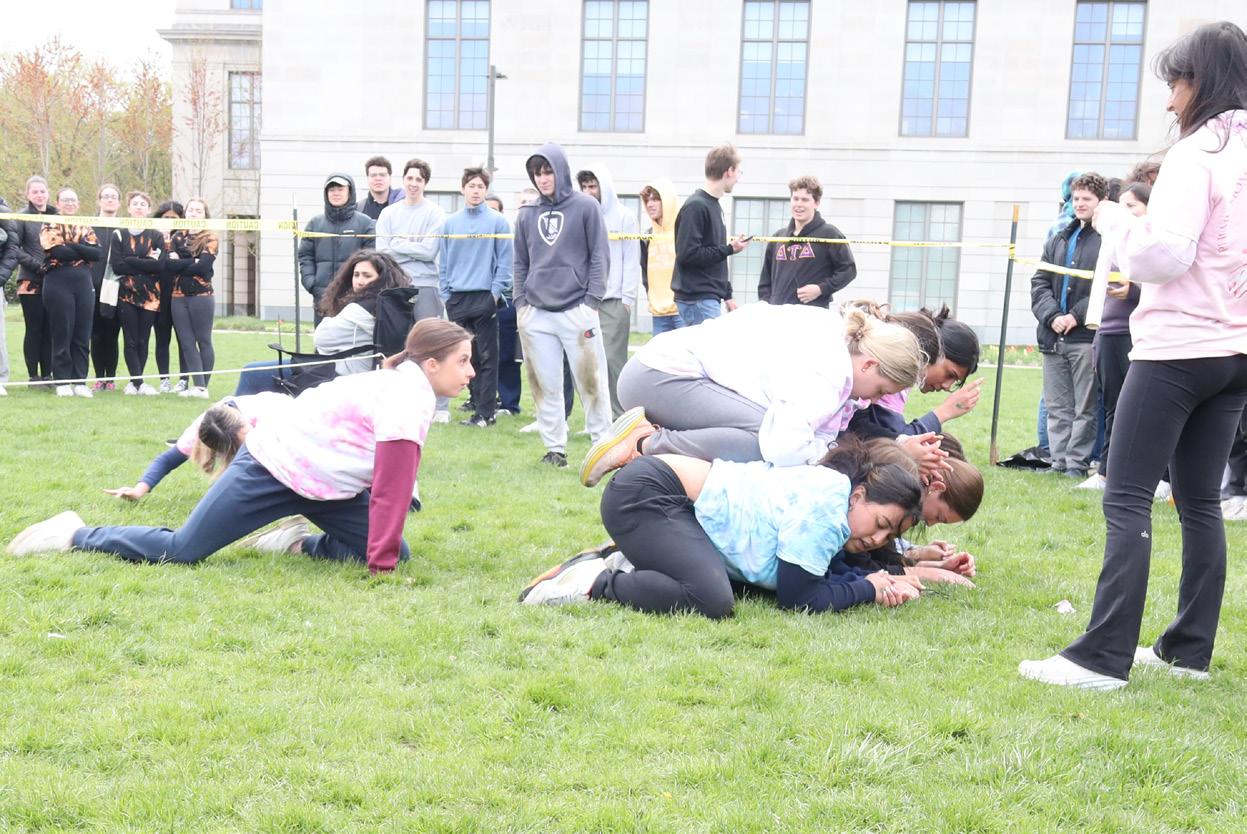
I think that is the wrong direction...
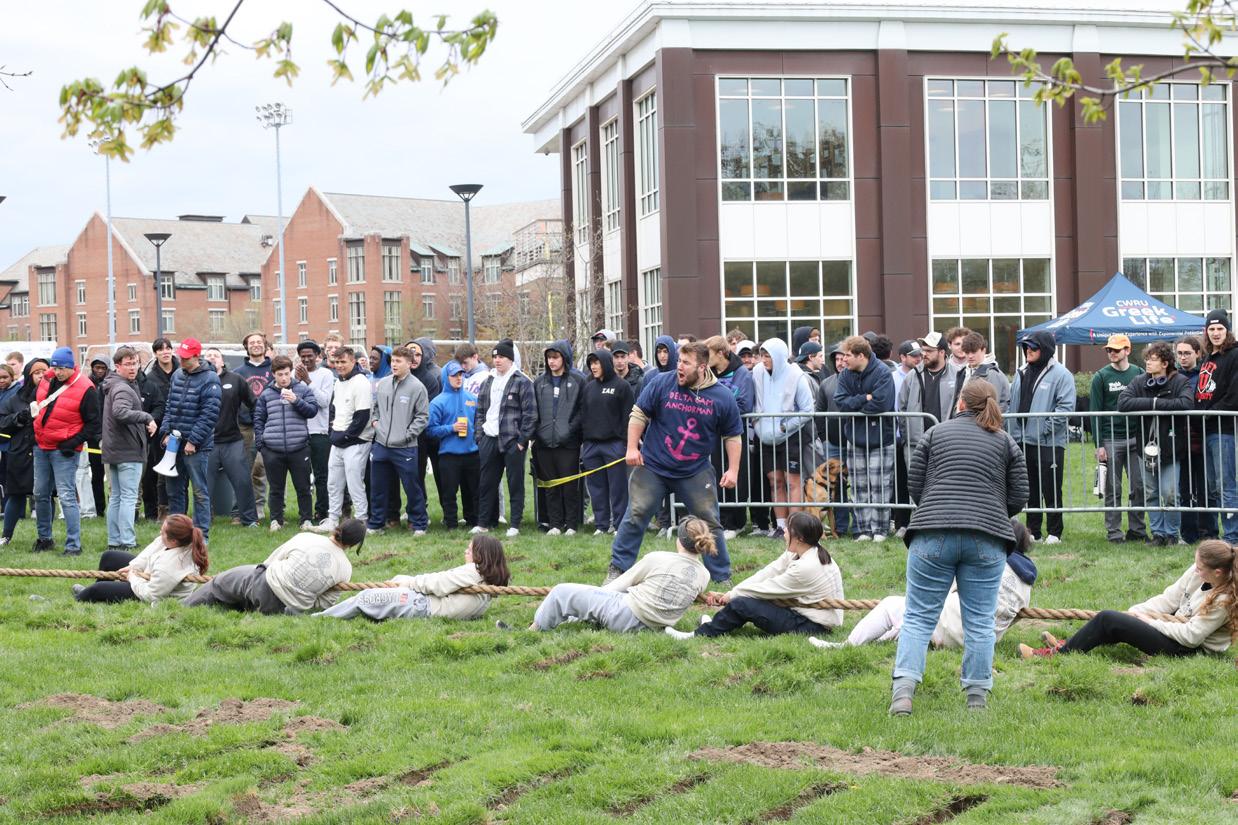
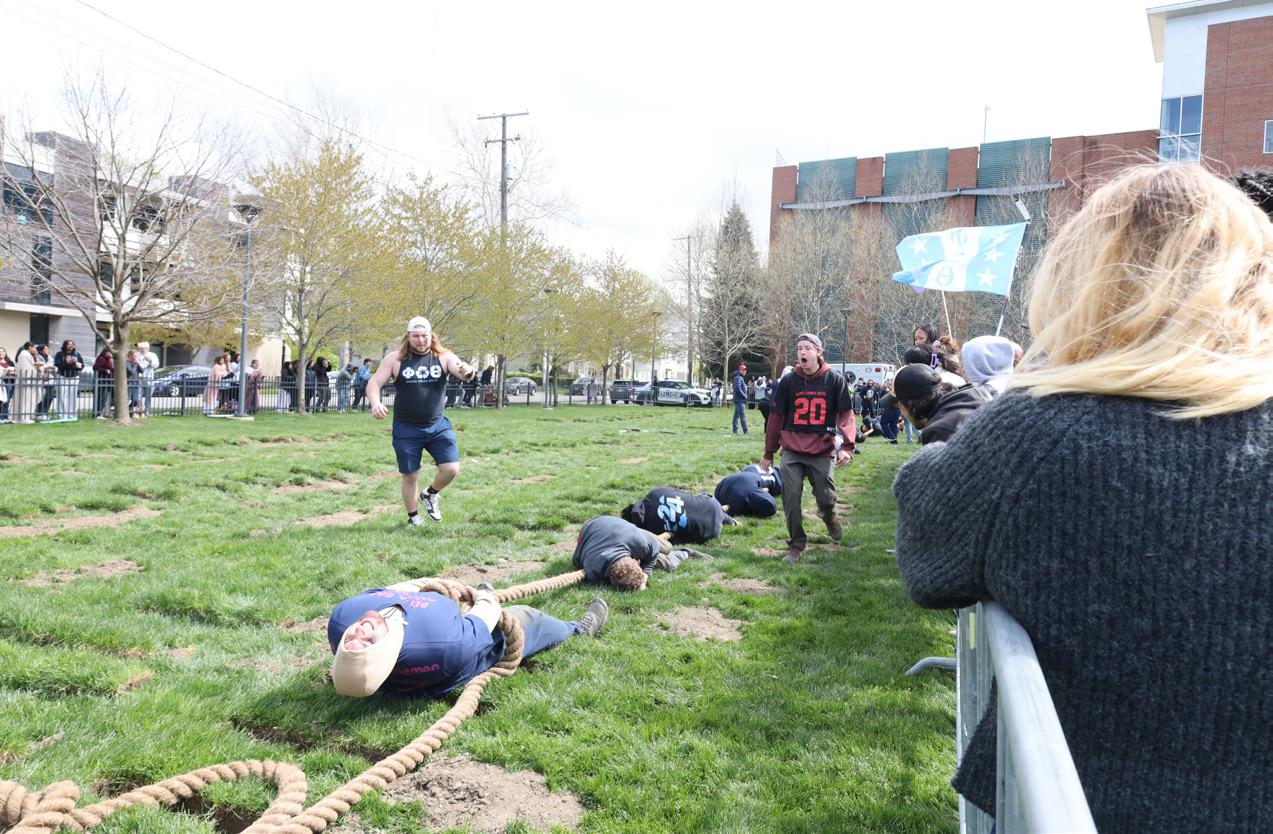
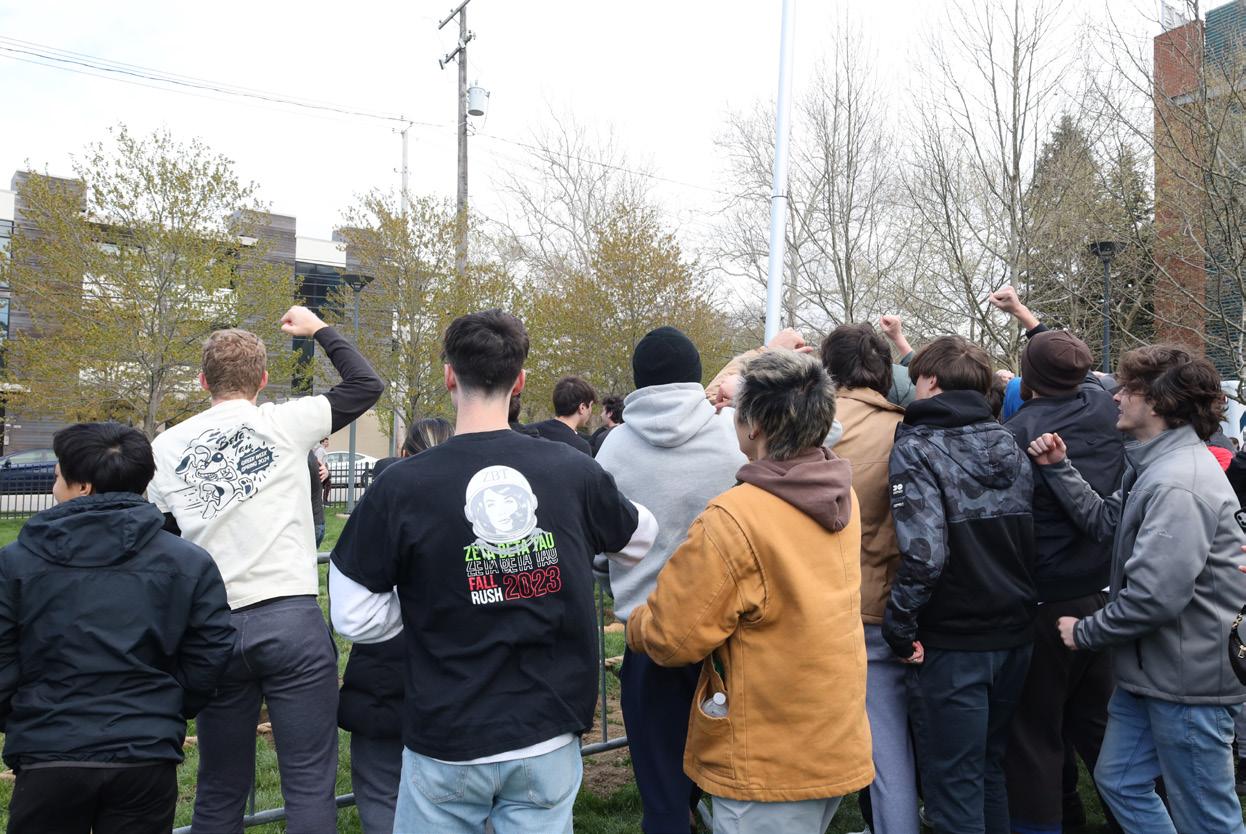
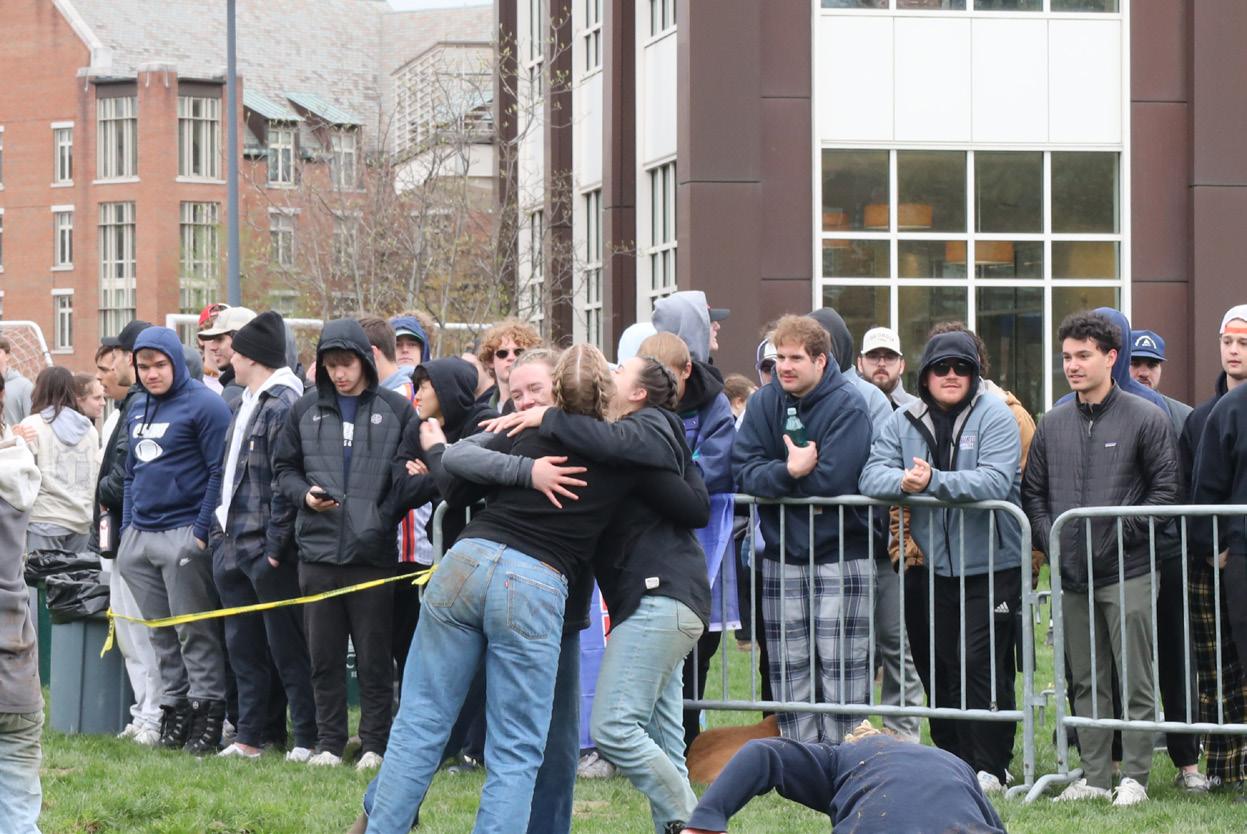
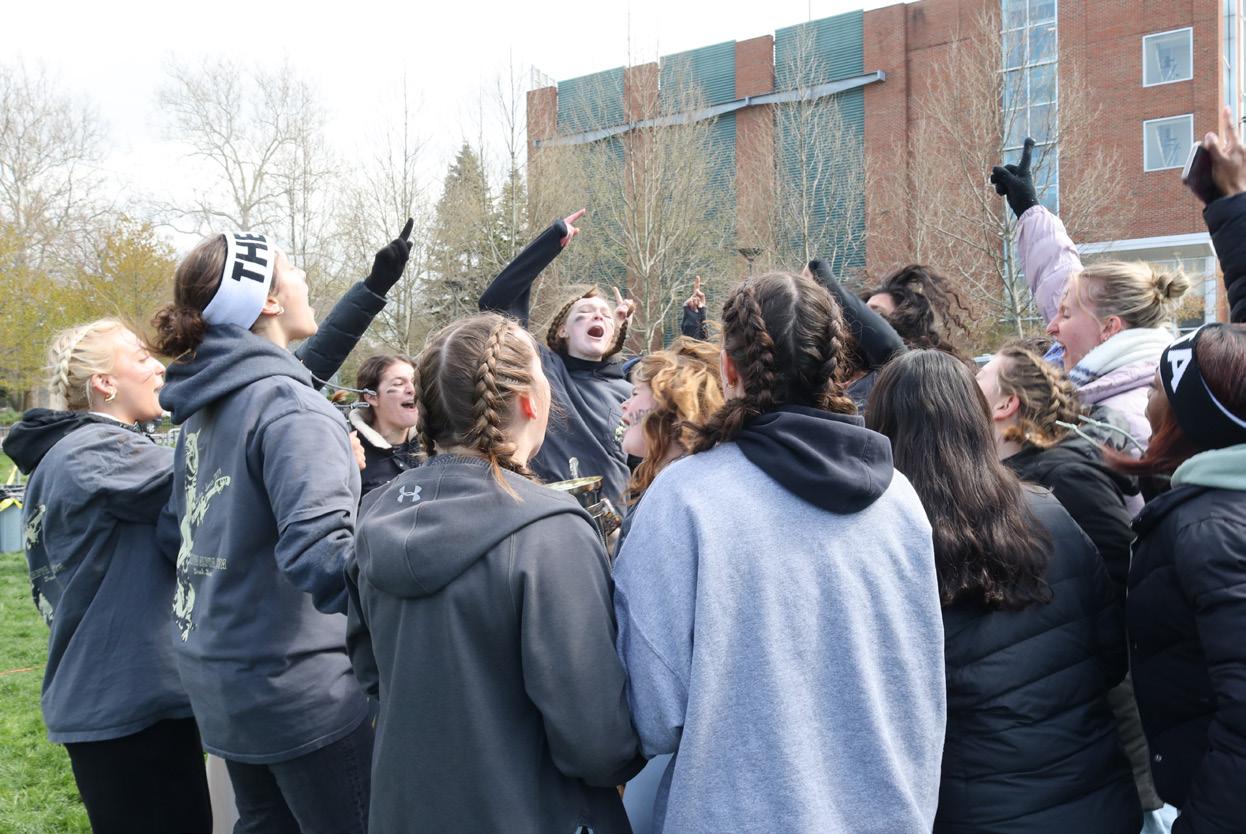
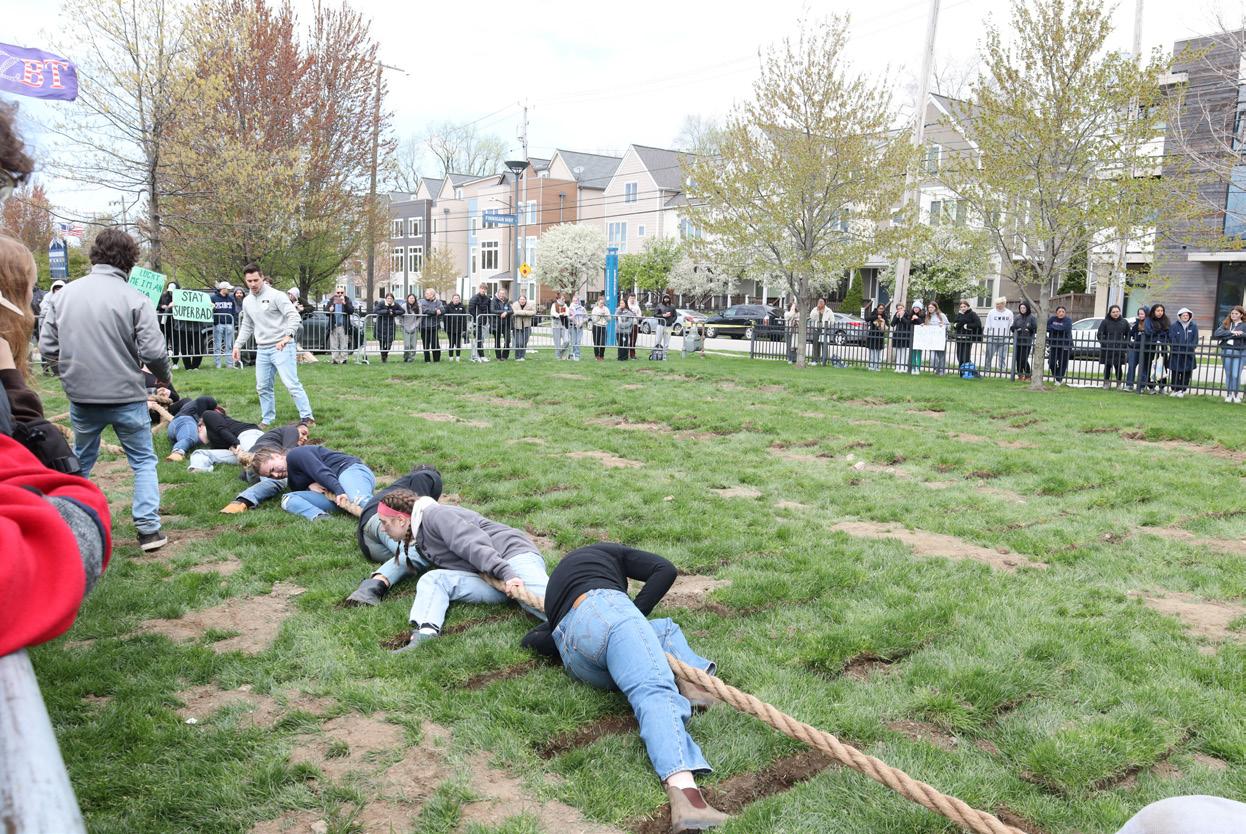
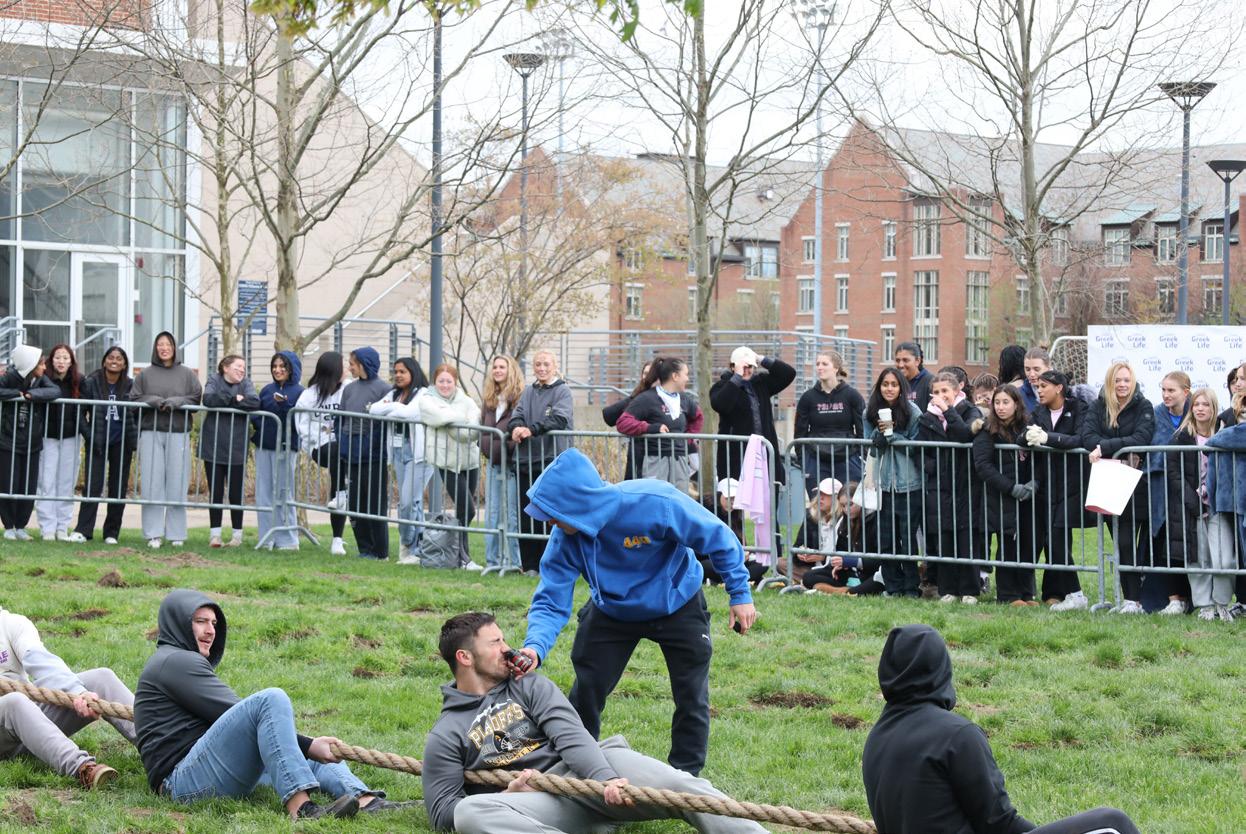


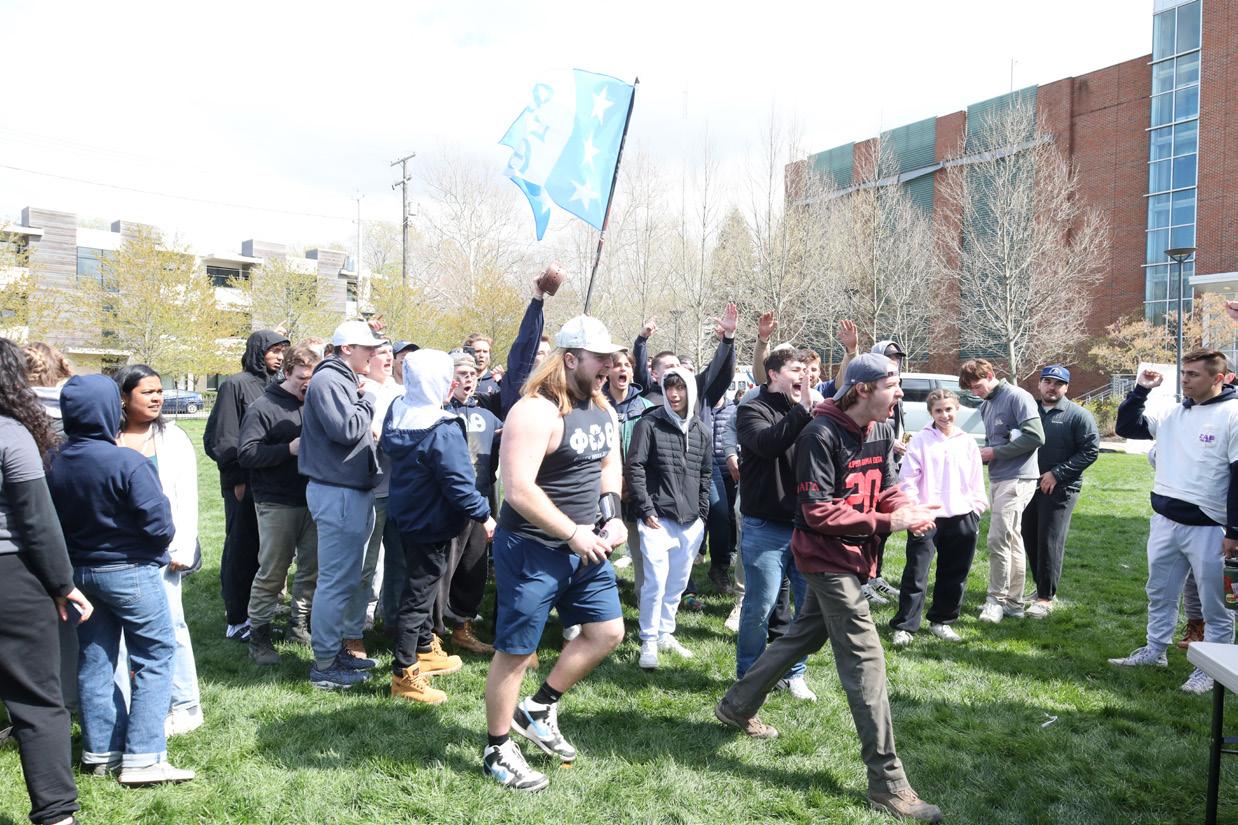
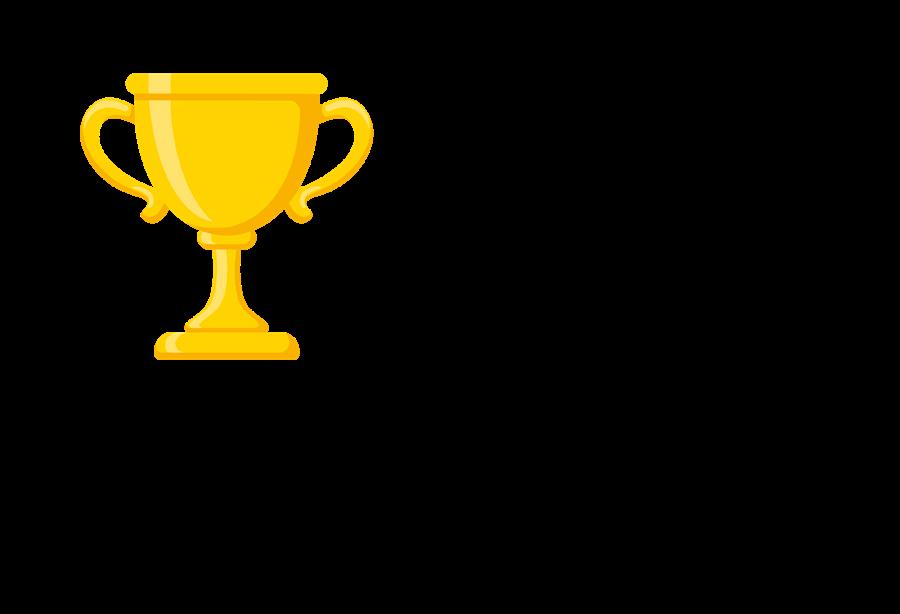

Katharina Staehr Staff Writer
Ah, that first-year college experience. It’s all too familiar from the movies: dads in flannels and baseball caps carrying your brown storage boxes into a musty dorm room while cracking bad jokes, that awkward first encounter with a guy or girl in line behind you at the dining hall and “getting lost and being late” on your first day of classes.
With my first year at Case Western Reserve University coming to a close, it’s time for some muchneeded reflection. At times, I found myself living amidst one of those cheesy “self-discovery,” “new-chapter-of-your-life” college movies, but more often than not, my first year was a treasure trove of experiences—deep friendships, long dining hall conversations, late night cram sessions, university events and frat parties, too. College has changed me as a person and, in retrospect, there is nothing I would have done differently. It began with Discover Week, reminiscent of summer camp, as our orientation leaders herded us from place to place during a jampacked week of activities. Overwhelmed by a tight schedule and the repetitive “What’s your name, major and where are you from?” question, my anticipation for the start of classes was unleashed. Shy and nervous to approach people, I found comfort in the realization that everyone around me was likely feeling the same way, and it is this unspoken awkwardness that formed the basis of our introductions.
As the awkwardness began to wear off and friend groups conglomerated, Leutner Commons morphed from a mere dining hall into a social hangout spot. It’s here I’ve had some of my best, sometimes two-hour long, conversations with my closest friends or people I met mere seconds ago while waiting in line for food. Small talk doesn’t have to be weird. If you go in with the approach of keeping conversation light-hearted and
fun, more often than not, you and the person sitting across from you will find each other cracking jokes, laughing and having a good time. One of the best pieces of advice is this: When you meet a person, have the goal of learning something unique about them. In no time, you will find yourself listening to parts of their family history, their quirky passion or their hometown neighborhood. I realized then that you don’t have to attempt to solve the world’s greatest societal issues for a deep talk with somebody—learning about their values, motivations or upbringing unfurls an intriguing conversational adventure.
Building a life outside of academics has by far been the most rewarding part of my first-year experience. Attending classes naturally forms the cornerstone of my college life, but I’ve learned that non-stop studying isn’t always necessary to achieve successful results. Nor is a low test grade or missed points on a homework assignment the “endall-be-all.” Instead, I’ve started to prioritize spontaneity: a bike ride down to Lake Eerie with a friend or a concert at Severance Hall—reassuring myself with the knowledge that whatever homework still awaits me will get done. That spurof-the-moment attitude has led me to the most memorable experiences here at CWRU. But we don’t even need to go beyond campus to have a good time. Campus events are seemingly infinite, and there is likely a club for whatever passion you may want to pursue. For me, club soccer has not only become a way to balance schoolwork, but to meet upper-class students, connections that may prove beneficial throughout my college journey.
What’s more, it’s here at college that I’ve formed my deepest friendships, people I enjoy spending time with, from those light-hearted, quirky moments at the dining hall to deep evening dorm room chats. Never is there a dull moment, and something in my gut tells me that these are the friendships that will persist long beyond my college years. If there’s something else I’ve learned, it’s that those gut feelings
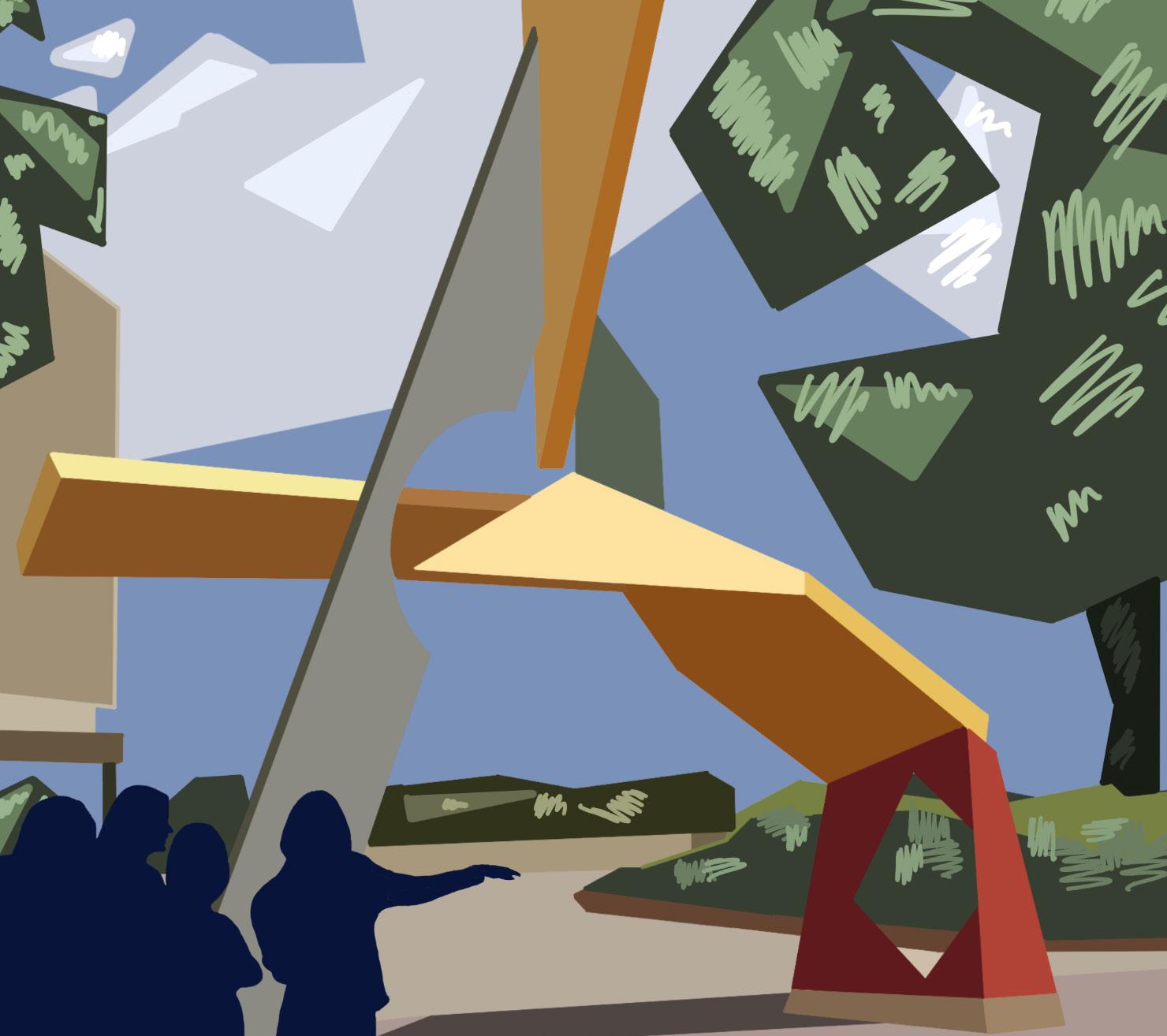
aren’t deceiving.
Yet in all the hustle and bustle of campus life, I’ve realized there is nothing wrong with being alone at times either. In fact, we all need those lazy, “staying-in” weekends to recharge our social battery—being around people all the time can be draining.
Ultimately, as I ruminate on my experiences this past year, I believe the biggest thing I’ve learned is that your college experience is what you make it: the people you choose to surround yourself with, the activi-
ties you choose to engage in, the attitude you choose to approach every day with. College is your blank canvas, and it’s up to you to create, splash some color on and breathe life into it. If you get up every day looking forward to something, no matter how small—dinner with friends, a fun event, meeting somebody new—you will have a more exciting experience. We are the captains of our own ships, and the possibilities of where we can take our journey are near-endless. To the years to come.
Established in 1969 by the undergraduate students of Case Western Reserve University
Shivangi Nanda Executive Editor & Publisher
Elie Aoun Director of Print
Téa Tamburo News Editor
Zachary Treseler News Editor
Kate Gordon Life Editor
Beau Bilinovich Opinion Editor
Puneet Bansal Sports Editor
Darcy Chew Copy Editor
Sarah Karkoff Copy Editor
Sahar Kapasi Copy Editor
Serene Pierce Copy Editor
Hannah Johnson Copy Editor
Lexy Jensen Development Editor
Auden Koetters Director of Design
Clay Preusch Photo Editor
Anjali Bhuthpur Layout Designer
Bowen Zhang Layout Designer
Elizabeth McHugh Layout Designer
Lucas Yang Graphic Designer
Tyler Vu Graphic Designer
DIGITAL MEDIA
Joce Ortiz Director of Digital Media
Noah Henriques Web Editor
Aambar Agarwal Social Media Editor
Shejuti Wahed Social Media Content Creator & Video Editor
Kethan Srinivasan Social Media Content Creator
Khushali Desai Director of Business Operations
Kamila Sattler Sanchez Business Manager
Sophia Ran Distribution Manager
Cayley Ng Distribution Manager
The Observer is the weekly undergraduate student newspaper of Case Western Reserve University. Established in 1969, The Observer reports news affecting students and provides an editorial forum for the university community. Unsigned editorials are typically written by the opinion editor but reflect the majority opinion of the senior editorial staff. Opinion columns are the views of their writers and not necessarily of The Observer staff. For advertising information, contact The Observer via e-mail at observer@case. edu.
LETTERS TO THE EDITOR should be e-mailed to observer@case.edu or submitted on our website at observer.case.edu. Letters can be mailed to Thwing Center 11111 Euclid Avenue, Suite 01, Cleveland, Ohio 44106. For policy and guidelines related to the submission of Letters to the Editor, refer to observer.case.edu/submit-a-letter.
The Observer is a proud member of CWRU’s University Media Board. Follow The Observer on Facebook, Twitter, TikTok and Instagram @cwruobserver.
Editorial Board
email now lives in infamy, a para digm of the administration’s shattered relationship with its student body. Though relations between students and administrators is oftentimes fraught with division and hatred, many students see this email as the start of what would become the loosening of respect. Even today, this relationship is still not fixed. If anything, it has worsened. Just this semester, the administration formally suspended CWRU’s chapter of Students for Justice in Palestine (SJP), an unprecedented decision. The suspension came after the administration suspected that members of SJP glued flyers to surfaces around campus, allegedly causing damage. The student body—having been through these motions before—saw the suspension for what it was: the administration forcing its viewpoints on its students, thus furthering a culture of distrust.
Reading this, you might have
triculate. You’ve probably heard statements from many tour guides and orientation leaders about how good a school CWRU is and how many opportunities it provides its students. Hearing about these momentous issues can be shocking. It’s understandable that you’d feel conflicted.
To be honest, CWRU is an enigma. It is home to some quality educational programs and offers a plethora of research opportunities. If your idea of having fun is watching musicals, writing with a group of people who share that similar interest or taking part in engineering design teams, then you’ll find a lot to love about CWRU. The campus community is full of many talented, bright individuals who are motivated to do as best as they can. CWRU does offer a lot of opportunities for its students—this much is true.
On the other hand, though, the administration seems to be at odds
discontent, apathetic almost. The recent USG elections only saw 600 students vote total during a time when more people need to speak up. For incoming students, however, you are the future of this university. You will determine the direction that CWRU takes going forward. If the administration wants to maintain CWRU’s reputation as a school where academic excellence is a priority, then it must listen to what matters to its students.
To you, incoming students: Don’t be afraid to stand up for what is right. Advocate for those whose voices frequently go unheard. Don’t let the university’s hard-handed decisions keep you down. You are all capable of being the bearers of change in a world that capitalizes off suffering and hatred. Let a new incoming class be a new era for CWRU, one in which peace is paramount, in which all people can feel safe
on campus, one that can carry the
These next four years for all of you will be full of highs and lows,-
self. This is a big torch to carry,vocate every second of your life. You’re allowed to rest and enjoy the college experience as normal. You’re allowed to hang out with friends, attend social events and forget about school every now and then. You’re not a machine. You can only go so far before you wear
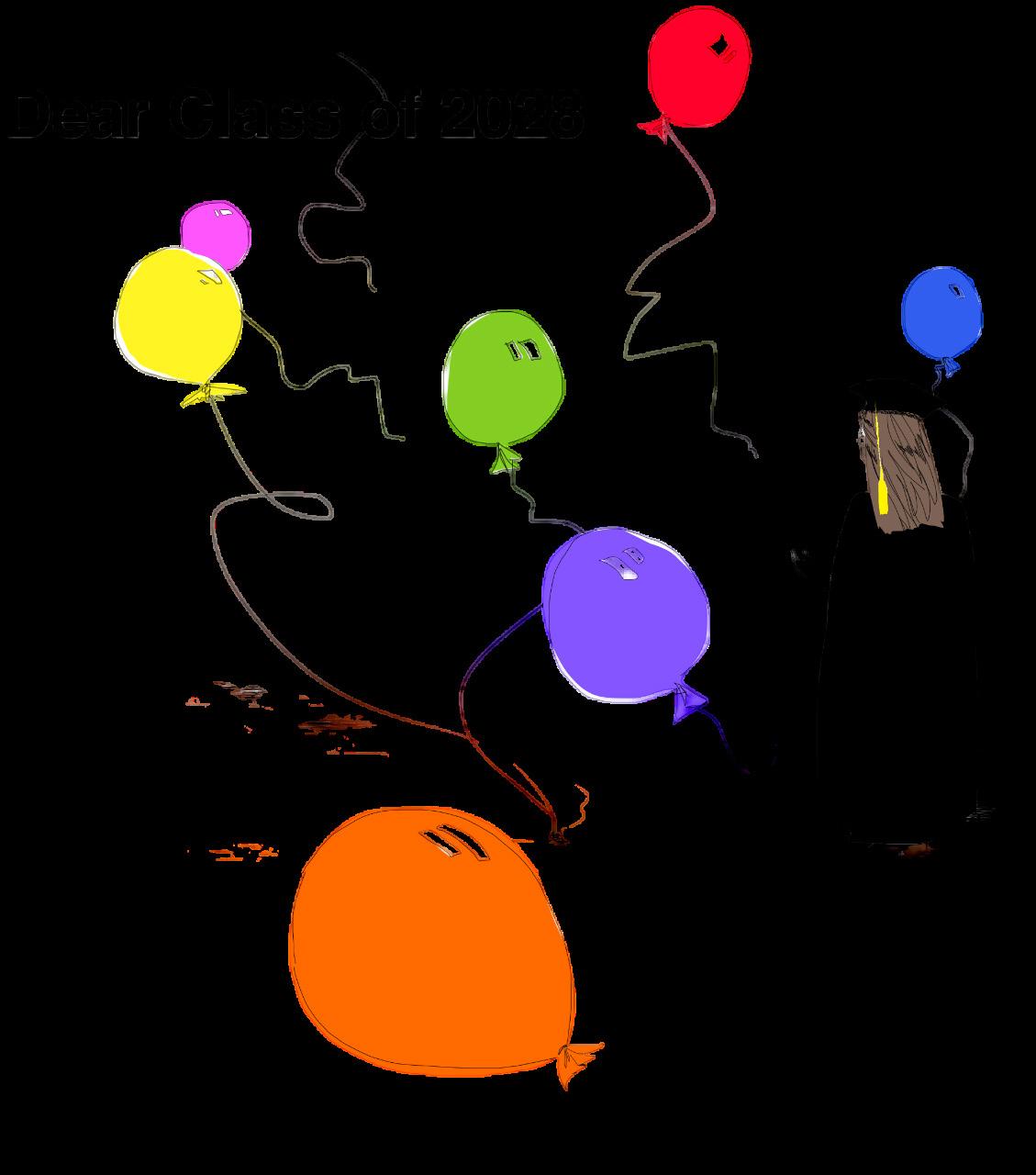
Feel free to explore what CWRU offers. Learn about or join a student organization at the Student Activities Fair at the end of your Discover Week. There truly is a niche for you, no matter what it is. Attend CWRU’s sports games—or join a team yourself. Relax in the traditional CWRU hangout spots such as The Jolly Scholar and the Tinkham Veale University Center. Though CWRU is replete with many problems, that doesn’t mean that your entire college career needs to be mired in distaste. So, Class of 2028, as you transition from being high school students to joining the crazy ride that is college, keep in mind that you are the next generation. You have the power to turn CWRU into what it should be. You are the student body that CWRU will have to represent for the next four years. Take this as a moment to be the change that students have been fighting for for many years. With that power, anything is possible.
Puneet Bansal Sports Editor
“Hi! I’m Puneet Bansal, an incoming freshman, and I would love to know how I could get involved with the newspaper!”
I typed that excitedly from my desk in my childhood room while wearing pajamas and munching on some popcorn. It was the middle of the pandemic, and reaching out and meeting people was already pretty awkward. So I decided to throw myself further into the awkwardness by reaching out to then Executive Editor Nathan Lesch through the CampusGroups chat.
Not joining the school newspaper was one of my regrets from high school. It just didn’t fit into my schedule, but I wasn’t going to let that turn out the same now that I had a second chance. I talked to Nathan and he told me to pick a section to write for, so I immediately jumped at sports. It was the perfect situation: I’d be combining my love for sports with my passion for writing.
I eventually became the sports editor at the end of my first year fall semester. Production Nights became a staple of my schedule and where I met some of my favorite people at Case Western Reserve University. Former Director of Print Sara Khorshidi scared me from the beginning, even through a computer screen. The legend of former Executive Editor Shreyas Banerjee and his four pieces a week of a thousand words each about Star Wars and the latest TV shows and things to do around Cleveland were a sight to behold. The absolute workaholic Nathan trying to navigate the uncharted pandemic waters with relative ease and calm was inspiring.
That spring semester was instrumental in my development as a writer and a person. After never having formally interviewed a person in my life, I got to talk to CWRU alum Bianca Smith less than a month after becoming the first fe-
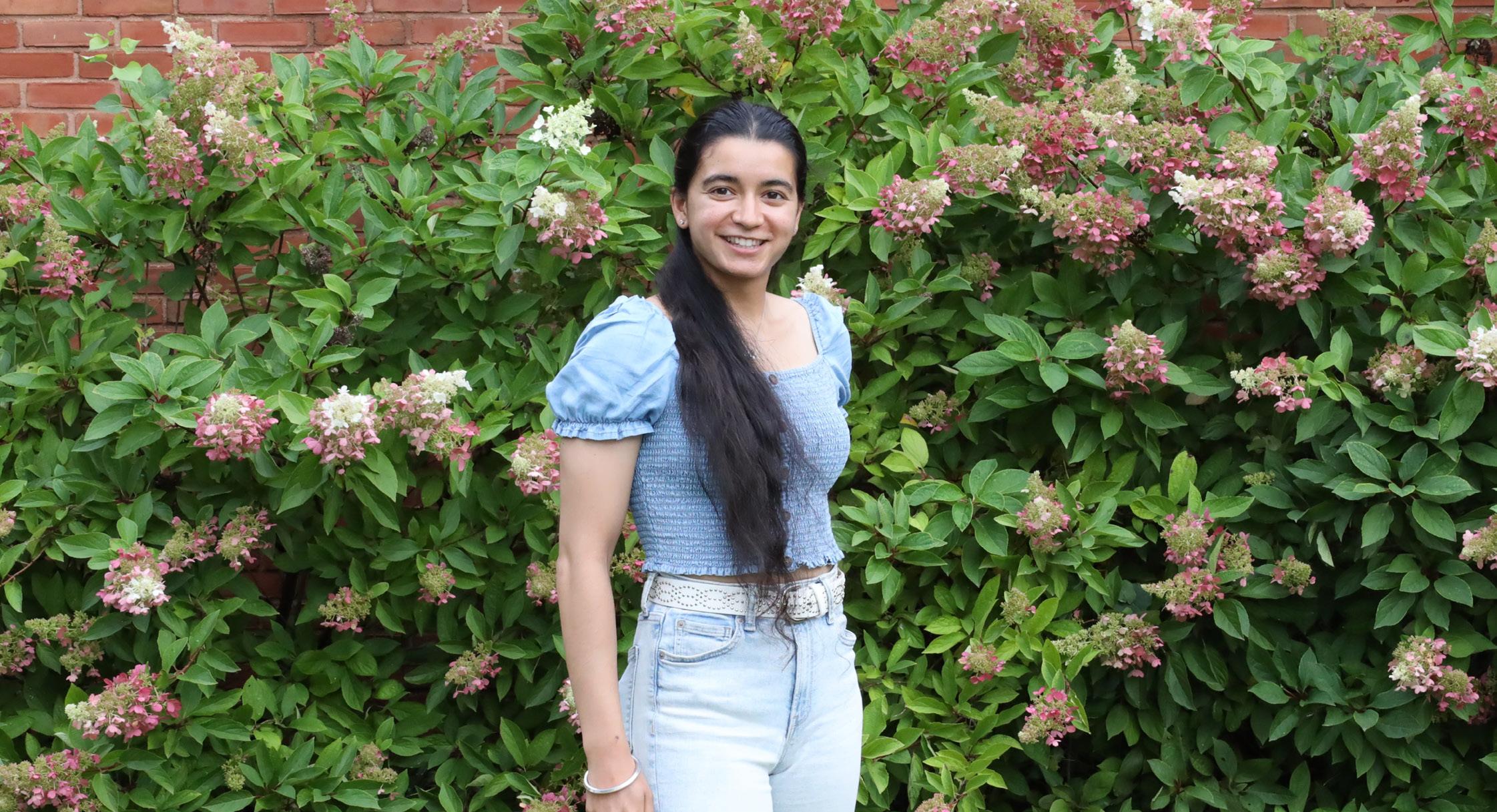
male African American coach in MLB history. That same semester, I had the opportunity to work with another CWRU alum, Mark Termini, a Cleveland-based lawyer and sports agent who engineered LeBron James’ infamous contract to return to Cleveland in 2014. I talked to the men’s basketball team about their shortened season, the women’s tennis team about their latest victories and spotlighted incoming first-year students on the football team. I was more than 2,400 miles away and I was starting to feel closer to Cleveland. Everything changed once I came on campus—or more like everything became so real once I got here. Sitting in person at the bottom of Thwing Center in the lounge-esque University Media Board Office with catered food was literally the only thing I looked forward to for many weeks my second year. And then there are the people. It was amazing, almost humanizing, to see all these peers I looked up to so much during my first couple semesters and meet
them in person. Sara was still scary but had a sarcastic sense of humor that kept everyone laughing every few minutes. Shreyas was always instigating discussions and being forced to defend his hot takes. Everyone on the Editorial Board was always so easy and fun to talk to, creating a relaxed environment that was and still is a relief from the constant stresses of being a CWRU student.
Perhaps my favorite part over the last three years has been seeing how the culture of The Observer has transformed and grown while retaining its core philosophies. We were always an organization made up of driven writers with the ultimate goal of representing the true voices of the student body. But we’ve become more organized, more involved and more present on campus. Our social media page has grown thanks to Director of Digital Media Joce Ortiz and the digital media squad. Director of Design Auden Koetters and Designer Anjali Bhuthpur have been killing it, keeping the designs fresh and
eye-catching. Photo Editor Clay Preusch makes sure those photos always look on point (I still can’t believe he’s a computer science major—it blows my mind every single time). Genuinely a shoutout to the copy editors over the last few years—Dary Chew, Sahar Kapasi, Lexy Jensen to name just a few— who have been making my articles look way better than the occasional dumpster fires they started as. Director of Print Elie Aoun has been a great balancing force, keeping everything in line and making sure this organization continues to run like the well-oiled machine it is— mad respect for continuing Sara’s legacy. And of course, Shivangi Nanda, for being an inspiring executive editor and for elevating our club’s culture and camaraderie. It’s genuinely hard to say goodbye to an organization that has been with me for as long as I have been at CWRU. I will miss the work, the Production Nights, the bonding events and most of all the people. I will always carry The Observer in my heart.
Jessica Kwasny Staff Writer
It feels strange to be writing a farewell piece for The Observer after only having been contributing to it for less than a year. However, I think my late arrival reflects the imperfections of my college journey so far, and I believe those imperfections, hiccups and changes of plans are what make it an interesting story to reflect on.
I entered college with the goal of pursuing science journalism. My plan was to get a background in science with a STEM degree and figure out the journalism portion later on.
I enrolled at Bowdoin College in fall 2020 and tried my best to “get ahead” by loading my schedule with chemistry and biology. However, the combination of isolating COVID-19 restrictions, taking difficult courses over Zoom and not allowing myself to enroll in many non-major classes for the fear of “falling behind” quickly wore me down. At the end of my first year, I trans-
ferred to Case Western Reserve University. I was optimistic about the wide variety of STEM majors offered here, hoping to find one that would feel more meaningful to me than just a box to check. Ultimately, I chose human nutrition, and, looking back, I am not at all surprised by my choice. It is a science that is deeply intertwined with social and cultural factors. Successful nutrition care requires good analytical and communication skills, both verbally and in writing. This isn’t to say that other sciences don’t involve these elements, but nutrition is the one that brought it all together for me. And in doing so, it reminded me of my interest in journalism and writing. As I wrapped up the spring semester of my third year, I decided it was time to stop putting off journalism for later. However, I had trouble figuring out how to crunch it into my schedule without overwhelming myself. I enrolled in a creative writing class, but it wasn’t offered until the spring semester. So, in the meantime, I reached out to The Observer and asked if I could start writ-
ing opinion articles.
Upon receiving “yes” for an answer, I was more nervous than I thought I would be. Submitting my first article was terrifying! I stressed for days trying to think of a topic, wrote and rewrote my draft and when I turned it in, I still felt unsatisfied with it. I cringed when I saw it printed in the paper. I imagined everyone reading it and telling me that maybe I wasn’t cut out for this. Even so, I at least allowed myself the grace of identifying as a beginner. It’s not easy to try new things, and it’s normal to feel uncomfortable. No one was expecting me to be perfect on the first try. Each article was a little easier to write than the previous one. I got into the habit of keeping lists of observations in my day-to-day life to help me come up with article ideas and paid attention to how other people approached writing their articles. There is still so much that I don’t know about what it means to be a good writer or journalist, and I plan to continue pursuing it, both on my own and with formal education.
And now, I at least have a small insight into the field and have a better idea of which questions to ask about it. I am grateful for the opportunities that The Observer gave me to learn and practice writing—even just for a short portion of my time at CWRU. For me, there are two key lessons that emerge from my time as an undergraduate. First—and there are several great Observer articles about this—“getting ahead” is largely a myth. Avoiding journalism in my earlier classes didn’t help me get through a science degree quicker, it just kept me away from a topic that energizes and interests me. Yes, grinding through challenging, boring classes is necessary at times, but sometimes hyperfocusing on one outcome can blind you to other routes to achieve your goal. The second lesson is that it’s never too late to try something new. I was hesitant about joining The Observer as a fourth-year student, but now that I see how much I gained from it in such a short time, I’m glad I didn’t let my late start stop me from trying at all.
Beau Bilinovich Opinion Editor
On May 19 I will graduate. Until I decide to go for a master’s degree, my time as a college student will officially be over. All of the hard work and dedication I’ve put into my college career over these past four years will officially come to an end. It’s a bittersweet feeling.
I first came to Case Western Reserve University as an anxious and unsure kid fresh out of high school. This was a drastic transition in my life; I didn’t know anyone and I didn’t understand my place yet. I remember that first week being confusing, full of this overwhelming sense of feeling lost. I was no longer in the comfort of my home and I had to find my way around in a completely new environment. Add the COVID-19 pandemic into the mix and that first year was one of the roughest transitions I’ve had to go through.
Eventually, though, I did find my way around. I met a group of friends, began to socialize, opened up and discovered a good way to start off college. This was also when I found out that CWRU had a student newspaper, The Observer. I love writing as much as I love science and engineering; creating a story that other people can read— maybe even relate to—is such a fascinating process. Seeing the many thoughts that I have floating around in my head transfer to paper gives me a sense of accomplishment that I think is so essential to being human. In part it’s helped me find my purpose.
Whereas my first year started off uncertain, it ended pretty alright. I discovered a club and friends that reflect who I am as a person. Though, admittedly, I’m not a fan of the first articles I wrote for The Observer. They were too long—my first piece was over 2,000 words! (sorry about that one)—and focused on topics that I no longer have an interest in writing about. But that’s part of this weird, often strange experiment called life: You don’t know everything at first, and it looks like a dark, scary forest. Bit by bit, however, you meander your way through the woods. You might be spooked by sounds you hear in the distance, but it’s nothing to worry about. It’s just an animal also trying to find its way through.
My second year is when I joined the Editorial Board as development editor. The Opinion Editor during my first year, Jordan Reif, recommended that I apply, and so I interviewed with former Executive Editor Nathan Lesch and got the position. I was excited. I had been wanting to go further with my passion for writing—joining the production team seemed like the perfect choice.
I was also nervous. I never worked on a newspaper before. I was surrounded by a group of people who knew everything there was to know about the production process. But I still loved it and wanted to stay. I met a bunch of really cool people—Shreyas Banerjee, Sara Khorshidi and Karuna Lakhiani to name a few. It was nice to share a similar interest with everyone, even if I was shy at first. I would warm up, though.
My second year is where I met some of my closest friends at CWRU. I met my roommates, Niels, Aaron, Kim, Dimitri and JD—whom I actually went to high school with. I started talking to
some of the people in my engineering classes and finally became acquainted with them. I learned the ins and outs of college life; it was a fun time. I can remember some of the fun moments we had: watching “Monty Python and the Holy Grail,” buying a life-size cardboard cutout of Al Gore, throwing mustard packets all around the dorm room and staining one of my favorite shirts. Despite the lackluster housing arrangements and the prison cell-like rooms, I had a fun time.
The Observer also underwent a few changes. Shreyas took over as executive editor when Nathan left and the arts and entertainment section became the life section. This was the Editorial Board that I grew up alongside with, and it was fascinating to see it change. We published pieces on CWRU’s infamous housing debacle in the spring of 2022, and I even published a piece on how CWRU falls short. I like to think these were little baby steps toward making the paper more focused on CWRU life. Witnessing it all unfold made me want to take on more responsibility. I had fallen in love with student journalism even more.
My third year was all over the place. I moved back to North Side in The Village at 115th. I got a fourperson apartment with Niels, Aaron and JD. I started to take more classes directly related to aerospace engineering. My college education was halfway over. I changed quite a lot over those first two years, but I would soon learn that my personal growth was not done yet.
The year started off normally, but toward the end of the fall 2022 semester my life suddenly changed. I went through a major loss, one whose effects are still evident even now. I was shocked, confused, unable to do even the most basic of things. The rest of the year is a blur to me. It’s hard to remember what I did when most of that year was spent in grief. This isn’t to say that the entire time was bad—I went to my very first concert that September to see The Black Keys—but it was difficult in a way that I wasn’t familiar with.
One thing that did stay constant, however, was the paper. I remember the week before I suffered the major loss: President Eric Kaler sent out his email to the entire student body admonishing them for the passage of the Undergraduate Student Government’s (USG) divestment bill. We published an editorial in criticism of Kaler’s statement, one of my favorites, aside from our recent piece on the Students for Justice in Palestine suspension, my personal favorite. Even during this difficult time in my life I still found a reason to keep going.
The following spring semester I changed my focus in my opinion writing. Owing to the mental health challenges I was going through, my articles reflected various mental health topics. My first article back, “The small steps matter, too,” was about the importance of taking on challenges one piece at a time. It was cathartic—writing on the challenges I was experiencing allowed me an outlet to reflect.
As hard as those months were for me, I think I grew the most as a person. Losing a few people that I loved made me realize how essential close relationships are. I am forever grateful for my family and friends for getting me past a dark period in my life. My roommates were a saving grace; they helped me keep my head up when sometimes I felt like keeping it down. I’m grateful for Kim for sticking by my side. She’s been a major guiding force for me this past year. They’ve all shown me what true, honest friendships are about. As a result, I’ve become more confident and have realized how capable I actually am. I’ve been through so much in just one year, and I still stuck through with it till the very end.
Now, I’m a fourth-year student on the cusp of graduation. I’m the opinion editor, taking on Karuna’s tradition of writing editorials at the last minute. My final year has been filled with a lot of excitement and anticipation for the next chapter of my life. It’s also been an opportunity for me to expand on the lessons I’ve learned. I’ve been opening up
more, trying out new experiences— such as going clubbing—and building better relationships with the people on the Editorial Board.
Amidst the stress of my final year from my senior design project, the paper has been a nice refreshing time of peace. I can take a break from the technical work of my classes and devote time to write editorials and edit for the opinion section. I’ve enjoyed our social events, such as The Big Bounce America event last semester and our recent trip to Tabletop Board Game Cafe in Ohio City. All of the laughs and fun moments have helped give me a good end to my time in college.
I’m grateful for everyone on the Editorial Board, for all of the bright and motivated people I’ve met. Despite the many directions that my life has taken, the paper has been one of the things that’s been a constant. Every Wednesday at 5:30 p.m. I can count on all of us being together at the University Media Board Office putting together the paper. I’ll cherish those moments for a long time I’m sure.
As much as I’ve had to say, it’s difficult to find the right way to say goodbye. I have so many fond memories of my time at CWRU and on the paper. Being on the Editorial Board with people such as Shivangi Nanda, our executive editor, Joce Ortiz, our director of digital media or Noah Henriques, our web editor, has kept me going. I’ll cherish the memories I’ve made with everyone, from the print team, digital media team, business team and design team, and I hope that in 10 or 20 years I can look back on these four years as the fun moments they are. I hope that I can make that same impact on others, too. It’s one of the reasons I became the opinion editor.
I’ll miss these years, as difficult as they have sometimes been. I know that in this next chapter of my life I’ll have many more obstacles to overcome and transitions to get through—but I’ve been through it all before, and I can do it again. If there’s any way to summarize what I’ve learned about my purpose, it’s that. Just keep going, no matter what.
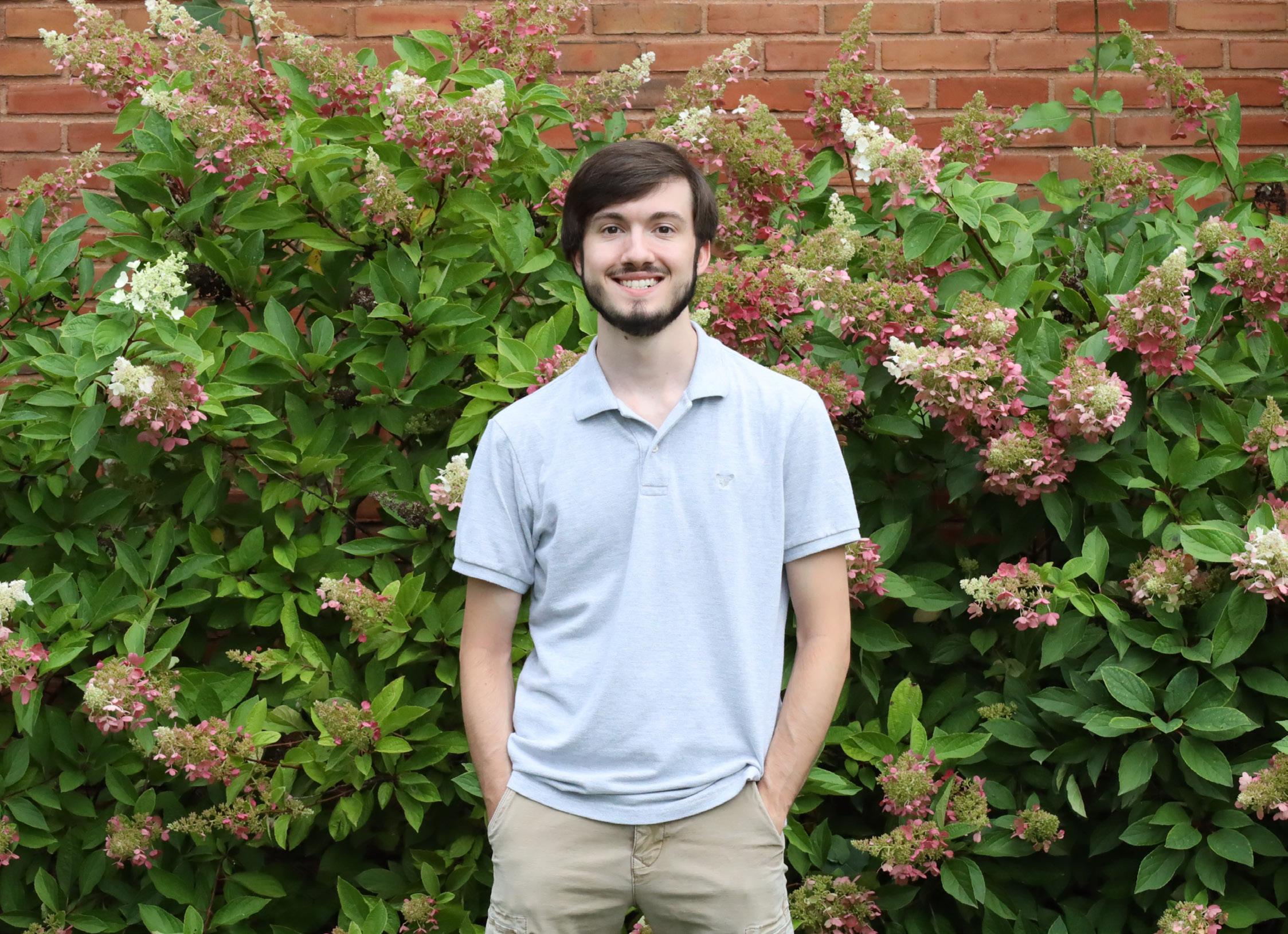
Lexy Jensen Development Editor
It has been a difficult academic year for many of us. As a student of both Case Western Reserve University and the Cleveland Institute of Music, there have been a number of times throughout this year in which I’ve felt that neither of the institutions I will be receiving a degree from in May have been particularly conducive learning environments and have further failed to support my studies fully. I find some solace in the fact that, despite the challenges, I have found a community with The Observer that reports on these issues while highlighting the impact on students, calling for change within these institutions we pay to attend that are meant to provide a safe space to learn and grow for everyone.
I am not blind to the coverage both institutions have received from national and even international news outlets, but the one thing they seem to be lacking in comparison is first-hand experience. There is nothing more telling than the students of an institution reporting on its wrongdoing and pleading for administrators to fix it for the well-being of the student body as a whole. I am grateful that the respective situations at CWRU and CIM have been receiving wide coverage that calls attention to the lack of support for its students; however, I believe that first-person accounts of these internal issues are just as important for the Cleveland community and beyond to be listening to.
I have never much liked writing,
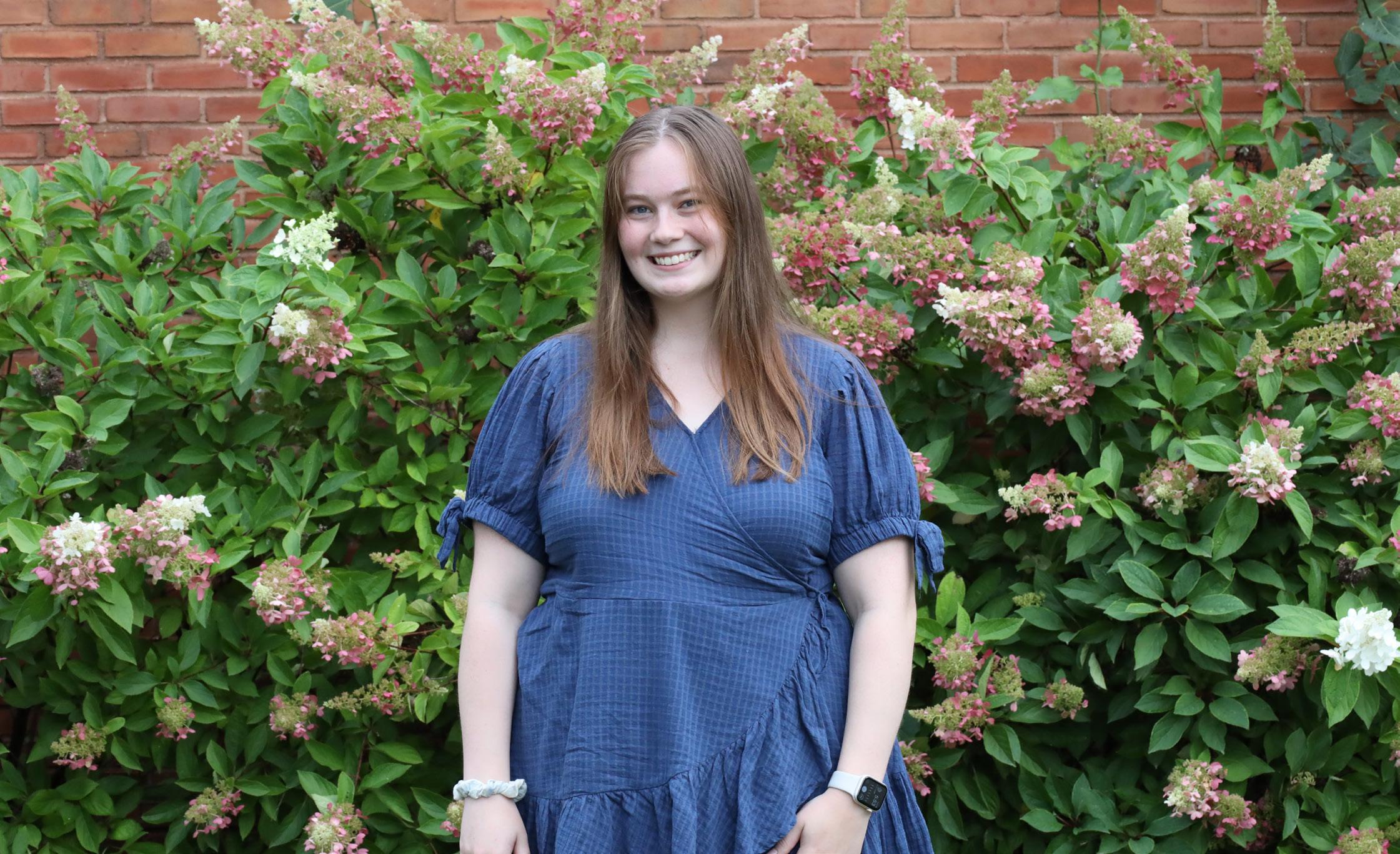
but I found a call to action to do so with the initial Title IX incident at CIM. Since then, I have continued writing about the disconnect between the student body and administration. I am now about to graduate at a time when none of these issues seem resolved, and student protests seem a permanent fixture of every orchestra concert. CWRU is in a similar situation, where the administration seems to continue to disregard student voices and adhere to their own agenda seemingly without regarding these concerns.
It is my sincere hope that student perspectives continue to be promoted in publications such as The Observer, until the administration finally begins to listen before they have no students left to listen to.
Despite its challenges, however, this year has also been immensely fun, and my role in The Observer was no small part of that. Working with a group of students who care equally about projecting student voices has been nothing short of empowering. This fall, I will be continuing my education at the
Khushali Desai Director of Business Operations
To assess the impact The Observer has had on my collegiate career and self would almost be a Herculean task. It’s touched almost every part of my life for the past two years, and without it, I probably wouldn’t have gotten my post-graduation job, made so many friends or had as many fun and unique experiences as I did.
Joining the student newspaper on campus had been a dream of mine since I started at this university. But I always found writing intimidating and didn’t know at the time I could do other things for the paper, so I shelved that dream and explored other pursuits. Then two years ago, I was approached with the perfect opportunity: conduct business operations (my specialty) for the organization I held in such high regard. With no recent predecessor, I set out to reforge relation-
ships with community partners and university administrators and innovate processes, and the work was much of what I expected. What I did not expect were the strong bonds I would form with my fellow Editorial Board members. They quickly became the people I would let know first if I witnessed something crazy on campus or if I heard of any cool events we should go to in Cleveland or on campus. Their candor, humor and genuine love and encouragement made every grueling spread-
University of Southern California pursuing a Master of Music in Vocal Arts, but I anticipate my work in news and editing to continue based on my experiences here. I look forward to seeing what The Observer, and more generally the students of CWRU and CIM, will accomplish in a time of such turmoil, and am confident that the future of both of these institutions will be bright if the administration will listen to the student voices we have been working so tirelessly to give a platform to.
sheet worth it. Saying goodbye is always hard, and it’s even harder when it’s something you’ve poured so much time, effort and love into. But I’m looking forward to experiencing life’s next adventures and exploring a new chapter, and I’m excited to see what will come next for The Observer in business and beyond. Even with my college career coming to an end, it’s comforting to know that The Observer will continue to observe and report long after I leave.

Berry and third-year Isabella Russo each recorded 2 hits for the game. Potts and Russo both drove in 2 runs each, and Gross added 2 walks.
The Case Western Reserve University softball team regained their stride this past weekend. After losing to Washington University in St. Louis 1-3, the Spartans swept Brandeis University from April 19-21 in dominant fashion, igniting a four-game win streak as they head into the final stretch of the regular season. The Spartans stand at 28-5 overall and 13-3 in the UAA.
The Spartans owned Game 1 on April 19 from the start, winning 6-2 after holding Brandeis scoreless for six innings. The real hero of the game was third-year pitcher Lexi Miskey. She earned her 54th career win and became the second player in program history to strike out 500 batters in the fourth inning. She is 31 strikeouts behind former Spartan Ruth Sagartz for the record. For the season, Miskey stands at 15-3 with 134 strikeouts and an ERA of 1.90.
First-year Karen Potts, fourth-year KaiLi Gross, second-year Elizabeth
Riding the momentum, the Spartans came out swinging for the history books in the second game. In the absolutely crushing 14-3 win in six innings, CWRU set the single-game program record in hits with 20, surpassing the previous record of 19 set in March of 2021 against Kenyon College. 7 of the 20 hits were doubles, which is the second most in a single game in history.
The 14 runs tied the season high with Berry, Potts, fourth-year Stevie Rieger and third-year Katelyn Lamm each recording multiple hits.
Berry matched the program record with 5 hits in five attempts, equaling the record set by Lindsey Robinson in 2016. Potts recorded a solo home run in the final inning, her second of the opening day of the series. Third-year pitcher Kylie Hosey earned the win to improve to 11-2 on the season, allowing 2 earned runs with 3 strikeouts in five innings. Fourth-year Jenna Jaklich finished the contest after pitching almost two scoreless, hitless innings.
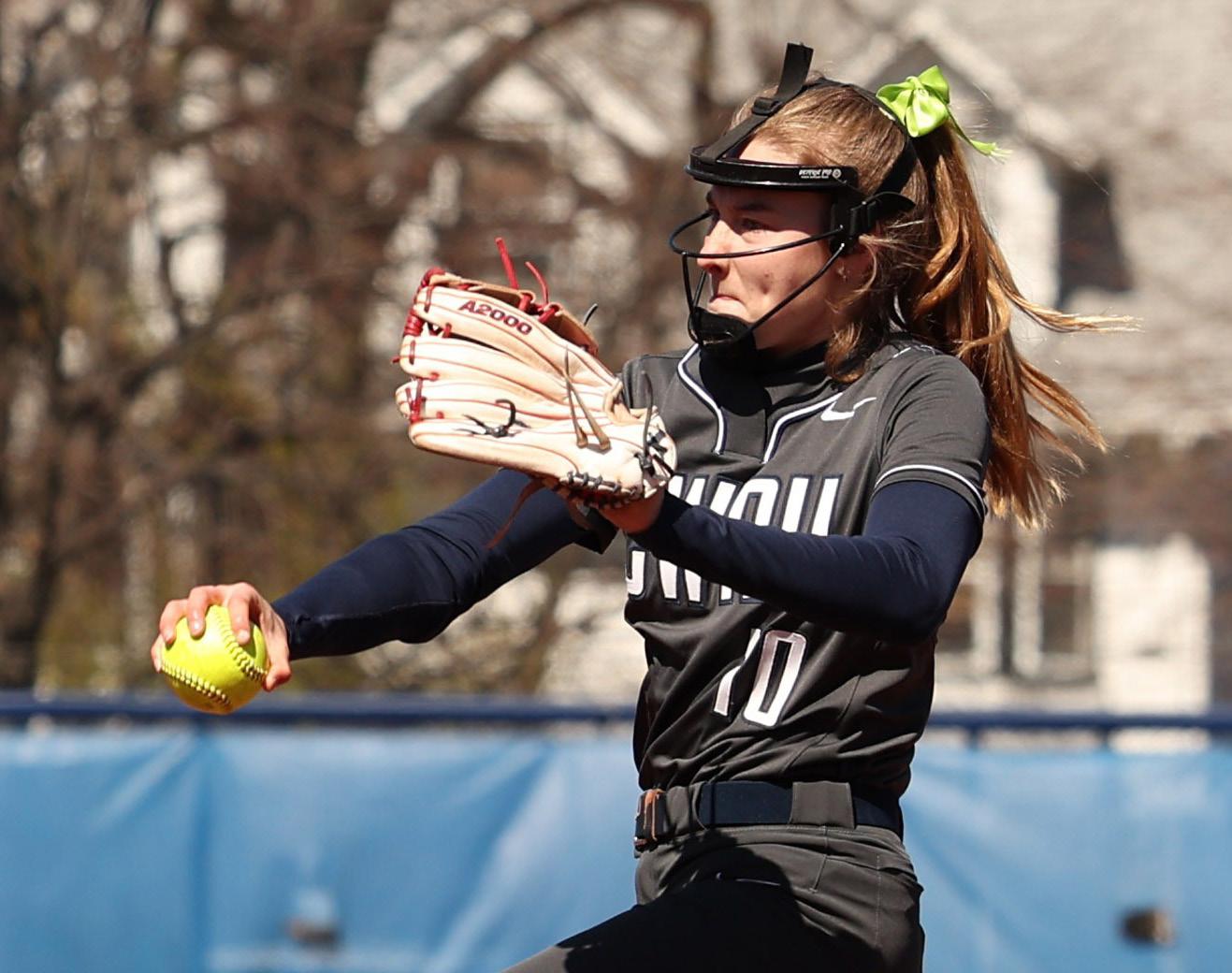
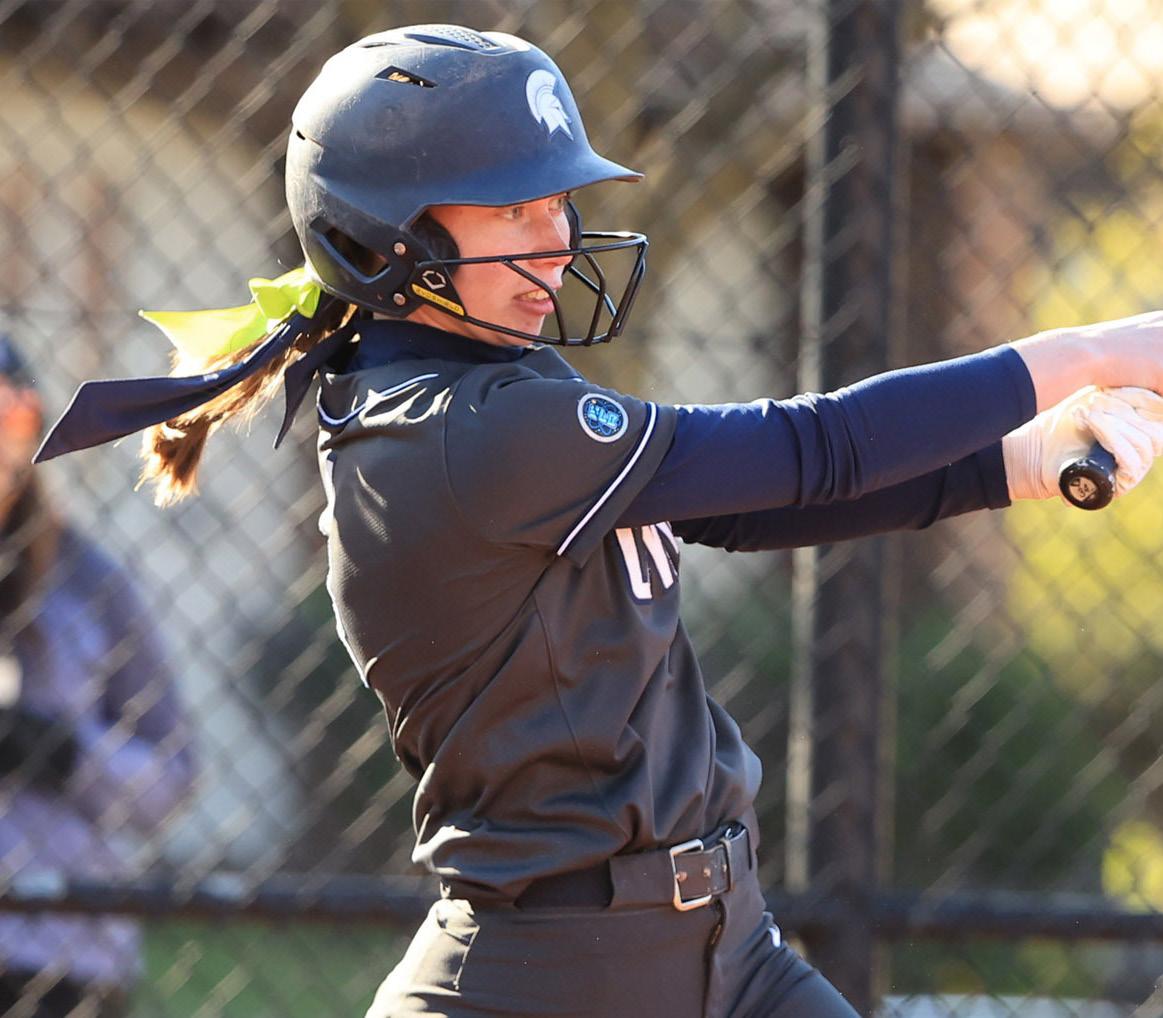
The scoring rampage continued in Game 3 as the Spartans scored in all five innings for the 14-1 victory. Back-to-back doubles in the first inning from Potts and Gross earned the first run. Russo then drove in Gross with a single for the 2-0 lead. With bases loaded in the second, Gross’s sacrifice fly drove in her second run of the game followed by a double from Rieger to push the lead to 5-0. Russo then scored on a one-out single from fourth-year Jordon Manworren before Gross’ first triple of the season plated three runners for the 9-0 advantage.
After the Judges scored their only run of the game off a solo home run, the Spartans kicked off the fourth inning with a run-scoring single from second-year Tara Fritscher, her first hit and RBI of the season. Manworren’s double drove in two more runners while first-year Nylah Durham’s run-scoring single pushed the lead to 13-1. Berry’s sacrifice fly in the fifth drove in the 14th and final run of the game.
The Judges put up more of a fight in the final game of the series, but CWRU still took the game 8-4. In the first inning, Gross scored on a single by Rieger. Rieger then stole second and scored following a double from Berry. Brandeis tied the game in the bottom of the first. Then in the fourth, the Spartans broke the tie with a run from Durham, who scored on a firstand-third stolen base by fourth-year Kela Jagoda.
Following a couple more runs, the score stood at 6-3 heading into the last inning. Lamm hit a two-out single to plate Russo and Berry. The Judges got one final run in before the game ended 8-4. Miskey earned the win after giving up 1 run and 3 hits while recording 7 strikeouts.
The Spartans will host seven more games to finish the season, all at home in Mather Park. They will play Carnegie Mellon University from April 2628 in a four-game series. The University of Mount Union will visit on May 5. The University of Chicago will play two games against CWRU on May 11.
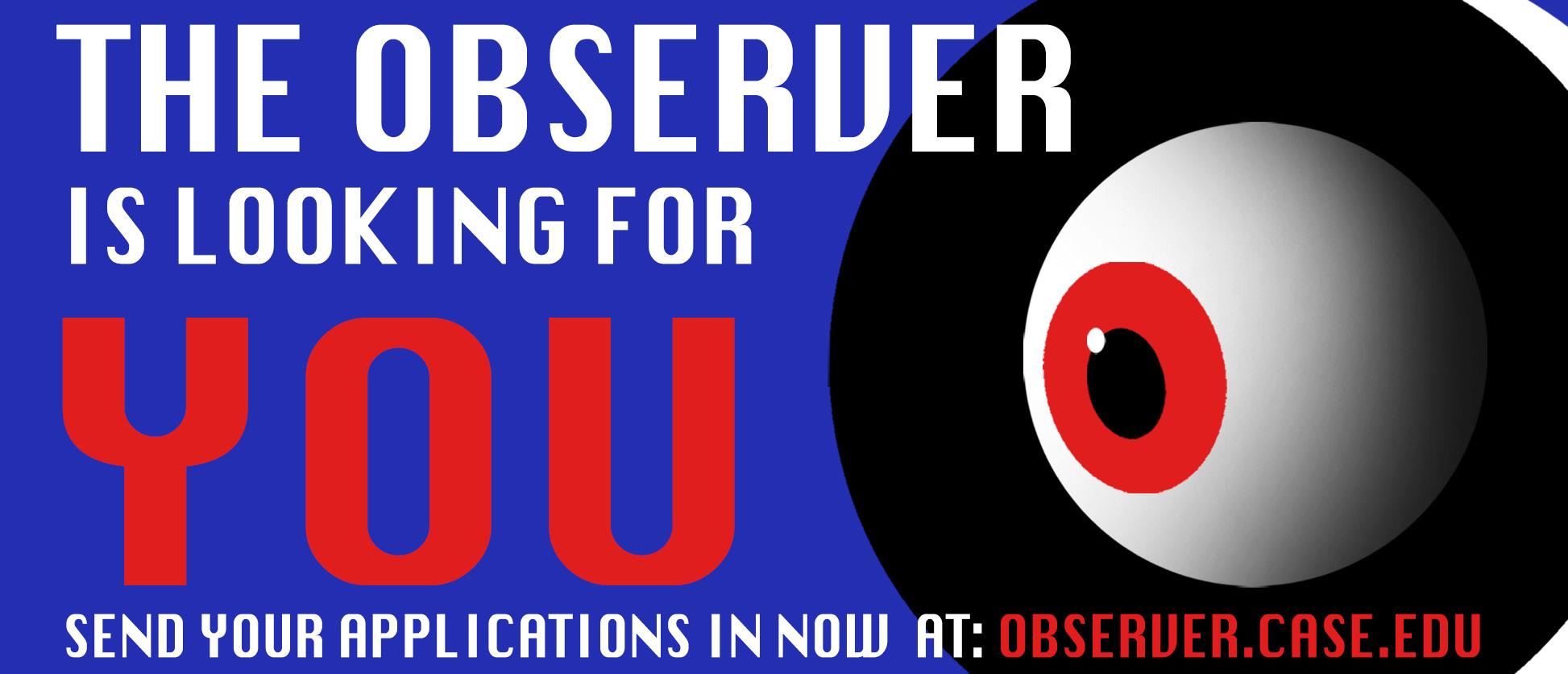
Darcy Chew
Copy Editor
This past weekend, Case Western Reserve University’s No. 4-ranked men’s tennis team played against three different schools including No. 5-ranked Denison University and No. 25-ranked Carnegie Mellon University to wrap up their regular season.
The Spartans began with a 9 a.m. game against Kalamazoo College where they swept the Hornets, 9-0 for their fourth consecutive sweep.
Graduate students Diego Maza and Michael Sutanto finished first beating the Kalamazoo pair 8-0 in third doubles. Their win was followed by fourth-years Daniel French and Yuvraj Narang taking a 8-2 victory in second doubles. The doubles matches finished with fourth-year first doubles pair Vishwa Aduru and Sahil Dayal bringing the CWRU lead to 3-0 with an 8-6 win.
After the doubles matches, firstyear Santiago Salazar Garcia and second-year Rohan Bhat’s 6-2, 6-0 and 6-0, 6-1 wins in the second and fifth singles, respectively, solidified the team’s win against Kalamazoo. The remaining singles matches played by third-year Ben Martin, first-year Derek Shiffer, first-year George Kosseifi and second-year Matthew Plunkett contributed to the Spartans’ sweep of Kalamazoo.
After a successful morning, the team went on into their Denison matches with high hopes to crush their regional rival.
Despite Denison’s early lead from third doubles, the Spartans pulled ahead with the remaining doubles matches. Aduru and Maza won 8-3 at first doubles and Dayal and second-year Anmay Devaraj at 8-4 at second doubles. The Spartans went into singles play 2-1.
Sutanto won the first singles match 6-2, 6-0 at third singles, followed by Maza adding a 7-5, 6-3 win at fifth singles. After Denison
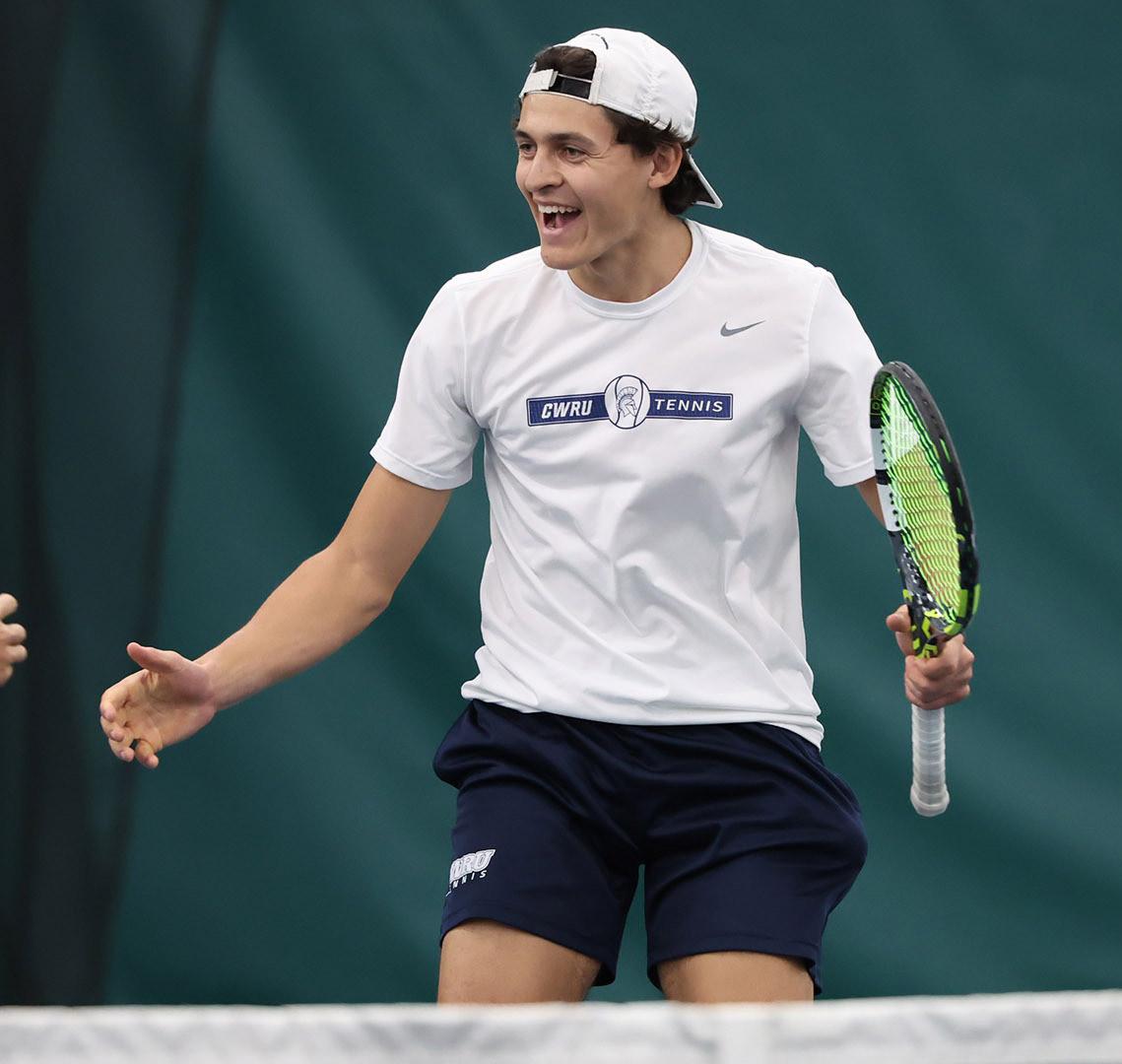
took second singles, the Spartans clinched the victory with a 7-5, 6-4 win by third-year Casey Hishinuma in fourth singles. After the contest was decided, third-year Ajay Mahenthiran and Devaraj both added three-set wins with Mahenthiran taking first singles 4-6, 6-3, 6-4 and Devaraj taking sixth singles 3-6, 6-4, 6-2. The Spartans defeated Denison 7-2.
Second-year Jackson Schuetzle commented that this was the team’s most rewarding win this past weekend, “I think our Denison match was definitely a huge statement. There were a lot of matches that were super close and watching the entire time, it literally was like a war
on the court.”
Besides celebrating putting an end to Denison’s eight-match win streak, the Spartans also recognized four fourth-year players Aduru, Dayal, French and Narang as part of Friday’s Senior Day for the team.
All four players were part of the team as they went to NCAA Division III Championships the past three years and were part of CWRU’s historic NCAA Team Championship win last year.
Dayal shared his thoughts on the remainder of the season. “It’s a tough reality that this is my last season and weeks of college tennis, and I am trying to do everything I can to cherish these final moments.” Dayal
continues, “We are all competing our hardest and leaving everything out on the court. The team has high goals for the remainder of the season, but we are taking each match one by one. We are all excited for this post season and can’t wait to see what this year’s team can accomplish.”
The following day, the Spartans traveled to Pittsburgh to face off against Carnegie Mellon. The afternoon started strong with Aduru and Maza winning first doubles 8-1. However, the next two matches were closer with Carnegie Mellon winning the third doubles to tie the score 1-1, but the second doubles pair Dayal and Devaraj won the tiebreaker 8-7 (1) putting CWRU ahead.
In the singles play, Carnegie Mellon once again tied the score with a win in first singles. However, the Spartans were able to clinch the victory from three straight wins made by Aduru, Hishinuma and Sutanto with 7-5, 6-1 at second singles, 1-6, 6-2, 6-2 fifth singles and 7-6 (5), 6-2 third singles, respectively. After the victory was secured, Maza also contributed to CWRU’s final score of 6-3 against the Tartans with a 6-2, 7-6 (8) win at sixth singles.
With these three wins, the men’s tennis team have improved 23-4 and extended their win-streak to 10.
“I think going into the conference championships on Wednesday, we’re well equipped with the skills we’ve been working on since a couple of losses we took early in the fall, but I think we found our identity and we’re extremely excited to go into this postseason,” Devaraj commented.
The Spartans began the UAA Championship Tournament on April 25 and will compete through the rest of the weekend in Altamonte Springs, Florida. They will get a couple weeks off before competing in the first rounds of the 2024 NCAA DIII Championships from May 10-12.
CWRU at NYU (4/19-21)
Game 1 - L 10-13
Game 2 - W 12-7
Game 3 - W 3-1
Game 4 - W 10-5
CWRU vs WashU (4/26-28) - 4 games (Nobby’s Ballpark)
CWRU at 54th Sparky Adams Invitational (4/19-20)
Men’s team: 3rd of 12 teams (102 points)
Women’s team: 4th of 16 teams (83 points)
CWRU at UAA Outdoor Championships (4/27-28)
CWRU vs Kalamazoo (4/19) - W 9-0
CWRU vs Denison (4/19) - W 7-2
CWRU at Carnegie Mellon (4/20) - W 6-3
UAA Championship (4/25-27)
CWRU vs Rochester (4/25)
CWRU at Brandeis (4/19-21)
Game 1 - W 6-2
Game 2 - W 14-3
Game 3 - W 14-1
Game 4 - W 8-4
CWRU vs Carnegie Mellon (4/26-28) - 4 games (Mather Park)
CWRU at UChicago (4/19) - L 1-8
CWRU at North Central (4/20) - W 5-0
UAA Championship (4/26-28)
CWRU vs Carnegie Mellon (4/26)